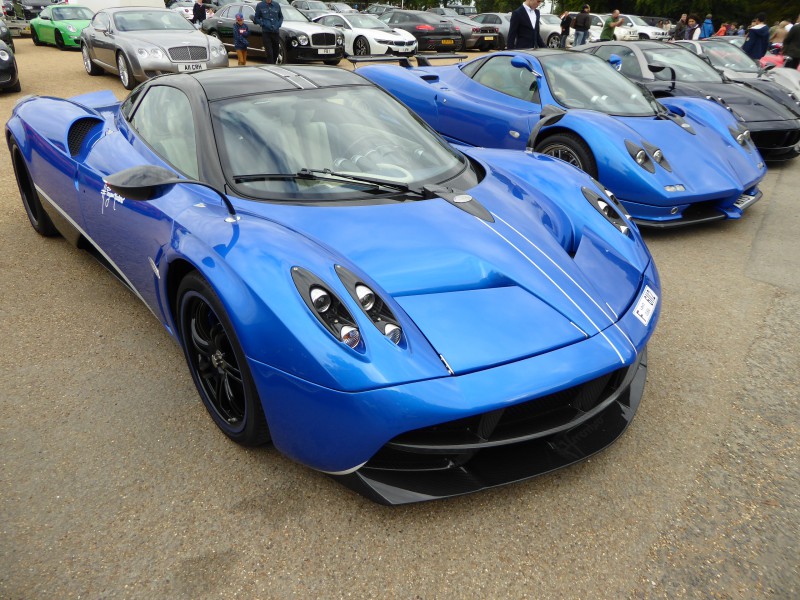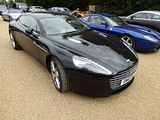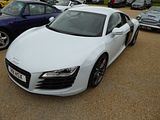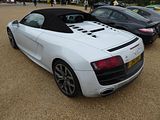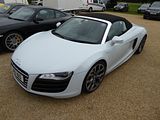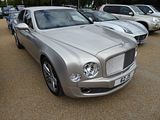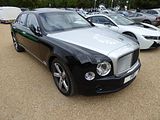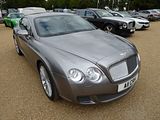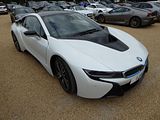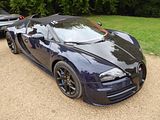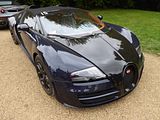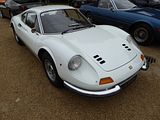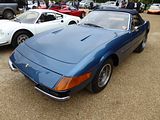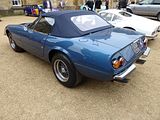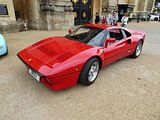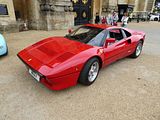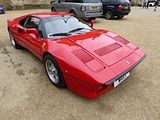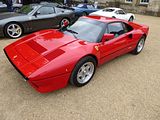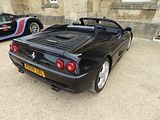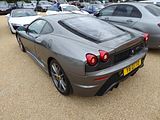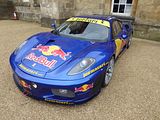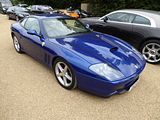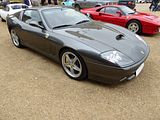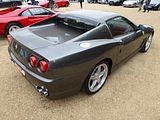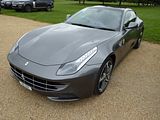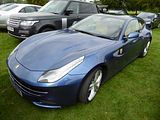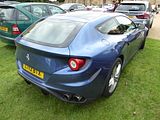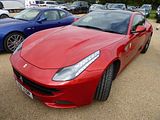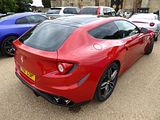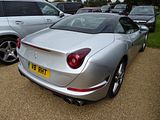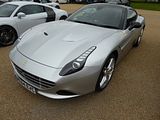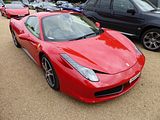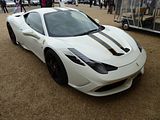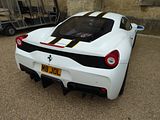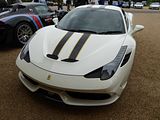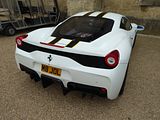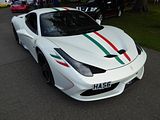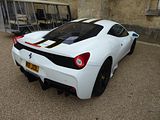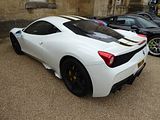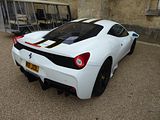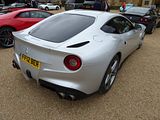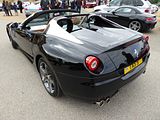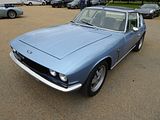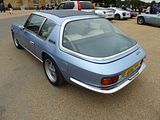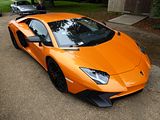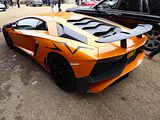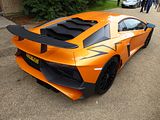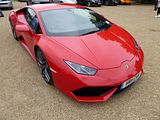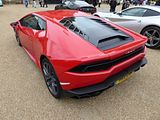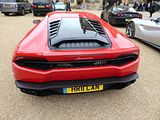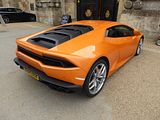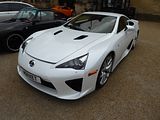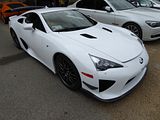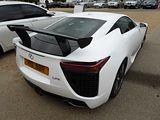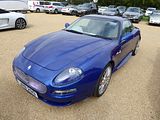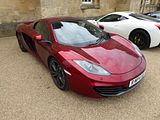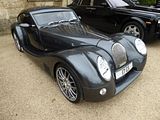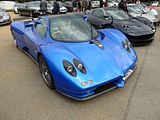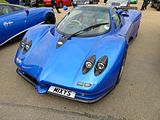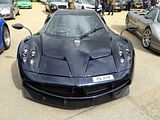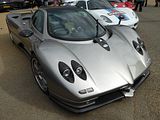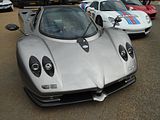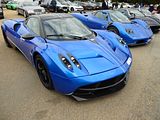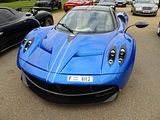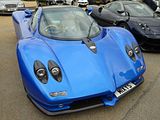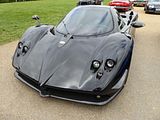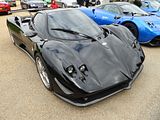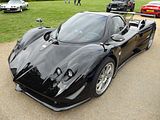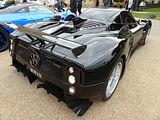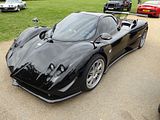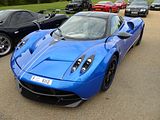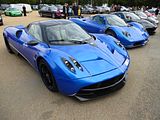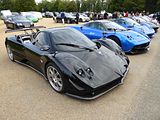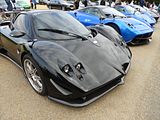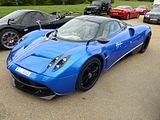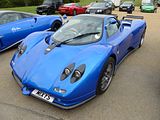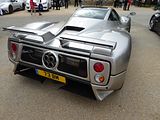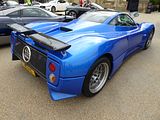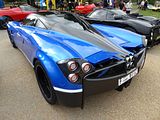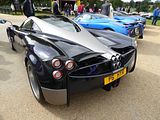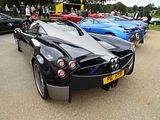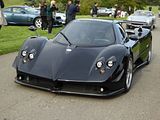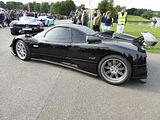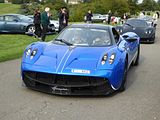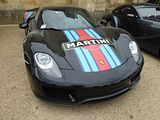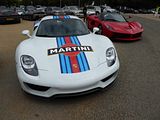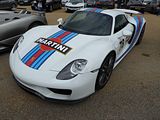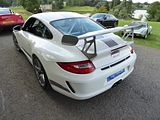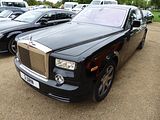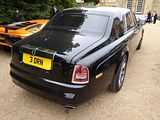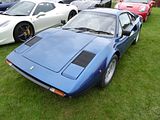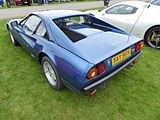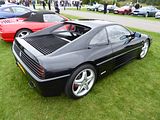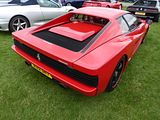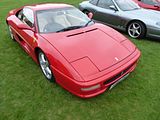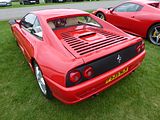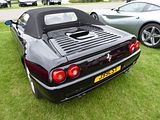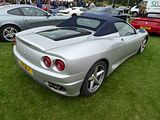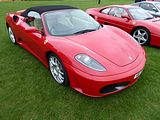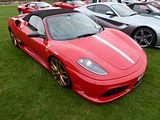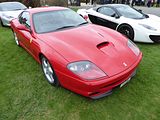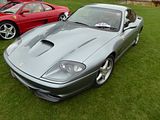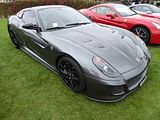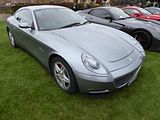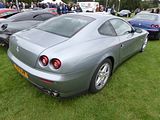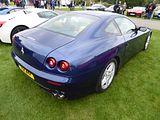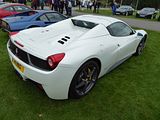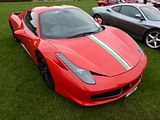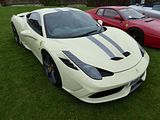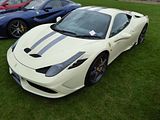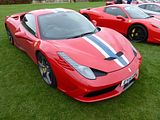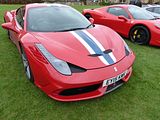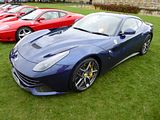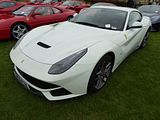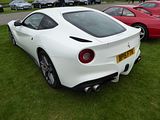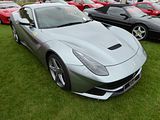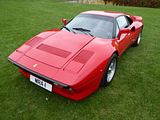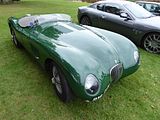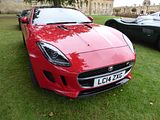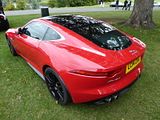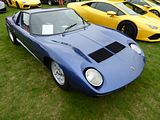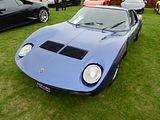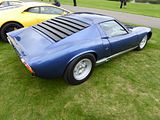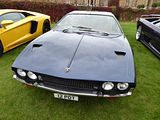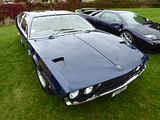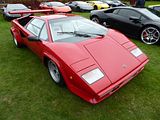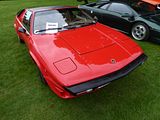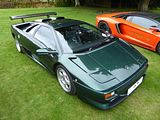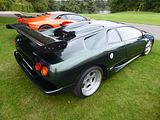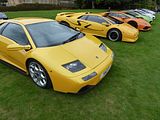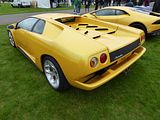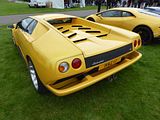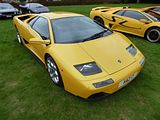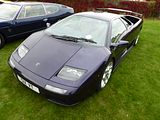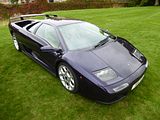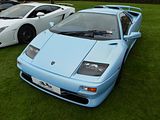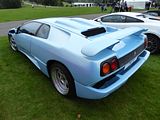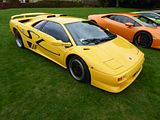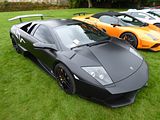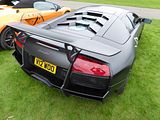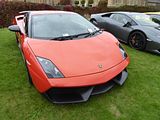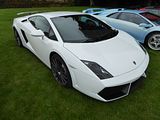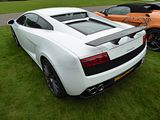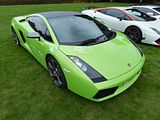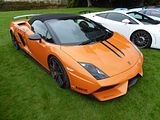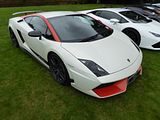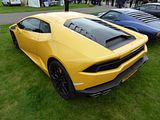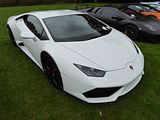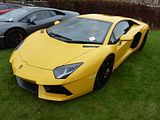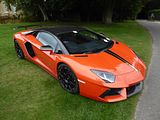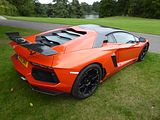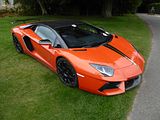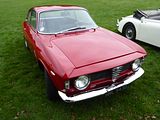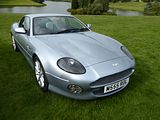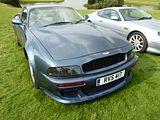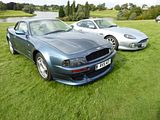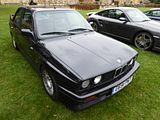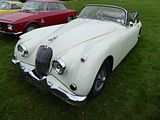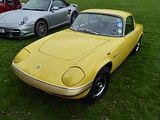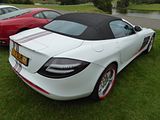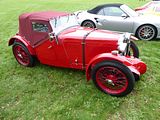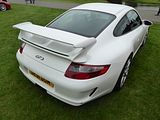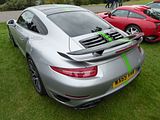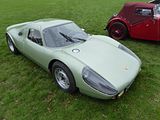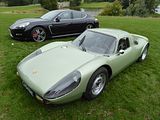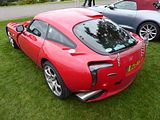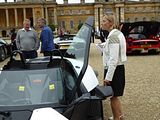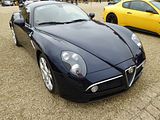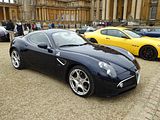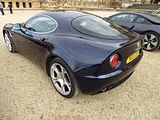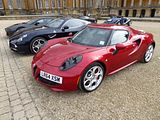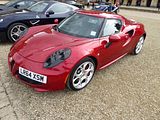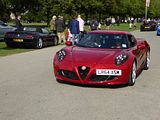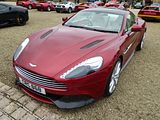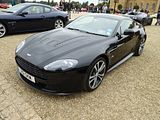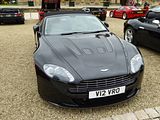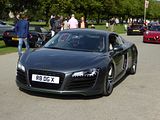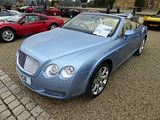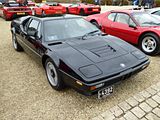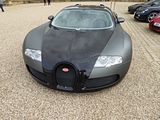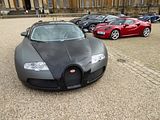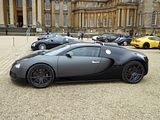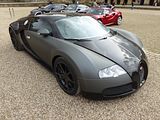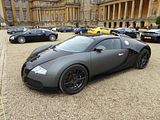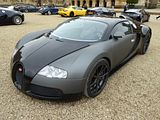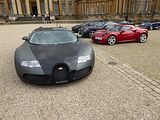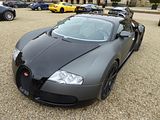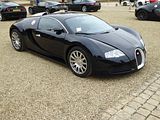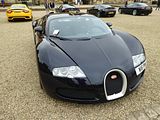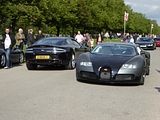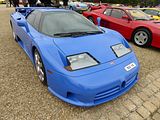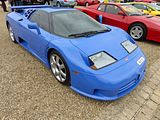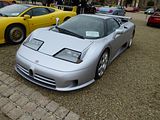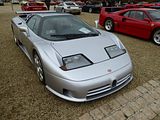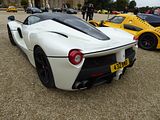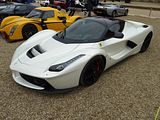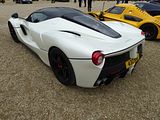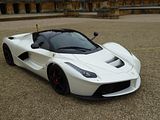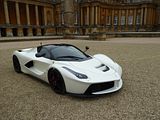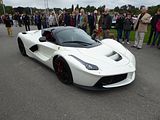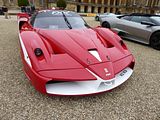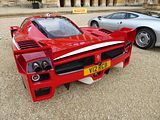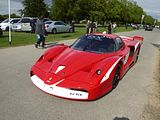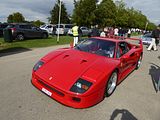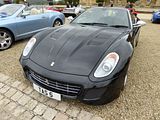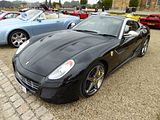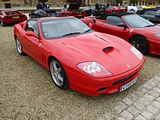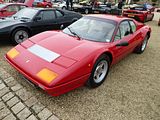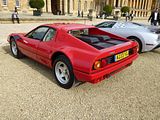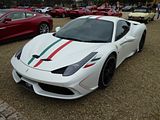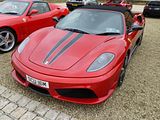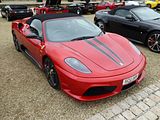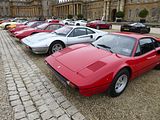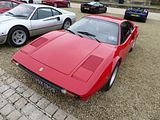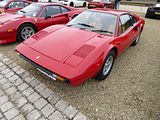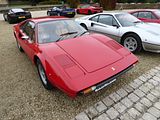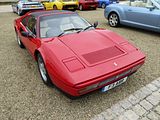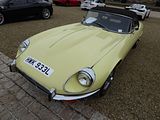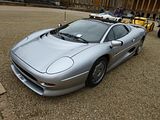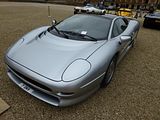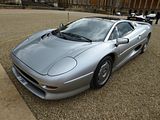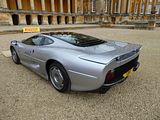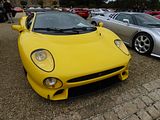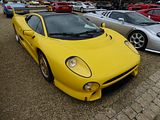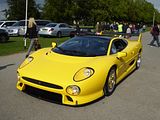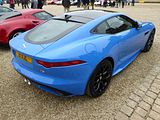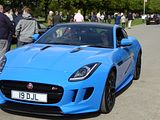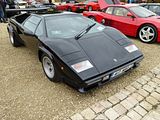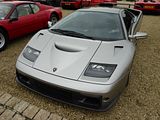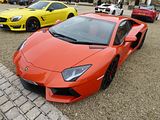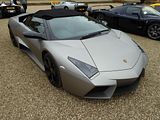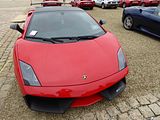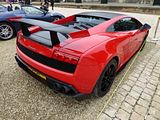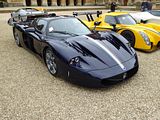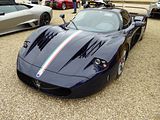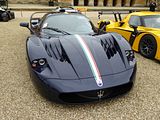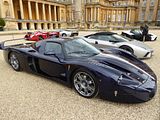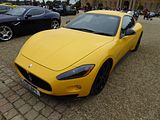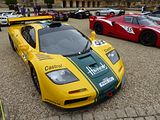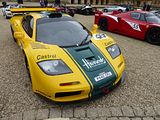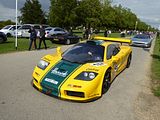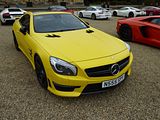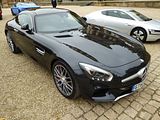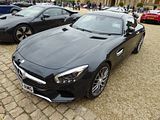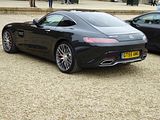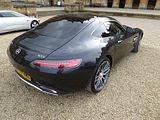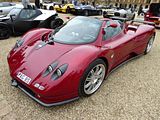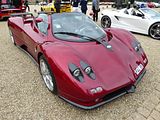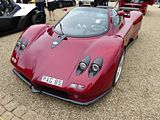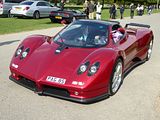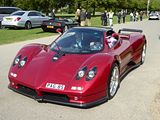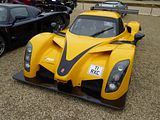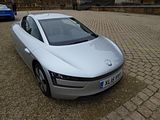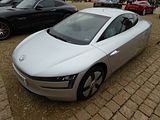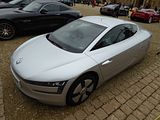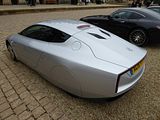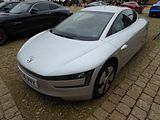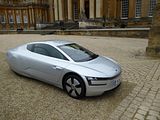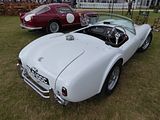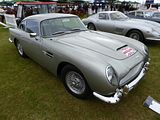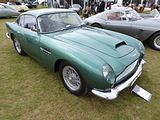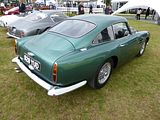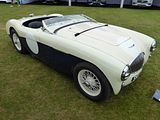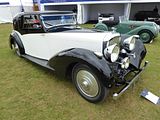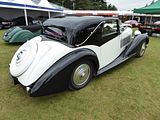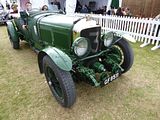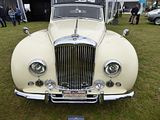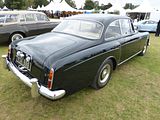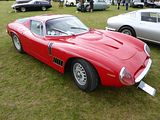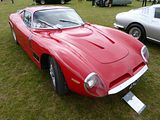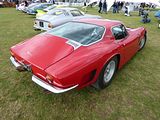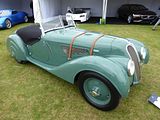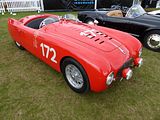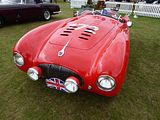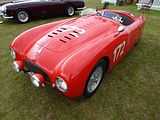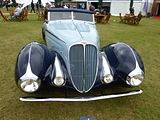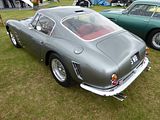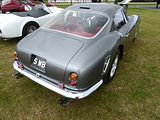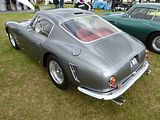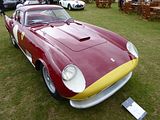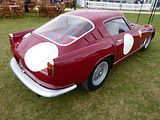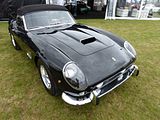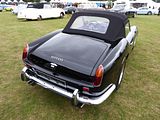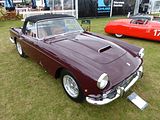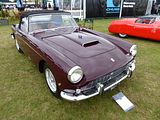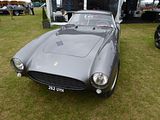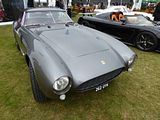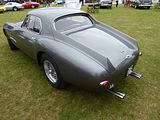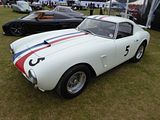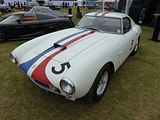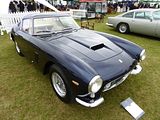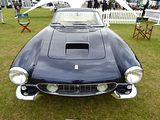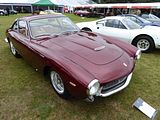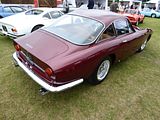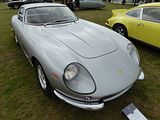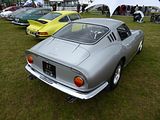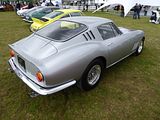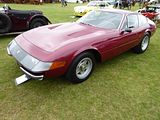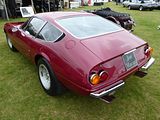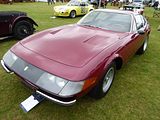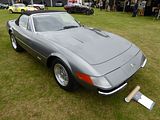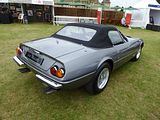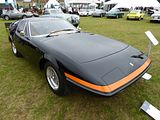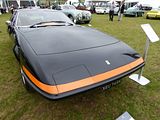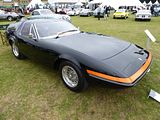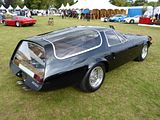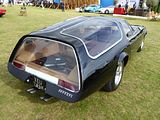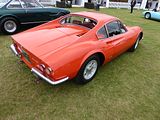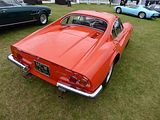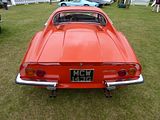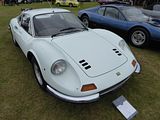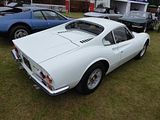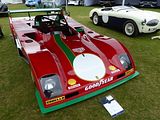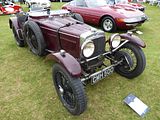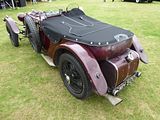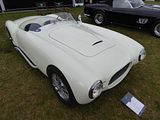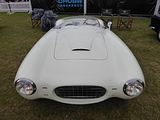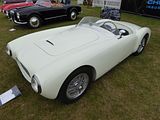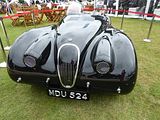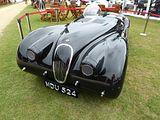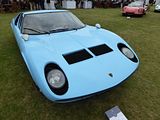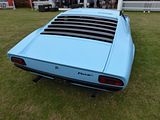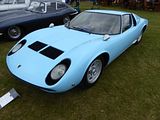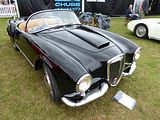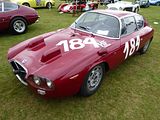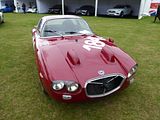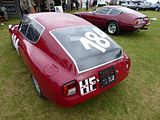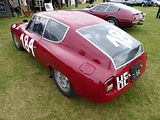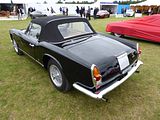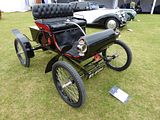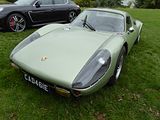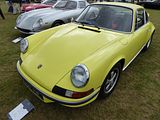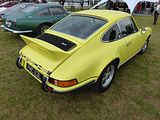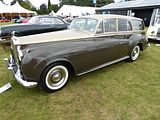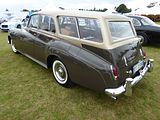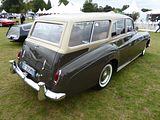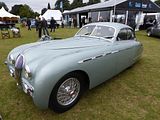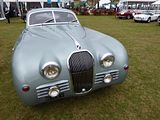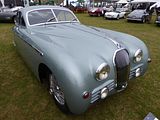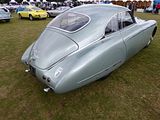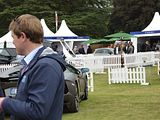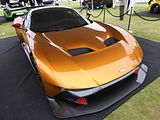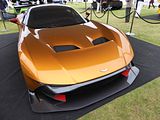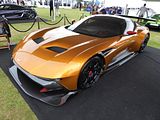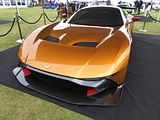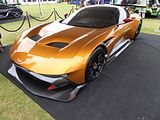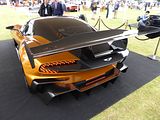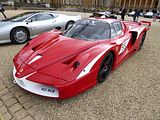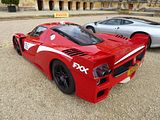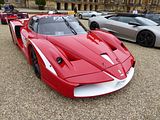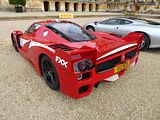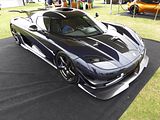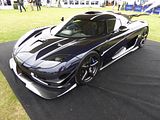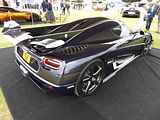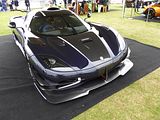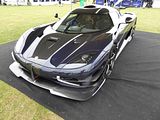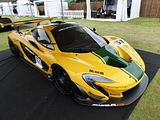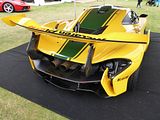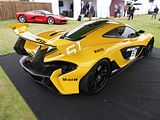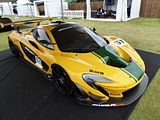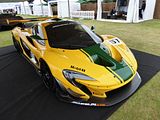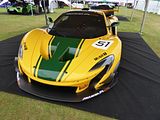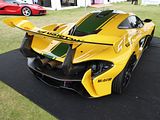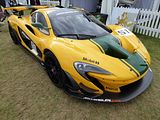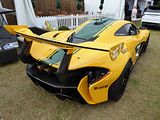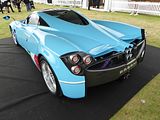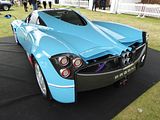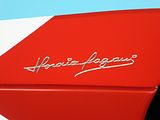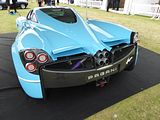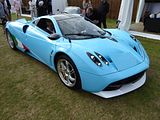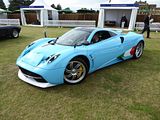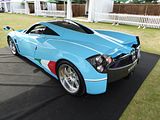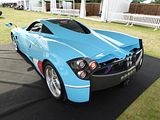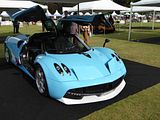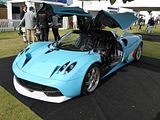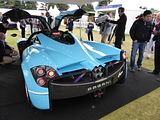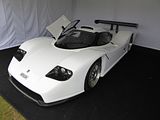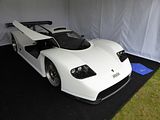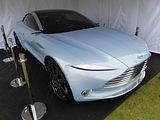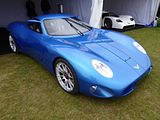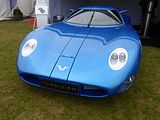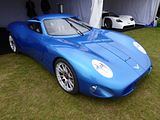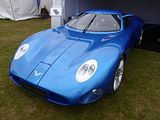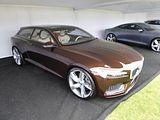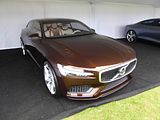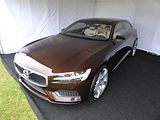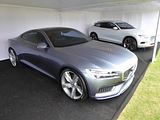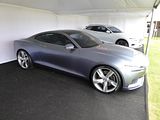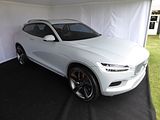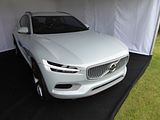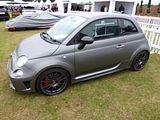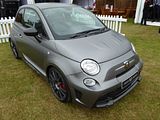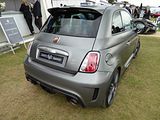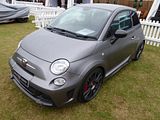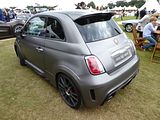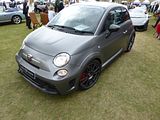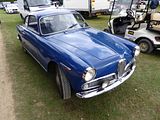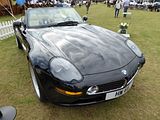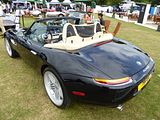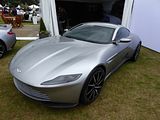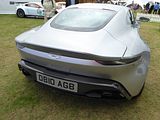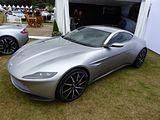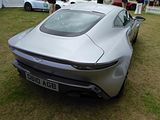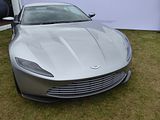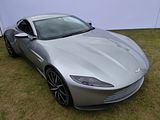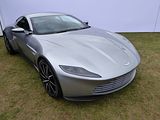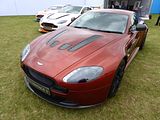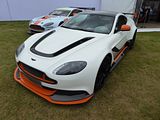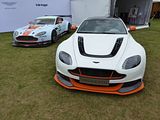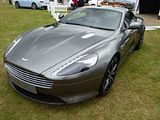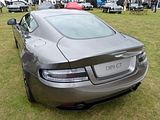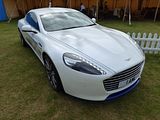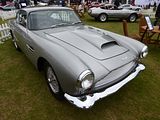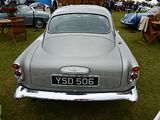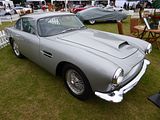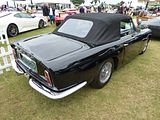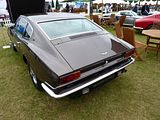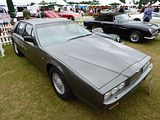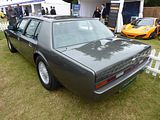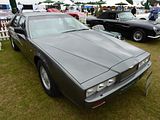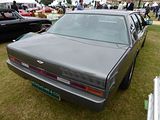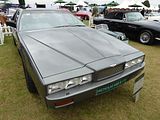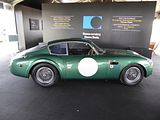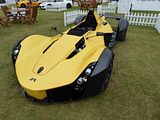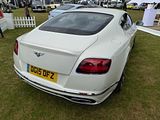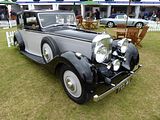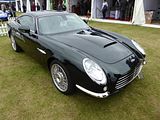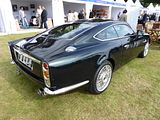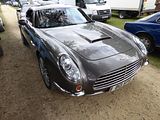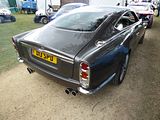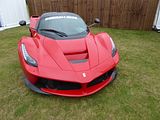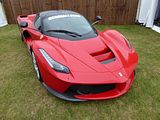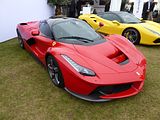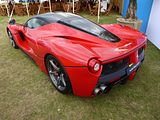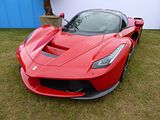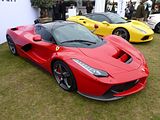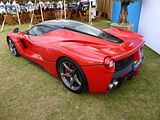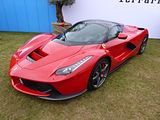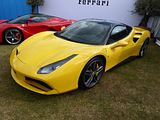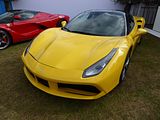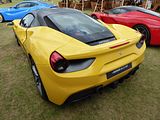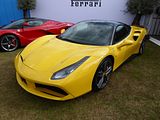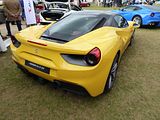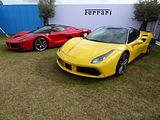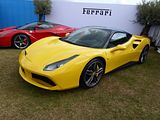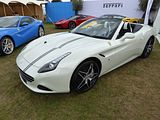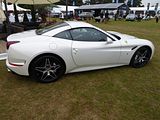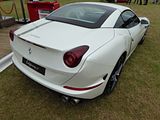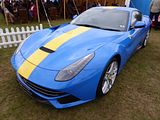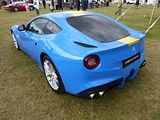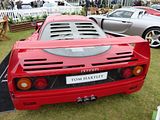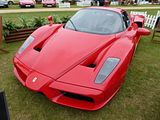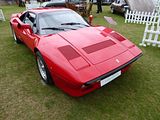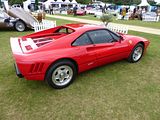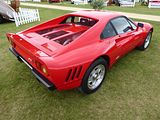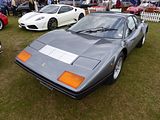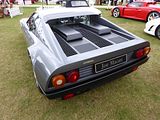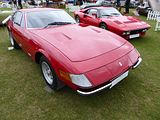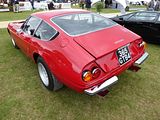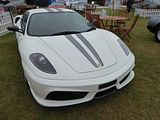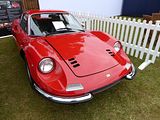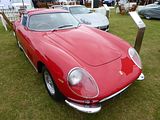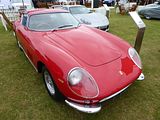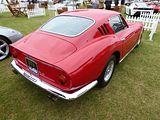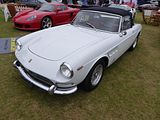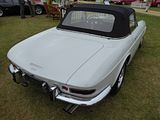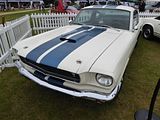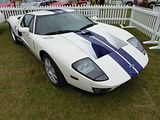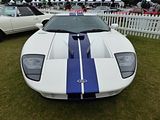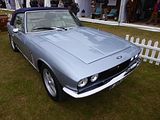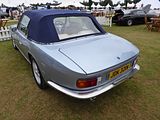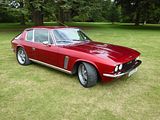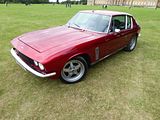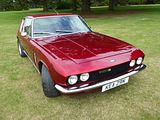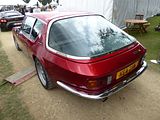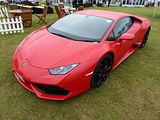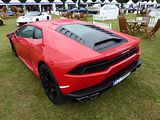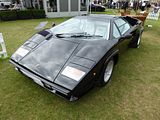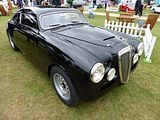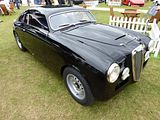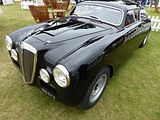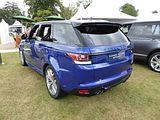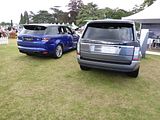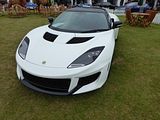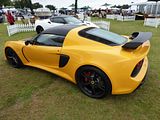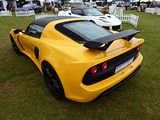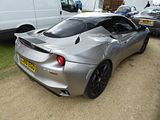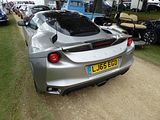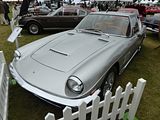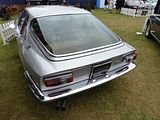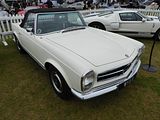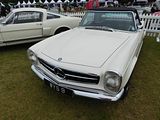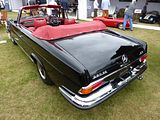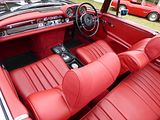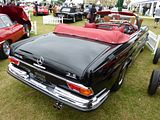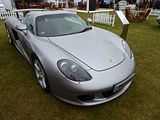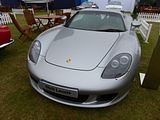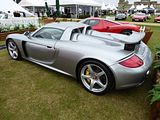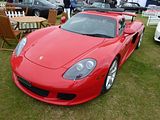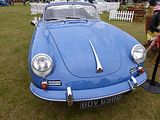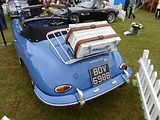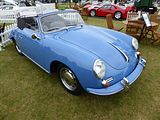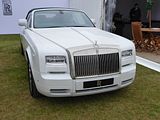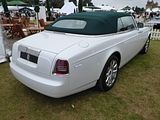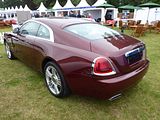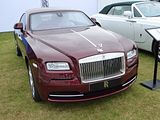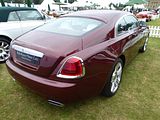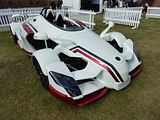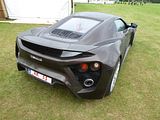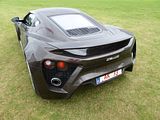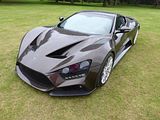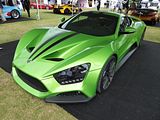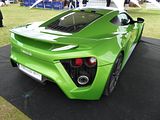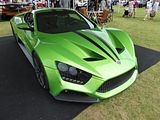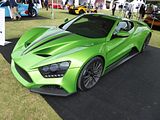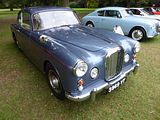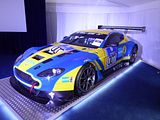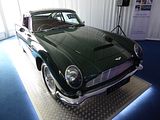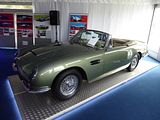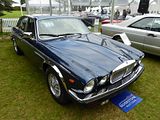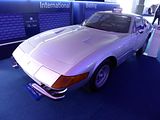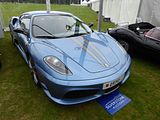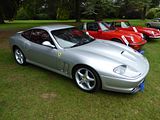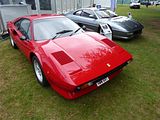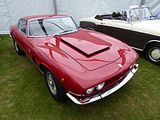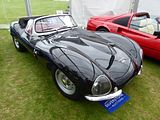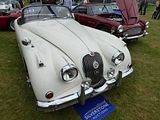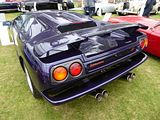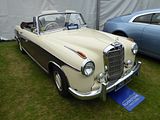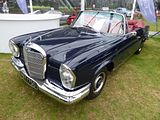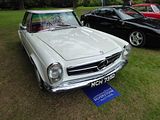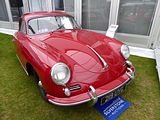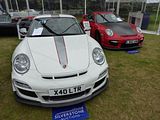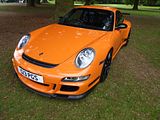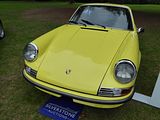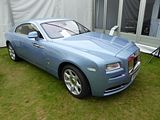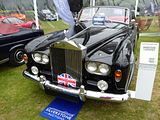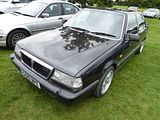The marketing material tells you that Salon Privé is a motor show unlike any other. It’s been held every year since 2006, and having finally experienced it for myself last year, as opposed to reading a short report and seeing a few photos, I would be inclined to agree. Certainly as far as UK events are concerned, the Salon Privé is something quite special. As well as combining displays of the latest supercars, hypercars and concept cars, the event includes a selection of some of the world’s most beautiful classic cars, in a fabulous setting, combined with a Garden Party. So, spectacular cars shine, the diamonds sparkle and the champagne corks pop. The first Salon Privé events took place at the exclusive Hurlingham Club in London, and then for the last four years, the event was moved to the lawns of Syon House. For the eagerly awaited 10th edition of the Salon Privé, the decision was taken to move out of London altogether. The new venue was announced as the South Lawn of Blenheim Palace, seat of the Dukes of Marlborough, and birthplace and ancestral home of Sir Winston Churchill. It proved to be an excellent choice. Another innovation was to change the admission policy. In previous years, in accordance with the Garden Party concept, your entrance ticket – which did not come cheap – included lunch and as much bubbly and other liquid refreshment as you wanted. New for 2015, a much cheaper ticket, costing £20 as opposed to a figure which was 10 times that for one of the days, was offered for the Saturday, with access to a part of the event only. Having enjoyed the 2014 event, where I had concluded that the pricey admission ticket (with a discount code) was worth it, even though it was the most costly entrance ticket I bought all year, I agonised over what to do for 2015. Unsure of which elements would be off limits to those with the £20 tickets, even though there were no discount codes that I could find, I decided to stump up for the full £115 ticket. Add in the cost of petrol. and even though Blenheim Palace is considerably nearer my residence than London, be in no doubt that this was not a cheap day out, but as you look at the photos in this report, you will doubtless agree, even without being able to taste the food and drink that passed my lips, that this was a great event.
The event is held over three days, and there are differences between them. Thursday was the day for the world-renowned Chubb Insurance Concours d’Elégance, the Friday was the sophisticated Boodles Ladies’ Day on Friday 4th September where I imagine that the hats and ladies’ outfits were something to behold and the final day was for the ultra-glamorous Salon Privé Supercar Show. With more supercar, hypercar and concept car manufacturers, classic car dealers and luxury brands than ever before attending the event, as well as an area in front of the house for those special supercars, there was always going to be a lot to see, and so it proved.
THE “APPETISER”
It was a short walk across the fields that were serving as the public car park to the imposing gates, where tickets were either inspected or to be purchased. Once past this point, there is a long straight drive towards the house, in front of which cars were parked. This seemed to be an area where those who had brought an interesting car, probably a supercar of some sort, and who had pre-booked a display space, could show their car off. There was a random collection of cars, ranging from the familiar to the decidedly exotic in this part of the show. There were lots of cars in situ even by 10am when I arrived, and the gates had just opened, and the area filled up some more during the day, so by the time I cam back to this area, en route to and from the South Lawn, there was plenty more to see.
ASTON MARTIN
Surprisingly, the only Aston Martin that was to be found in this area was an example of the “family” model, the Rapide S.
AUDI
Audi may lack the prestige badge of some of the cars here, but there is no denying that the R8 counts as a true supercar. It’s one that is probably easier to live with than just about any other, too. Combine that with an awesome powertrain, and sound track, whether that be the V8 or V10 engine providing the go, and it is no wonder that there were a number of both Coupe and Spider models in this part of the event.
AUSTIN HEALEY
3000
BENTLEY
Bentleys in this area of the event were all very modern ones, with a Continental GT Coupe and a couple of the latest Mulsanne models among them.
BMW
BMW’s futuristic supercar, the i8, is still a rare enough and striking sight that it pulls the crowds wherever it appears, and this one was no exception.
BUGATTI
This Veyron Grand Sport was parked up at one side of the parking area. It was drawing quite a crowd, for sure, but in fact there was a car only a few paces away which was pulling more people, and for which I had to wait to longer for the people to disperse before I could get my pictures. By the end of the day, this Veyron was spectacularly dusty.
FERRARI
There were lots of Ferrari models in this area of the event.
Rumours abound that Ferrari are planning to add a smaller and cheaper model to their range in the next couple of years, which many are saying will be like a modern Dino. It will have to be a special car indeed to be as nice as the original one, a 246 GT example of which was to be found here. There were several others elsewhere in the event, as you will see in this report.
Likewise, this was not the only 365 GTS/4 Daytona Spider present on the day. Ferrari only made 122 of the open-topped Daytona models, but there are far more than that around, as there was quite a fashion for cutting the top of Coupe models in the 1980s and 1990s, at a time when regular Coupes were not that valuable.
If we are talking valuable, then that is what this car is. It is also probably my favourite Ferrari of all time, the 288 GTO. I am clearly not the only one who loves it, as the car got such a crowd around it as the owner tried to park it, that the task became quite difficult for him.
Values of F355 models are rising, fast, now, and it’s not hard to see when you look at it. Created out of the less than well-regarded (when new) 348 range, the F355 was an amazing transformation that made the car look, sound and drive like it should have done all along. The fully open Spider models were surprisingly popular.
By the time that the F430 came along, Ferrari were producing more cars than ever before, and so these cars, whilst still nice are far from rare. As well as a regular road car, there was one of the GT3 Race cars here.
There were two examples of the front engined V12 model that Ferrari introduced in 1996 to replace the mid-engined Testarossa series of cars. One was the “regular” 550 Maranello and there was also one of the rare 575 SuperAmerica cars to be seen.
Several of the models here were recent cars, with a number of FF models, one of the California T cars which is the marque’s first turbocharged road car, and a significant advance on the similar looking car it replaced last year, as well as a number of the other V8 model in the range, the 458. As well as the popular Spider versions, there were Speciale cars here, too.
Introduced at the 2010 Paris Motor Show, the Ferrari 599SA Aperta was a one-off collection in honour of designers Sergio Pininfarina and Andrea Pininfarina. Only 80 examples were released. The SA Aperta used the higher performance engine from the 599 GTO.
Later in the day, a LaFerrari was among the other cars in this area. It is now over two years since Ferrari revealed this hypercar, but it still pulls crowds of interested parties almost like no other car. Even now, it is the Maranello marque’s latest state-of-the-art hypercar, following a rich bloodline of ultra-exotic limited production models from the celebrated Italian sports car maker, including the 288 GTO, F40, F50 and Enzo, examples of which were also to be seen at this event. Despite being Ferrari’s fastest production road car of all time (with a claimed top speed of 217 mph/350 km/h), this 950 bhp hybrid supercar is also one of its most economical, using 40 percent less fuel than a ‘regular’ V12. LaFerrari mates an 800 bhp 6.3-litre V12 internal combustion engine with an electric KERS motor – perfected in F1 racing, and producing an additional 150 bhp – to provide extra thrust during acceleration. This catapults the car from 0-62mph in under three seconds, making LaFerrari nearly as fast as a modern Formula 1 car, while also trimming emissions and fuel consumption. The total LaFerrari production run of 499 examples, each priced at over £1 million, sold out instantly.
JAGUAR
Jaguar only made 30 of the ultimate version of the recently discontinued XK, the XKR-S GT. 20 of them were in US spec and were shipped over the Pond, leaving 10 for the UK. 3 of these have been retained by Jaguar, so there are only 7 that are privately owned, so this was one of the rarer cars of the day. I know from last year that one of the 10 right hand drive ones is red, but that was not here, and that all the others are white.
XK140 Drophead Coupe
JENSEN
This Interceptor had been updated to the new Interceptor R spec, which gives the elegant shaped British built but Italian styled car a new engine, upgraded mechanicals and trim. Another one of these cars features later in this report, where there is more information about the extent of these changes.
LAMBORGHINI
This is one of the first Aventador SV cars in the UK, and it was a real crowd puller. The fact that it had large SV logos on its flanks left no-one in any doubt that this is even more special than the regular Aventador. There have only been three previous Lamborghini models labelled SV (for Superveloce), and they have all been very special. This one is, too. It has a significant power upgrade over the regular Aventador, churning out 740bhp from a 6.5-litre naturally aspirated V12 engine that revs to 8500rpm. Lamborghini chose not go go down the forced induction route for the extra power, but rather created a whopping, easier-breathing engine in the middle of the car, with a new exhaust and a raised rev limit over the standard V12. It also makes 509lb ft at 5500rpm. It is mated to a single-clutch automated manual gearbox with an improved shift calibration, and more significantly still, an SV is an impressive 50kg lighter than the regular Aventador. There are new door skins and a couple of lighter carbonfibre panels, clad over the carbonfibre monocoque, but I suspect the real weight saving comes in the stripped-out interior. Lamborghini quotes a dry weight of 1525kg, which you could probably make closer to 1700kg by the time it sits at the kerb. Other changes include a big rear wing that gives serious downforce. Magnetorheological adaptive dampers are standard on the SV, as is dynamic steering – which changes ratio depending on road speed and a host of other factors like how much of a ‘bung’ you give the car on the way into a corner. Whilst the regular Aventador did not receive a totally rapturous reaction from the press on launch, they all seem to have loved this one.
The Huracan has only been on sale for a little over a year, but already they are starting to appear in significant number at events where supercars gather, and that was the case here, with several of the entry level Lamborghini in evidence.
LEXUS
There were two examples of the dramatic LFA here, later in the day. I think these are the first LFA models I have ever seen out on the road. Lexus’ first, and only supercar had a very long gestation. The story goes back to February 2000 when development work started on a supercar project codenamed P280, which was intended to showcase the performance capabilities of Toyota Motor Corporation and its Lexus marque. The first prototype was completed during June 2003, and early prototypes were spotted regularly undergoing testing at Nürburgring, from October 2004. Numerous test vehicles had been equipped with automatic retractable rear wings, and carbon ceramic brake discs. In January 2005, the first LF-A concept premiered at the North American International Auto Show in Detroit, as a design study with no plans for production. This first LF-A concept had an overall length of 4,399 mm (173.2 in), 13 cm (5 in) shorter than the Porsche 911 Turbo (996) while its wheelbase measured 2,581 mm (101.6 in), or about 23 cm (9 in) longer. The concept was nearly 1,219 mm (48 in) in height, with a width of 1,859 mm (73.2 in). Some reported that the concept name referred to Lexus Future-Advance, a claim later dismissed by Chief Engineer Tanahashi. The first LF-A concept featured a glass roof and side cameras mounted in the side mirrors. Twin rear radiators were installed behind the rear wheels, and visible behind large screens. The rear bumper featured a triple exhaust placed in an inverted triangle formation. The wheels were shaped like turbines, and air-scoops were placed on the C-pillars. Following enthusiastic public reaction for the LF-A concept on the autoshow circuit, development continued with a greater emphasis on a possible production model. Concurrently, Lexus was preparing for the launch of its long-rumuored F marque series of performance vehicles, with a production LF-A being a possible future member of this lineup. Reports in 2006 suggested that the LF-A concept car had received the green-light for production, however these reports were not officially confirmed. Following the original LF-A concept, development time was lengthened by the switch from an aluminium frame to a carbon fibre tub, the result of engineering efforts aimed at improving the LF-A’s power-to-weight ratio. The LF-A was reported to draw engineering resources from Toyota’s Formula One team. In January 2007, a restyled LF-A concept car premiered alongside the first production F marque vehicle, the IS F sports sedan. The second LF-A concept featured a more aerodynamic exterior, a near-production interior, and F marque emblems. Later that year, Lexus GB director Steve Settle indicated plans for a V10 and hybrid version of the LF-A. The hybrid version, combining a petrol engine with electric motors, would likely feature a V8 powertrain similar to that designed for the Lexus LS 600h L. LF-A test mules continued to be spotted at the Nürburgring, including early models with a large, fixed rear wing. In December 2007, Auto Express reported that the LF-A had set an unofficial 7:24 lap record at the Nürburgring.In January 2008, Lexus displayed a roadster version of the LF-A concept car designated LF-A Roadster or LF-AR at the North American International Auto Show. Initial specifications for the roadster were a V10 engine under 5.0 litre with over 500 hp and a top speed of over 320 km/h (200 mph). Automotive photographers capturing the LF-A in various test guises had photographed a disguised drop-top test model, dubbed LF-A Spyder, on the Nürburgring as early as October 2005. After its debut at the 2008 North American International Auto Show, the LF-A Roadster was also shown at the 2008 Pebble Beach Concours d’Elegance, the 2008 Geneva Motor Show, the United States Open Championship tournament, and at Lexus exhibits in Japan. A single LF-A racing prototype was also entered into Veranstaltergemeinschaft Langstreckenpokal Nürburgring endurance races at the Nürburgring in May 2008, competing in the SP8 class of VLN events. Media reports uncovered an LFA trademark filing with the United States Patent and Trademark Office in December 2008, with the concept LF-A name dropping its hyphen to become LFA for a possible production model. The second LF-A concepts had an overall length of 4,460 mm (175.6 in), and a wheelbase of 2,598 mm (102.3 in); height remained the same as the prior concept, while width grew to 1,895 mm (74.6 in).While the original LF-A had been strictly a concept model, the second concept’s design reflecting engineering analysis for possible production. The exterior design had been restyled to take advantage of the flexibility offered by carbon fibre construction, with improved aerodynamics and surface features aimed at improving the coupe’s overall top speed The reshaped exterior featured smoother lines with additional detailing, and more curved surfaces. The aft radiator cooling vents were retained, but integrated into the rear fascia, and the lower side and front air intakes were restyled, along with the forward fascia and headlamps. Designers reportedly drew inspiration from the 1965 Toyota 2000GT sports coupe, which was also produced in a front-engine, rear-wheel drive layout, and represented the combination of Japanese technology and design ethics in an supercar However, no design features on the LF-A were directly derived from the 2000GT. The second LF-A concept and accompanying LF-A Roadster were also equipped with a retractable rear wing for improved handling at speed and a two-seat interior with a two-tone colour scheme. On August 5, 2009, Toyota’s new CEO, Akio Toyoda, publicly confirmed production of the LF-A in his speech at a conference held at the Center for Automotive Research in the United States. The production vehicles were expected to carry V10 engines, putting the car in market competition with the Lamborghini Gallardo, Ferrari F430, the Porsche 911 (997), and the Chevrolet Corvette C6 ZR1. Pricing was estimated at close to US$400,000. Two LF-A prototypes had also competed at Nürburgring VLN endurance races in mid-2009. In September 2009, reports in Japanese automotive magazines indicated that the 4.8 L V10 engine for the LF-A would carry a 1LR designation. A subsequent television ad for the Japanese market showed the pre-production LFA testing at the Fuji Speedway. On October 21, 2009, the production Lexus LFA was unveiled on the first press day of the 41st biennial Tokyo Motor Show. The vehicle was introduced by Akio Toyoda at a press conference, in which it was disclosed that the vehicle would be limited to 500 production copies. The vehicle carried the same designation as the concepts, LFA, but without the hyphen. The production designation reportedly stood for Lexus Fuji Apex, another claim dismissed by Chief Engineer Tanahashi. The LFA was shown as the final vehicle of the press conference, following the LF-Ch hybrid concept. Pricing details at the show was estimated at US$375,000. The production announcement for the LFA supercar marked the 20th anniversary of the launch of Lexus. Given the high cost of construction and development, analysts did not expect LFA sales to be profitable. However, the coupe was intended to serve as a testbed for new car technologies, including carbon fibre mass-production, and related performance vehicle development. At its debut, a circuit-ready model was also indicated for 2012 release. Lexus began taking orders for the LFA supercar on October 23, 2009. Buyers were selectively chosen by Lexus in the second quarter of 2010. Production began in December 2010 as a 2011 model. Only 500 total LFA models were scheduled to be made worldwide, with only 20 produced each month. Each car had to be custom ordered to the customer’s specifications, and cost approximately US$375,000, depending on options and customisation. Following the LFA’s release at the Tokyo Motor Show, Lexus unveiled a website with a ‘LFA configurator’ which allowed users to select exterior and interior colours, brake caliper colours, seats, steering wheel leather, and other interior designs. In total, there were over 30 billion possible configurations. Each LFA was hand-built by a dedicated production team of engineers and specialists at Toyota’s Motomatchi plant in Aichi, Japan. In the North American market 150 LFAs were initially sold through a two-year lease program much like the Ferrari F50. This was to prevent owners from reselling the vehicle for a profit. Racing driver Scott Pruett was hired to give test drives to interested buyers, demonstrating the vehicle’s capabilities at Auto Club Speedway. The Lexus division of Toyota Motor USA stopped taking orders at the end of 2009, at which time they planned to open discussions about a purchase plan for the lessees. Lexus later changed their stance and allowed outright purchase, but only on the condition that they sign an agreement giving the dealer first right of refusal to buy back the LFA if the owner wanted to sell it within the first two years. The dealer would have the option to buy back the used LFA for either fair market value or the original sticker price, whichever is lower. In the European market buyers ordered their LFA through a single Lexus dealer located in Park Lane, London where they were purchased outright. During LFA production, each vehicle received an individually numbered plaque, indicating the unit’s place in the production run. Each LFA V10 engine carried the signature of the specialist who assembled it. With 20 units produced monthly, production of the entire LFA extended from December 2010 to December 2012. Production ended on December 14, 2012, with LFA #500, in white, Nürburgring package. When production ended, no successor was scheduled.
LOTUS
There were two examples of the Evora GTE here. First seen at the 2011 Frankfurt Show, and with looks that were inspired by the Evora GTE racer, with the regular Evora Coupe’s inoffensive lines replaced by aggression and attitude, new front air intakes, wider hips and a stonking rear spoiler, the road going Evora GTE was intended to be the fastest, most focused and most exciting production Evora available. By extension it would also be the fastest production Lotus ever. The spec was certainly there to go GT3 hunting, and to compete with cars like the M3 GTS, C63 Black Series and 997 GT3 RS, which inevitably must have been the target. Power was up 90hp on the Evora S to 440hp, and there was an automated single-clutch manual transmission (dubbed an AMT racing gearbox). The rear track was 100mm wider than the standard car. Thanks to liberal use of carbonfibre – including bumpers, rear wing and doors – the weight was quoted as 1277kg, 105kg less than the standard car, which was hardly overweight in the first place. Prices of around £100,000 were mooted. Initially the GTE was going to be available only in China, which sounds like madness. as it was pretty obvious that there would be demand for this car elsewhere. And it was quickly proved that there was, with plenty of people requesting the car. But this was the era when things went somewhat awry at Lotus, following the departure of Danny Bahr as CEO. What happened next is not clear, but it is generally believed that after 30 pre-production cars were built at Hethel, the project was stalled. Some of these cars were registered, some were not. Predictably enough the cars were not a priority as Lotus changed ownership and it wasn’t until September 2014 that Lotus sold off 20 GTEs to its dealers around the world. They would be remanufactured from original spec by Lotus Motorsport to include new suspension wishbones, brakes and wheels. Frustratingly that also meant a return for the 350hp Evora S engine. Just six right hand drive GTEs were built, and it is believed that those which found buyers were indeed sold for around the initially quoted price of £94,995. For those who want the full 440hp, then at least one dealer who sold a GTE suggested a Komotec upgrade for an additional £5,000.


MASERATI
4200 GT
McLAREN
MP4 12C
MORGAN
There were a couple of the AeroMax Morgans here. Effectively the Coupe version of the Aero model that shocked the traditonalists when it was launched in 2001, the AeroMax was an instant hit, even at £110,000. Production was limited to just 100 units, and famous owners have included Richard Hammond, Paul O’Grady and Rowan Atkinson.
PAGANI
Early on, there were no Pagani models in sight, but when I came back to this area mid afternoon, I could barely believe my eyes. I have never seen so many Pagani models gathered together in one place. Indeed, given the number of cars produced over the years, this had to be a significant percent of all Pagani models ever made. There was a mix of Zonda and Huayra cars, not all of them in UK plates. I understand that Horacio himself had come over, though I did not see him. I did see lots of other people also marvelling at this spectacle – one of the best of many memories from this amazing event.
PORSCHE
When I arrived there was one 918 Spyder, the black one, parked up here, and then later in the day a second had joined it.
Needless to say, there was a vast array of 911 models in this part of the event, with examples from all the generations of this 51 year old name to look at. The most notable were the high end versions, of course, with Turbo S GT3 and GT2 examples of the 997, a GT2 RS, a 991 Carrera GTS and the elegant 993 being the ones that attracted my camera.
By contrast with the 911s, the first production Porsche model, the 356, seen here in Coupe form, looks particularly dainty.
ROLLS ROYCE
Looking as majestic as ever were three modern Rolls Royce motor cars, a couple of Phantoms and a Wraith
CLUB DISPLAYS
Just around the corner for the cars presented above was an area allocated for Club displays. Needless to say, the list of Clubs was short and exclusive!
FERRARI
The Ferrari Owners Club display comprised with largest collection of cars, with three long rows of machines made in Maranello providing an interesting summary of the different models offered over the last 35 years or so, with just about every regular production model type that has been offered in that tine represented by at least one car. Looking at this series of photos will give you an almost complete history lesson in the marque from the 308 GTB of 1975 to the very latest models.
308 GTB
348 tb
Testarossa
F355 Berlinetta and Spider
360 Modena and Spider
F430 Spider and 16M Spider
550 Maranello and 575M
599 GTO
612 Scaglietti
458 Italia Spider and Speciale
California and T
During the day, the 288 GTO which had been parked up around the side of the house was moved to join this display.
JAGUAR
C Type
F Type Coupe and Convertible
LAMBORGHINI
There was also a sizeable assembly of Lamborghini models. As with Ferrari, this display amounted to something of a history lesson in Lamborghini. This marque has produced fewer different models in its 52 year history of producing cars,and apart from the late 1960s and early 1970s, with a smaller range in production at any one time but especially more recently, there have been far more variants of some of those models, so this was still a particularly interesting assembly to look at.
Oldest model here, and probably my favourite of the whole lot was a Miura, still thought by many to be the first true supercar. First launched in 1966, it is hard to imagine just how different it was compared to even the other exclusive cars of the day , such as rivals from Ferrari and Maserati. With a mid-engine and low-slung styling it must have seemed like it was from another epoch. It still pulls the crowds wherever it appears, almost 50 years later.
By contrast, the Espada was pretty conventional, in many ways. Sharing the same 4 litre V12 engine with the Miura, this was a four seater express with space for plenty of luggage. Over 1200 of these cars were made in a 10 year period between 1968 and 1978. Far a long time, they languished in the “not worth the huge cost in restoring” category, but that has changed, and there are some nice examples out there now.
Needing no introduction is the Countach LP5000S, a car which was the object of desire for every small boy, and many larger ones from launch in the early 1970s. Who did not have a poster of one of these on their bedroom wall, then?
Less well known is the Silhouette, an opentopped evolution of the Urraco, the car that Lamborghini produced to compete against the V8 engined Ferraris of the mid 1970s. Through no fault of their own, it was badly timed thanks to a launch that coincided with the 1973 Oil Crisis, but the car went on to sell 795 examples before becoming the Silhouette. Officially presented at the 1976 Geneva Auto Show, the Silhouette had begun as a styling exercise by noted Italian Carrozzeria Bertone, distinguished from the Urraco by more angular styling. The Silhouette was the first Lamborghini to employ a targa top roof. The production Silhouette had a 3.0 litre all-aluminium alloy Lamborghini V8 mounted transversely behind the driver which gave it a performance of 0 to 100 km/h (0 to 62 mph) in 6.5 seconds, 0 to 100 mph (0 to 161 km/h) in 16.1 seconds, and a top speed of 160 mph.. Of the 54 units built, just 12 of them with right-hand drive, 31 are currently known to exist. The Silhouette later evolved into the similar looking but more successful Lamborghini Jalpa.
Needing no real introduction were the recent Lamborghini models, There were at least 6 of the Diablo models here, including the VT and SV versions.
There was a Murcielago SV as well
Gallardo cars included a couple of the Superleggera models.
From the current range were a trio of Huracan and a quartet of Aventadors.
MISC
A collection of other interesting and worthy cars was parked up on the other side of the site road from the Ferrari and Lamborghini models.
Alfa Romeo Giulia GT Sprint
Aston Martin Vantage and DB7
BMW E30 M3
Jag XK150S Drophead Coupe
Lotus Elan Sprint
Mercedes-McLaren SLR
MG PB
There were more 911 models, augmenting the ranks of those already seen in this report, with 997 and 991, a G Series 911 Turbo and 996 GT3 among them
This 904 Carrera GTS would appear to have been an entrant in the Concours on previous days.
TVR Sagaris
THE SUPERCAR SHOW and THE PIRELLI PRESTIGE & PERFORMANCE COMPETITION
I attended on the Saturday, which meant that I got to see the Supercar Show. With 100 selected supercars on display within the stunning Great Court as the setting for the event, in an area that those who had bought the £20 tickets could access, this display made the journey to Blenheim Palace worthwhile in its own right, as among those 100 cars were some cars that you just don’t see even at other supercar events. As well as the static display of the cars, this part of the event included the inaugural Pirelli ‘Prestige & Performance’ Competition, something new and for post 1975 Supercars. The classes included: Celebrating 40 years of the Ferrari 308 GTB; Celebrating 10 years of the Bugatti Veyron; Road or Race or BOTH!; Built for Speed; Feel the Breeze; Grace & Pace; Pre-Millennium Supercars; Blink and it’s gone. These categorisations meant that many classes only had a couple of entrants, so there was probably more interest in the overall “People’s Choice” award. Car enthusiast and former racer Tiff Needell, best known for presenting BBC’s Top Gear and Fifth Gear, lead the judging panel at the Pirelli Prestige & Performance Competition. Also judging were Matteo Barbieri, who heads up Pirelli’s international commercial focus on prestige, motoring journalist and broadcaster Jason Barlow and racing driver and television presenter Vicki Butler-Henderson. During the day, Tiff and VBH were to be seen wandering around the cars, and talking to the owners, as they conducted the almost impossible task of picking “winners”. Needless to say, this was a particularly popular part of the event, and the organisers estimate that over 5000 people enjoyed it, meaning that nearly 50% of the visitors over the entire three days saw this part of the total display.
ALFA ROMEO
First seen as a concept car at the Frankfurt Motor Show in 2003, the 8C was a two seater Coupe model intended to remind people who were perhaps slightly disillusioned with contemporary Alfa products that the company could still style something as striking in the 21st century as it had been able to do in the 1950s and 1960s. Public reaction was very positive, but Fiat Group Execs were very focused on Ferrari and Maserati and they were not entirely convinced that a car like this was appropriate as it could encroach on those brands’ territory. It was only in 2006, with new management in place that it is decided that a limited production run of just 500 cars would give the once proud marque something of a boost. Announcement of the production version, visually little different from the 2003 concept car was made at the 2006 Paris Show, and it was soon evident that Alfa could have sold far more than 500 cars To turn the concept into reality, Alfa used a shortened Maserati Quattroporte platform with a central steel section, subframes front and rear and main outer panels that were all made from carbon fibre, with the result that the complete car weighed 300 kg less than the GranTurismo. Final assembly was carried out by Maserati, with the cars being built between 2007 and 2010. Competiziones (Coupes) first, and then 500 Spiders. Just 40 of the Competizione models came to the UK. Most of them were sent to the US, so this car is exceptionally rare and is much sought after by collectors. Featuring a 4.7 litre V8, the Alfa Romeo 8C sounds as good as it looks and is widely regarded as one of the most beautiful supercars ever made.
With the marque desperately in need of a halo model again, Alfa looked to pull off the same trick with the 4C Competizione. This one has had a more mixed reaction, with some loving every aspect of it, whilst others have found it inferior to the Porsche Cayman in too many areas. People who put deposits down early had a long wait for their cars, and some doubtless hoped that with restricted supply, a quick resale would yield a sizeable profit. That has not proved to be the case.
ASTON MARTIN
The most advanced and powerful road-legal Aston Martin ever produced, the Aston Martin Vanquish was first introduced in 2001 as the successor to the Virage. With a top speed of 200mph and 0-60mph in 3.6 seconds, the first Aston Martin Vanquish was produced until 2007, before it was replaced by the not dissimilar looking DBS. That car was replaced by a new flagship which once again took the Vanquish name. The 2015 model generates 568 bhp which gives it a 0-60 time of 3.6 seconds and a top speed of 201 mph
Also using a V12 engine is the smaller V12 Vantage, the more powerful of the “entry level” Aston that has been on sale since 2005, and which has helped to increase this British marque’s sales to hitherto unprecedented levels.
AUDI
Designed, developed and built by Quattro GmbH, Audi’s high performance private subsidiary, the Audi R8 is often heralded as the world’s best everyday supercar. Built on an aluminium monocoque chassis, the R8 has been described by 6-time le Mans winner Jacky Ickx as the “best handling road car today”, high praise indeed, and he is far from the only person to be impressed. Even the UK motoring journalists, not renowned for the positive words that they pen on Audis (in complete contrast to their German peers) almost ran out of superlatives for this car. This is one of the V8 models, dating from 2009, which means that it has 430 bhp, a 0-60 time of 4.0 seconds and a top speed of 168 mph
BENTLEY
Continental GTC
BMW
Launching a £100k supercar with just a 1.5 litre petrol engine was something of a gamble, but when waiting lists exceeded 18 month even before the car went on sale, BMW must have felt that their bold venture was a risk worth taking. As well as the striking and somewhat futuristic looks, BMW’s i8 could claim, with some justification, on launch in 2013 to be the world’s most progressive 2+2 seater plug-in hybrid sports car. With an electric motor and that small capacity petrol engine, the BMW i8 plug-in hybrid combines the performance and appeal of a sports car with the fuel consumption and emissions of a small car. It accelerates from 0-100km/h in 4.4 seconds, using just 2.1L of petrol per 100kms and emitting just 59g/km of emissions. An all-embracing sustainability concept runs throughout the entire value chain of the BMW i8 using 100-per cent renewable electricity along with a high proportion of recycled and environmentally friendly materials. It has impressed everyone, not just with the way it looks, but anyone lucky enough to have driven it (sadly, that’s not me, at least not yet!), also loves the way it drives.
The last time that BMW made a “stop in your tracks” super car was over 30 years ago, with the M1 Its background was very different. In the late 1970s, Italian manufacturer Lamborghini had entered into an agreement with BMW to build a production racing car in sufficient quantity for homologation, but conflicts arose and Lamborghini’s increasingly tenuous financial position at the time meant that BMW reasserted control over the project and ended up producing the car themselves after 7 prototypes had been built. The result was the BMW M1 a hand-built car that was sold to the public between 1978 and 1981 under the Motorsport division of BMW. The body was designed by Giugiaro, taking inspiration from the 1972 BMW Turbo show car. The only mid-engined BMW to be “mass”produced, it employed a twin-cam M88/1 3.5 litre 6-cylinder petrol engine with Kugelfischer mechanical fuel injection, a version of which was later used in the South African version of the BMW 745i, as well as the E24 BMW M6/M635CSi and E28 BMW M5. The engine had six separate throttle bodies, four valves per cylinder and produced 273 hp, giving it a top speed of 162 mph. Turbocharged racing versions were capable of producing around 850 hp. Only 453 production M1s were built, making it one of BMW’s rarest models. Of these, 20 were race versions created for the BMW M1 Procar Championship.
BUGATTI
There were two further Veyrons in this area of the event, one of which is the well-known car belonging to Lord Pembroke.
There were also a couple of examples of the Veyron’s predecessor, the EB110, seen in SS and GT guises. Believe it or not, this car owes its origins, at least in part, to Ferruccio Lamborghini. By the mid 1980s, he was no longer involved with the marque which bears his name, but he remained interest in the world of cars, even though he was now making his money as a vintner. He still harboured a dream of once again making cars, and he managed to get introduced to Romano Artiolo, who a the time was one of Ferrari’s most successful European distributors across Germany and Italy, and who owned a number of classic Bugattis. A discussion between the two men at the 1986 about trying to revive the marque led to a scheme with the EB110 at its heart, though Lamborghini soon lost interest in the venture and his part in the Bugatti revival are largely forgotten these days. As plans were made, an array of other stars from the industry came and went. Paolo Stanzani, former Technical Director at Lamborghini did not last long as he did not get on with Artioli and his place was taken by Nicola Materazzi, who had been the project leader on the Lancia Stratos and was heavily involved with the Ferrari Testarossa, 288 GTO and F40. Marcello Gandini, by then a freelancer, was engaged to style the car. No expense was spared, with a purpose-designed state of the art factory being constructed in Campogalliano on the outskirts of Modena. The specification was equally ambitious, with early prototypes with aluminium monocoques being deemed not sufficiently rigid, so aeronautics company Aerospatiale was engaged to develop and produce the carbon fibre tub. The engine was a 3.5 litre all-alloy 60 valve V12, with four small superchargers, which meant that in the SuperSport version, there was 603bhp available. A six speed manual gearbox transmitted all those horses to all four wheels. There was a fairly conventional double wishbone suspension with twin spring/damper units, Brembo brakes and tyres specially developed by Michelin, which all helped the car to establish a production car top speed record of 212.5 mph. Artioli wanted to make ownership painless (relatively) with a three year warranty and service deal. The car was unveiled at the Place de la Defence in Paris in September 1991, on the occasion of Ettore Bugatti’s 110th birthday. Everything looked rosy. but then the world’s economies then stagnated. Artioli’s Suzuki franchise collapsed, though somehow he still had the money to buy up Lotus, but money became tight. The proposed EB112 saloon was quietly shelved, and the EB110 struggled to find buyers. It never got close to the projected 300 units per year. First deliveries were made in December 1992 and when the last car was made in September 1995, just 102 cars had been made. 102 of them were GTs and 38 Supersports. The EB110 was not a bad car, but what really sealed its fate was the McLaren F1, which is just about every respect was simply a better one. That was true back in 1994 and if you look at values of the two cars now, it is clear that the market sees it that way now. On the rare occasions that F1s come up for sale, you are going to have to pay sums in excess of £5 million, which would buy you 10 of the EB110s.
FERRARI
Attracting a big crowd, of course, was a Ferrari LaFerrari. The first hybrid car produced by the firm, the LaFerrari has the highest power output at 950 bhp, of any road-legal Ferrari produced to date. With a top speed exceeding 217mph and 0-62mph in less than three seconds, the Ferrari LaFerrari is as exhilarating as she is beautiful. Only 499 cars have been produced in total, making it a very rare car indeed.
Perhaps the rarest Ferrari here was this, an FXX. Revealed in 2005, the FXX used some technology developed from the Enzo Ferrari, and combined it with some new developments from Ferrari and its suppliers. An evolution of the Enzo, in essence, the FXX shares some components with the original car, but numerous, significant developments are unique to the FXX. The FXX’s engine was based on the Enzo’s, but displacement was increased to 6,262 cc from 5,998 cc. The output was boosted from the Enzo’s 670 PS to 820 PS at 8,500 rpm. The gearbox incorporated the latest developments from Ferrari’s F1 program and has a shift time of under 100 ms. The brake pads were also upgraded from the Enzo. It did, however, retain the Carbon fibre-reinforced Silicon Carbide (C/SiC) ceramic composite discs found on the Enzo. The tyres are custom-developed 19″ slicks. The FXX features comprehensive data-monitoring and telemetry that not only allows the driver to improve performance, but also provides Ferrari technicians with valuable data to improve the FXX and future road-going Ferraris. The model was only sold in Europe. Units could be imported, but not owned, in any other continent. 30 of them were built, with one special edition added to the 29 that were originally planned. Those original 29 were all sold to pre-selected past Ferrari customers. The 30th was retained by Ferrari S.p.A. and presented to Ferrari’s F1 World Champion driver, Michael Schumacher, when he retired from Formula One racing at the end of 2006. Schumacher’s FXX differs from others in being black without a stripe, having red trimmed wheels, matte rather than chrome exhaust tips, and his personal logo stitched on the racing seats. However, “acquiring” an FXX was only a part of the overall program. The FXX Evolution package was reported to cost 1.5 million euros (excluding taxes) including the car, the crew and the services provided by Ferrari, and this only allowed them to drive the car on special track days, approved by Ferrari. As part of the FXX programme, the car is maintained by the Ferrari factory, and FXX owners also participate in Ferrari’s testing and brand development programs as well as being entitled to be briefed by Ferrari on the car’s performance after every drive. The purpose of this particular program was to allow Ferrari’s top customers exclusive access to its most up-to-date technology and to utilise their input in the development of future models. Ferrari’s sister company, Maserati, developed a similar car, the MC12 Corsa. It is suspected that one reason Ferrari so closely guarded the FXX at launch was due to the car incorporating various advanced technology from Ferrari’s F1 team that the company did not want being inadvertently released to rivals.
Another very special Ferrari was this F40. Designed to celebrate Ferrari’s 40th birthday the F40 was the last production Ferrari to be personally approved by the great Enzo Ferrari, and it was launched a few months before Enzo’s passing. Considered by many to be the greatest supercar of all time, the F40 was powered by a twin-turbocharged 2.9-litre V8 boasting 471bhp and was the first road legal production car to break the 200mph barrier. Strong and lightweight, the F40’s body is constructed predominantly from kevlar and carbon fibre. With only 1,311 produced the F40 has truly cemented its position amongst the greats.
599 GTO and GTB
The Ferrari 575M Superamerica was a convertible version of the 575M Maranello; it featured an electrochromic glass panel roof which rotated 180° (both are production car firsts) at the rear to lie flat over the boot. Patented Revocromico roof incorporates carbon fibre structure that is hinged on the single axis with a luggage compartment lid, allowing the access to the latter even with an open roof. With the roof open the rear window, apart for holding the third stop light, also acts as a wind deflector. This roof design was previously used on the 2001-designed Vola by Leonardo Fioravanti. The Superamerica used the higher-output tune of the V-12 engine, F133 G, rated at 533 hp and Ferrari marketed it as the world’s fastest convertible, with a top speed of 199 mph. The GTC handling package was optional. A total of 559 Superamericas were built; this number followed Enzo Ferrari’s philosophy that there should always be one fewer car available than what the market demanded.
Earlier twelve cylinder models in this part of the event included a Testarossa and a 512 BBi
There were lots of V8 models in here, ranging from the very recent 458 Speciale to the F430 generation seen in Coupe, Spider and Scuderia 16M guises, as well as the preceding 360 Challenge Stradale
With a special class for the 308 GTB model, it was no surprise to see several of these present, as well as one of the later 328 GTS models. One of the 308s was an early vetroresina (glassfibre) car – a version which is now highly prized by collectors.
JAGUAR
Back in the day when this Series 3 V12 E Type Roadster was new, the early 1970s, we did not really have supercars, and we certainly did not have hypercars. For sure, Lamborghini and Ferrari were producing some very fast and very exclusive models in small numbers, but these were very rare, so the V12 E Type was about as close as most people were likely to get to a supercar. 150 mph performance, and looks which have lost a little of the visual purity of the Malcolm Sayer’s original 1961 design, but which by common consent were still pretty good, as well as a price that made the car surprisingly affordable all contributed to the success of this car which was produced from 1971 to 1975.
XJ220
The regular Jaguar XJ220 is both rare and special enough, but for those who wanted something that bit more exclusive, Jaguar made a more potent version, the XJ220S. Just six were made. Think of it as a sort of XJ220 GT3 RS. Built to homologate the XJ220C GT racecar, it’s Jaguar’s supercar with extra power and added lightness. Tom Walkinshaw Racing who played a big part in XJ220 development, helped bring the S to life, stripping its weight by almost 400kg to 1080kg (thanks to all the aluminium bodywork being replaced by carbonfibre) and making it look meaner with a new front splitter, rear wing and more snarling side sills. The twin-turbo 3.5-litre V6 engine also had its output boosted from 542 to 680bhp. Enough to take its power-to-weight ratio way past a Bugatti Veyron’s. It is also somewhat louder than the standard car.
It might not be the fastest model in the F Type range, that honour (for now, at least) belonging to the R model, but few can argue with how well the S version, seen here as a Coupe, goes, and also sounds. A true British star of recent times, and one of the most attractive designs of this decade.
LAMBORGHINI
Needing no introduction is the Lamborghini Countach, object of every small boy’s desire (and probably a poster on their bedroom wall to prove it!) when new in the 1970s and 1980s, this remains a striking car that grabs attention even now, over 40 years since the model’s debut. The car seen here dates from 1985, and is a 5000 Quattrovalve model, which generated 370 bhp from its V12 engine, giving it a 0-60 time of 4.7 seconds and a top speed of 183 mph.
After a couple of false starts, which were cancelled before getting too much publicity, Lamborghini finally unveiled a success to the Countach in 1990. Called Diablo, many will tell you that the car, at least in its early incarnations, was quite aptly named, as several of its attributes were somewhat devil-inspired. But over the 11 years that the model was produced, not only did ever wilder and more powerful versions appear, but its maker managed to eradicate most of the less endearing characteristics of the model.
Unveiled in 2001 and the natural successor to the outgoing Diablo, the Lamborghini Murcielago is one of the most iconic supercars of the 21st century. The Murcielago sports Lamborghini’s trademark aggressive styling, a fierce 580-bhp naturally aspirated engine and is capable of a 0-60mph sprint in less than 3.8 seconds. This particular Murcielago is part of Lamborghini’s second series, known as LP640, which benefitted from increased power output, a larger engine and a minor facelift. Thought to be 1 of just 11 right hand drive Murcielagos in the UK this is a rare supercar.
Replacing the Lamborghini Murcielago, the Lamborghini Aventador is universally loved. The Aventador was introduced at the Geneva Motor Show in February 2011. Influenced by military aircraft it adopted design cues from the B2 Stealth Bomber. Sporting a 6.5 litre naturally aspirated V12 the Lamborghini Aventador sounds as exciting as it looks. The 691 bhp engine gives it explosive performance, with a 0-60 time of 2.9 seconds and a top speed of 217 mph.
Rarest Lamborghini here, by some measure, was one of the 20 Reventón models that were built. Launched at the 2007 Frankfurt Motor Show, this was the most expensive Lamborghini road car ever until the Lamborghini Sesto Elemento was launched, costing two million dollars (€1.5 million, or £840,000). Its top speed was recorded in Dubai, UAE at 221 miles per hour. The official press release stated that only 20 vehicles would be sold to the public,with one additional car (marked as 00/20) produced for the Lamborghini museum. Although early rumours indicated the total number would actually be 100, each Reventón is stamped with its number in the sequence of 20 between the driver’s and passenger’s seats, and only 20 were built. Of the original 20 coupes, 10 were delivered to the United States, seven to Europe, one to Canada, and two to Asia. One of them is in the possession of controversial Chechen leader, Ramzan Kadyrov. All the cars were finished in a sort of dull grey colour. Despite the exterior being new, and constructed from carbon fibre, almost all the mechanical elements (including the engine) were sourced directly from the Murciélago LP640. According to the official press release, the Reventón’s exterior styling was inspired by “the fastest airplanes”.
Much more familiar was this Gallardo, the biggest selling model in Lamborghini’s history (for now).
MASERATI
I was delighted to come across one of the 50 Maserati MC12 models that were made, as these cars are particularly rare. The MC12 was developed to allow a racing variant to compete in the FIA GT Championship. The car entered production in 2004 with 25 cars produced. A further 25 were produced in 2005 making a total of 50 cars available for customers, each of which was pre-sold for €600,000. Maserati designed and built the car on the chassis of the Enzo Ferrari but the final car is much larger and has a lower drag coefficient. The MC12 is longer, wider and taller and has a sharper nose and smoother curves than the Enzo Ferrari, which has faster acceleration, better braking performance and a higher top speed. The top speed of the Maserati MC12 is 330 kilometres per hour (205 mph) whereas the top speed of the Enzo Ferrari is 350 kilometres per hour (217.5 mph).The MC12 was developed to signal Maserati’s return to racing after 37 years. The road version was produced to homologate the race version. One requirement for participation in the FIA GT is the production of at least 25 road cars. Three GT1 race cars were entered into the FIA GT with great success. Maserati began racing the MC12 in the FIA GT toward the end of the 2004 season, winning the race held at the Zhuhai International Circuit. The racing MC12s were entered into the American Le Mans Series races in 2005 but exceeded the size restrictions and consequently paid weight penalties due to excess range.
Much more familiar was an example of the current GranTurismo model.
McLAREN
The McLaren F1 GTR was a racing variant of the McLaren F1 sports car first produced in 1995 for grand touring style racing, such as the BPR Global GT Series, FIA GT Championship, JGTC, and British GT Championship. It is most famous for its overall victory at the 1995 24 Hours of Le Mans where it beat out faster purpose-built prototypes. McLaren F1 GTRs raced internationally until 2005 when the final race chassis was retired. Interestingly, this was never planned. Gordon Murray, creator of the McLaren F1, originally saw his creation as the ultimate road car, with no intention to take the car racing. Although the car used many racing technologies and designs, it was felt that the car should be a road car first, without any intent built into the creation of the car to modify it into a racing car. However, soon after the launch of the McLaren F1, the BPR Global GT Series was created. Starting in the 1994 season, the series featured racing modifications of sports cars such as the Venturi 600LM, Ferrari F40, and Porsche 911 Turbo. Viewed as a possible replacement for the defunct World Sportscar Championship, major manufacturers were taking interest in the series. At the same time, teams were also looking for faster and more capable cars for the series top class, GT1. Many teams, such as those run by Ray Bellm and Thomas Bscher, seeing the potential in the McLaren F1 road cars, turned to Gordon Murray in an attempt to convince him to offer factory backing on racing versions for the BPR series. With such a heritage, of racing McLaren were keen to participate. Finally, Murray relented and agreed to modify the F1 into a racing car, with a plan to build several chassis for competition in the 1995 season. An unused F1 chassis which was meant to become #019 was taken by McLaren and extensively modified by the company as a developmental prototype. Because of the similarity to a race car, extensive modification was not needed to actually turn the F1 into a racing car. Bodywork modification saw the addition of various cooling ducts, most noticeably a large one in the center of the nose and two placed in the location of the storage lockers on the side of the car. A large adjustable downforce wing was added to the back. The interior was merely stripped of all luxuries and given a full racing cage. Carbon brakes replaced the stock units. Because of the rules at the time, the BMW S70 V12 engine was required to use an air restrictor to limit horsepower to around 600 hp, actually making the racing car less powerful than the road car, yet faster and more nimble due to a lowered overall weight. Features such as the central seating position, gull-wing doors, and even the stock gearbox were retained. A total of nine chassis would be built for the 1995 season, with #01R being retained by the factory as a test mule, except for a one-off use by Kokusai Kaihatsu Racing at the 24 Hours of Le Mans. British team GTC Racing received two F1 GTRs, with a third being used to replace a destroyed car. David Price Racing, BBA Competition, Mach One Racing, and Giroix Racing Team would all receive one chassis each, while the final chassis, #09R, was sold to Hassanal Bolkiah, the Sultan of Brunei, for his car collection. At Le Mans 1995, McLaren obtained victory and the highest practice top speed of the year, reaching 381 km/h (236.742 MPH) on the Mulsanne Straight. To keep the cars competitive in the face of new rivals, there were a number of changes made for 1996, and in 1997 the famous Long Tail versions were produced. A total of 28 F1 GTR chassis were built. Nine were built in 1995-spec, nine in 1996-spec, and ten more in 1997-spec. Some cars were upgraded from one spec to another, but this count only includes cars built from scratch to that specification. Following the end of competition for most F1 GTRs in 1998, the various chassis were put to different uses. Some cars, such as the Le Mans-winning chassis #01R, were put on public exhibition at motor shows or in museums. Others were bought by private collectors, either for storage or for use by their owners in historic track day competition, such as the GT90s Revival Series which mainly involved former BPR Global GT Series competitors. A handful of GTRs were not only bought by private owners, but also extensively modified by McLaren to make them street-legal machines. In order to meet regulations, the cars were required to have their ride heights increased, as well as a change from a racing fuel tank and inlet to a more traditional tank and fuel cap. The air restrictor on the engine was also removed, allowing the BMW engines to produce their full potential power. Comforts such as the production car’s sound deadening system, and even sometimes the two passenger seats, were left out of the car. These modified McLaren F1 GTRs are considered the ultimate versions of the road car, since they weigh considerably less than any of the other street cars. Several F1 GTRs in this form are still driven today.
MERCEDES-BENZ
I first saw this bright yellow SL63 AMG at Wilton House back in June, and was not entirely convinced that this is a god colour for as large a car as this Mercedes, and a second sighting of it did little to persuade me to change my mind. Although given the bling and brash market that Mercedes seem, to be chasing with their current range of fussily stylised models, perhaps this one is not so out of place after all.
More to my taste was one of the recently available AMG GT-S cars. Aimed directly at the Porsche 911, in a way that its predecessor, the SLS AMG, never quite was, the reviews of this have been very positive.
PAGANI
Pagani unveiled the Zonda Roadster in 2003, using the same components as the Coupé and suffering no loss in performance, a claim supported by the minimal weight gain of 30 kilograms (66lb). With 555 bhp and 750 nm torque, this very rapid car with a top speed of 208 mph and a 0 -60 time of 3,6 seconds, is highly sought after and rare, as just 40 Zonda Roadsters were produced.
PORSCHE
911 GT3 RS
RADICAL
Having seen this car at Beaulieu a few weeks earlier, at the Supercar Showdown, there was another chance to see the new Radical RXC 500 Twin Turbo Eco-Boost. This is the first, and so far, only, road registered Radical RXC 500 in the UK. Developing 540bhp weighing less than 950kg, it is the quickest road legal car, having recently proven quicker than the Porsche 918 around a well-known UK track. It is understood that it will be taken to Nurburgring when speed limits are lifted, to try to achieve the quickest time for any road tyre equipped UK manufactured car. When expressed in those terms, the price tag of £135,000 sounds almost like a bargain!
VOLKSWAGEN
Very different from everything else in this area was an example of VW’s amazing XL1. This is the third iteration of the Volkswagen 1-litre car and was unveiled at the 2011 Qatar Motor Show. The diesel plug-in hybrid prototype is branded as a “Super Efficient Vehicle”. According to Volkswagen, the XL1 can achieve a combined fuel consumption of 0.9 litres per 100 kilometres (310 mpg) with CO2 emissions of 24 g/km. Like the earlier L1, the XL1 uses a two-cylinder turbo-diesel. Displacing 800 cc, it is rated at 35 kW (47 hp) and 121 Nm (89 lb-ft) of torque and transmits power to the rear wheels through a seven-speed DSG transmission. The electric motor pitches in with 20 kW (27 hp) and 100 Nm (74 lb-ft) of torque, and can work in parallel with the diesel or drive the car independent of it. Fully charged, the XL1 can travel up to 35 km (22 mi) on electric power. The XL1 has a curb weight of 795 kg, and a drag coefficient (Cd) of 0.186 (a similar drag coefficient to the General Motors EV1 electric car). Frontal area is 1.5 m2 giving a drag area (CdA) of 0.28 m2. Just 23.2% of the car is made out of either steel or iron; the drivetrain weighs 227 kg (500 lb). The XL1’s length and width are similar to the Volkswagen Polo, with a length of 3,970 mm (156.3 in) and width of 1,682 mm (66.2 in). However, the car is much lower with a height of only 1,184 mm (46.6 in), and has a coupe-like roofline, reducing interior volume. The design incorporates butterfly doors, with the interior seating layout using a staggered side-by-side arrangement similar to a Smart Fortwo, rather than the previous versions’ tandem seating. Performance credentials include a governed top speed of 158 km/h (98.2 mph), with acceleration to 100 km/h (62.1 mph) in 11.9 seconds. Production of the car, on a limited basis, started in 2013, and ran through to early 2014, by which time the promised 250 units had been made, retailing at €111,000 each. I think it’s an amazing looking car, and it thoroughly deserves its place here.
At the end of the event, the winners were announced. The Pirelli Award went to the Ferrari LaFerrari of George Bamford. The People’s Choice was presented to Brian Davies for his stunning Pagani Zonda S Roadster.
THE VIP EXPERIENCE
Everything that you have seen in the report to this point was on general display, and was accessible to those with the basic £20 ticket. I don’t think you would feel short changed if this was “all” that you saw during your day at the Palace. But as I had raided the proverbial piggy bank for the more costly ticket, it was time to make the short walk and head to the South Lawn to see what was included the more exclusive area of the event. Security was such that you not going to get in without the requisite ticket (I saw several people try, but even at closing time the security guards held out!), and you could not really see what was contained within the area, as the perimeter was lined with marquees. It was a large area, and it was clear that visitors should allocate plenty of time for this part of the event. However, before getting too distracted by all the lovely cars, as I was hungry, I had something else to look forward to. Instead of the usual event fare of sandwiches or burgers, this was clearly going to be something rather special, and – since I would not be driving away for some hours – I told myself I was allowed the odd glass of bubbly. Several marquees around the area were serving lunch, and there were plenty of tables so you could sit down and enjoy a civilised meal, served on china plates and with real metal cutlery. Visitors on the Thursday and Friday were apparently treated to the event’s signature dish of Lobster, whereas on the Saturday a new Mediterranean-style luncheon was offered. It was fantastic, I have to say. Even better than this, though, were the fabulous duo of tarts that were available all afternoon to enjoy with coffee or something stronger. I will confess that I had more than 2 during the afternoon!
And so to the cars. There was a lot to see here
THE CHUBB INSURANCE CONCOURS D’ELEGANCE
Whilst all the cars that I had seen so far during the day were nice, and there plenty of rare supercars, it was those entered in the Concours which promised to be the rarest and most exclusive of the lot. Thursday had been the main Chubb Insurance Concours d’Elégance day, when a a sensational collection of rare, desirable and highly valuable motor cars and bikes had been inspected and assessed in the true Concours competitive spirit so that winners could be declared. The cars were still on site for the rest of the event, though. Some were cars that I had seen before, but there were plenty that I had not, and more than a couple where I had to read the small notice in front of the car to ascertain just what I was looking at. If you knew these cars were at the event, and missed them, you would probably be disappointed, but actually, those without VIP tickets did get a chance to see some of them, as a number of the Concours cars did emerge during the day, to complete a “lap” of the circuit around the grounds, and if those with the ordinary tickets were still on site at event closing time, they would also have seen many of these cars as they paraded around the site before leaving the grounds.
AC
One of just 45 right hand drive UK market cars, this is a rare Cobra 289. It was fully restored in 2001, to enable it then to compete in historic racing under its current owner. Recently the car was used in the Tour Britannia and the Targa Florio where it joined other significant Targa racers for a special display. In 2013 it became the first Cobra to be accepted into the prestigious Villa d’Este Concours.
ASTON MARTIN
This 1965 Aston Martin DB5 was built by Aston Martin Lagonda in 1964 and subsequently exported to the USA. It is just 1 of 147 left-hand drive saloons built making this a rare car indeed. This particular DB5 is finished in its original and much sought after Silver Birch over Elephant Grey, the same colour scheme as James Bond’s famous DB5. This car also has the rare factory option of air-conditioning. Marque specialist Desmond J. Smail carried out a full restoration in the late 90s and at the time it had just 5122 miles on the clock.
Aston Martin launched the DB4 in 1958, as a very different model from the car it replaced, with a stylish new body designed by Touring. The car continued to evolve during its five year production run. One of the more special versions produced, and nowadays worth in excess of £1 million on the rare occasion when they come up for sale was the DB4 GT which had a shorter wheelbase than the standard car. This car is the 3rd of 45 RHD DB4 GTs that were made and it began its career as a vintage racer in the 1970s, scoring podium finishes at Mallory Park, Silverstone and Thruxton. The car has a rich concours pedigree as well, having been awarded “Best overall restoration” at the Louis Vuitton Classic Concours in Paris in 2001.
AUSTIN HEALEY
Dating from 1955, this is the final 100S model produced of the 4th and penultimate batch, and the car was finished in the most common colours of white with blue flanks Its original owner was British privateer racer Raymond Flower, and its final contemporary outing is recorded at Snetterton in 1960, where the then owner Chris Ashmire finished 5th overall and won his class.
BENTLEY
No-one was more surprised than the owner of this car, Simon Taylor, when it was announced that he was a prize winner, scooping the Pre-War Luxury and Touring class, although the fact that when he took it to Pebble Beach six years ago and returned with a trophy means that perhaps he should not have been so surprised. The car is a 4 1/4 litre Sedanca Coupe with body by Gurney Nutting and was built for Madame Rothschild in 1936. She ordered the car in 1936. but by the time it was ready in 1937, she had become bored of waiting and had bought a Rolls Royce instead. The car was found in the US in the late 1990s in poor condition, and has since been restored to the splendid condition in which you now see it. The trials, and costs of so doing were regularly documented in the “Our Classics” pages of “Classic and Sports Car” magazine, where it features on a regular basis.
Factory-raced Speed Six Bentleys contributed more to the Bentley story of the late 1920s and early 1930s than did any other model. These specially prepared models won the 24 Hours of Le Mans as well as the famed Brooklands Double Twelve. Three of the factory works cars, known as Old Number 1, 2 and this one, Number 3, dating from 1930, garnered most of the acclaim and are currently considered the most desirable of all Bentley models. Bentley’s association with Le Mans goes back to 1923 and the inaugural race in which a 3 litre model finished fifth, with tentative factory support. Victories followed in 1924 and 1927, still with 3 litre cars, then in 1928 when Barnato and Rubin triumphed in a 4.5 litre and again with Barnato and Birkin in a Speed Six in 1929. For 1930, WO Bentley wanted to notch things up a level, so with the sole intention of dominating at the Brooklands Double Twelve and Le Mans, another pair of Speed Sixes were built. they had 11 foot wheelbases and, as was required by the French rules, were fitted with four seater Vanden Plas bodywork. They were readied for competition by detuning the brakes for longevity, were given extra shock absorbers and were fettled to generate 200 bhp. This car, Old Number 3 – made its debut at the Double Twelve in May 1930, where it came second to its sister car in the hands of Sammy (SCH) Davis and Clive Dunfee. The same pairing took the car to Le Mans the following month. Davis started the race, trying manfully to stay with the Mercedes SS of Caracciola, a task made more difficult when a stone smashed through his goggles, not just ruining visibility but giving him agonising splinters in his eye. He stayed out the planned 210 laps before handing over to Dunfee, who then almost immediately planted the car in the bank at Pontlieue. It took a while to dig the car out, and when they did manage it, it was clear that the front axle was twisted beyond repair and the car;s race was over. The other two Bentleys came in first and second though, with Barnato on the top of the podium. This proved to be Bentley’s last hurrah at the event, not returning until 2001. It was not the end for Old Number 3, though, which with the addition of full weather gear was driven by Sir Henry “Tim” Birkin in the 1931 Double Twelve, where the car lead early, but then retired needing an engine rebuild. After that, the car was sold to HJ Thomas of the Bristol Aeroplane Company in October 1932 for £750. Thomas modified it to be a road car, and sold it to a Philip Crowther the following year for the sum of £750 and his Hispano Suiza Monza. The car had many owners after that, and received an engine swap before David Vine reunited car and engine in the 80s and returned it to le mans guise. He sold it in 1995 and iin 2000 the car was bought from Switzerland by collector Peter Neumarkt, and it has remained in his family ever since. It’s had plenty of use in the last 15 years, including rallies and endurance trials. In 2009 it was shipped to the US, the Bentley year at Pebble beach, where the car came third.
The Mark VI 4-door standard steel saloon was the first post-war model from Bentley. Although there was a standard body available, many Bentleys were still ordered with coachbuilt bodies, as was the case with this one, chassis number #B-88-LFV, which was built as a Convertible by the Ramseier Brothers at Carosserie Worblaufen and presented on the Bentley stand at the 1950 Geneva Motor Show. Over the past 30 years, the car has competed in many events in the UK and the USA.
This is 1 of 71 right hand drive Coupes ever bodied by HJ Mulliner & Co, the coachbuilder closely associated with Rolls Royce and Bentley. The car seen here is an S2 model, which means that it had the new aluminium V8 engine under the bonnet, replacing the venerable 6 that had been used in the S1 cars, and the first V8 ever offered by the firm. Many consider these among the finest post war Bentley models.
BIZZARRINI
Designed by the ex-Ferrari chief engineer, Giotto Bizzarrini, in 1963, the 5300 GT Strada was launched by the company in 1965. The car was powered by a 365 HP V8 Chevrolet Corvette engine. Just 133 examples were made, so they are rare. This particular car can be seen at many events during the course of a year. It was found rotted in a field, and was rebuilt using all original parts, apart from the body which had to be replaced.
BMW
Perhaps the best known of the pre-war BMWs, the 328 was built for the race track, and there it performed well, winning its class at the Mille Miglia, le Mans and the Spa 24 Hours. Produced between 1936 and 1939, only 426 of these cars were made, and it is believed that fewer than 200 of them still exist. This particular car, chassis #85017 raced in 1937 at the Nurburgring in the Sportwagen race supporting the German Grand Prix, and finished in 6th place.
CISITALIA
Chassis number #002S, one of the 3 wroks entire for the 1947 Mille Miglia, this Cisitalia 202 SMM Nuvolari Spyder was making its global debut by appearing at Salon Privé. This alluring car has a number of unique body features compared to its sister cars, such as shorter doors. This car boasts a keen racing heritage, being raced by company founder Piero Dusio, who took it to 4th overall at the 1947 Mille Miglia. The original engine #10 was replaced with #29 by Cisitalia after service in 1947-48.
DELAHAYE
This astonishing Delahaye Type 135-M Cabriolet, chassis 49150, and dating from 1937, is known to some as ‘The Star of India’. It was commissioned by the explorer and businessman Casimir Jourde, a personal friend of the world-renowned Coachbuilder Joseph Figoni, who perfected the ‘French curve’ and ‘the double curve’ featured on the Type 135. Eleven cars in this series, the Paris Auto Salon Series, were built between 1936 and 1939, and this is 1 of 3 of them which survive, bearing Figoni’s elegant bodywork. The curved arcs of the fenders established the standard for the ‘French curves’ that are considered a signature characteristic of the streamlined automobiles from the 1930s. Following its purchase after the 2002 Pebble Beach Concours d’Elegance by Peter Mullin, the “Star of India” has returned to its former grandeur and remains one of the shining centrepieces of the Mullin Automotive Collection. Rewarding Mullin for the effort he clearly went to in bringing the car form its California home, the Delahaye was awarded with the “People’s Choice” and “Most Elegant” in the Concours.
FERRARI
There were more Ferrari models in the Concours than anything else, and what a display, with a mixture of some familiar – if far from common – models, as well as some very special one-offs
After Ferrari’s win in the 1956 Tour de France, this 250 model took on the nickname “Tour de France”. The cars are referred to as 14, 3 or No louvre cars, depending on the number of vents in the bonnet. The 7th of the 18 3 lourvre cars that were made, this is one of a trio of three-louvred covered headlight Tour de France examples, and it finished fourth at the 1958 Mille Miglia with Oscar Papais and Eros Civellari driving it. This car has just completed a two and a half year restoration, which was not easy, with the aluminium having to be peeled back to repair the structure underneath it. It won the “Gentleman GT Class” for road registered racing cars in the Concours.
There were a lot of very valuable cars in the Concours, but this one trumps the lot. A 1961 250 GT California Spyder SWB, this is the 13th of just 56 built. Designed by Pininfarina and built by Scaglietti, this car is frequently said to be one of the most beautiful cars ever built, This particular car has had a number of owners, including the famed actor James Coburn.
The 148th of 200 built, this is a 1961 250 GT Cabriolet Pininfarina Series 2. Effectively an open topped version of the 250 GT Coupe, it shared that car’s chassis and mechanicals, and was produced until 1962. This car was completed and handed over to its first owner in October 1961
Supplied as part of the Chubb Insurance display itself, this car was not actually entered in the Concours, although it was displayed with the Concours cars on the Saturday, and frankly, it should have been an entrant. It is a 250 GT Berlinetta Sport Special, dating from 1955, and ordered new by Roberto Rossellini, and reportedly one of Pininfarina’s favourite designs. The car was sold recently, but would appear that it will be staying in the UK.
There were two examples of the 250 GT SWB here as well, One of these was also provided by Chubb, and the other was a Concours entrant. The former, an SWB Berlinetta Competizione, plated 866YUU was described as one of the last true “dual purpose” Ferraris, well mannered about town and yet a formidable race car on track. Introduced at the 1959 Paris Salon, the 250 GT SWB was built to ensure Ferrari maintained its racing dominance. Enzo Ferrari had realised that when the famed ‘Tour de France’ started to lose its competitive edge in motor racing, he needed to drastically improve the cornering agility of his cars and thus his solution was to shorten the wheelbase, and he hit the spot with the new model, as it would go on to dominate international GT racing in the years 1960 to 1962. The Concours car seen here has a storied competition history having won numerous awards including the Cavallino Cup of Excellence in 1992, 1st in Class in 1997 and runner up in 1998. It also won its class at the 2008 Ferrari Owners’ Club of Great Britain’s 50th Anniversary as well as Best in Show in 2012, and was once owned by Bernie Ecclestone.
The 1963 Ferrari 250 GT/L Lusso made its debut at the 1962 Paris Auto Salon and continued in production until 1964. The Lusso is constructed from steel with aluminium opening panels mounted on a tubular steel chassis. The engine is a single overhead camshaft per bank, 3 litre V12 Colombo unit, coupled to a 4 speed gearbox. The instrument panel is unusual in that the speedometer and the rev counter are housed in a pair of large circular binnacles which protrude from the top centre of the dashboard and are angled towards the driver. With just 350 cars produced the 250 GT/L Lusso is a very rare automobile and this particular one claimed victory in the “Pininfarina & The Prancing Horse” Class.
This is a 275 GTB/4, dating from 1967. The 275 GTB/4 was a replacement for the visually similar 275 GTB, with the main difference being the fitment of a four overhead camshaft, two per bank engine. It was first shown in this form at the 1966 Paris Motor Show, and the car was produced for 2 years, during which time 330 examples were built.
Replacing the 275 GTB was the car we tend to call the Daytona, but which is more properly known as the 365 GTB/4 Daytona was first seen at the 1968 Paris Motor Show, Last of the classic front engined V12 Ferrari models, the car had a top speed of over 170 mph, as later verified by Autocar magazine when they road tested an example in 1972. The early cars had a plexiglass full body width front, before this feature was replaced by pop up headlights for later production. This car, chassis number #13315 was completed in April 1970 and it appeared at the Raid Ferrari d’Epoca meeting in Modena in September 1981 driven by Antonio Carrotta of Naples.
The 365 GTS/4 Spider was derived from the exceptionally quick 365 GTB/4 “Daytona, a name adopted after Ferrari’s legendary 1-2-3 finish at the 1967 Daytona 24 Hours race. Designed by Pininfarina and built by Scaglietti, as was the case for the Coupe, just 122 of these were official Spiders. Far more have been produced in more recent years, by what some would call the sacreligious act of removing the roof from a Coupe model.
Perhaps the most unusual car of the whole Concours was this, the one-off 1972 Ferrari 365 GTB/4 Shooting Brake. Believe it or not, it is based on a Ferrari Daytona, a car which needs no introduction, as it was “the” supercar of its day, and even now is really rather special, as the Coupe and Spider models illustrated above evidence. But this one is something else indeed. It was conceived by Luigi “Coco” Chinetti Jr. and Gene Garfinkle, and it followed a tradition set by Chinetti’s father and three times Le Mans winner and founder of the North American Racing Team, of doing “special” cars. Chinetti had modified a Ferrari into a “Shooting Brake” before, with the one-off 330 GT 2 +”, which was styled by Alfredo Vignale, and which was recently been owned by a certain Mr Jamiroquai, and shown at several events in the UK. Chinetti made good money on that car when it was new, and this encouraged him to produce other one-offs. These included reworking a McLaren M6 Can Am into a car ready for street use and he roped in Zagato to build a wild Cadillac based GT car. It was another Cadillac based project which led to this Ferrari. In 1974, a Bob Gittleman went to Chinetti’s Greenwich, Connecticut showroom looking to buy something. He did not particularly like the production models he saw, but he was rather taken by the illustrations of the Zag-Cad on Chinetti’s office wall, and the idea of a highly stylised Eldorado-based Estate which the car was supposed to have led to. Following further discussions, the idea was hatched of taking the Cadillac concept and basing it on something more exotic. Gittleman had already been sold a Daytona, and that became the basis for this car. Chinetti made various sketches of what he called an “extended Coupe”, and Gittleman decided that he liked the idea so much that he wanted it built. That gave Chinetti something of a challenge. At the time only one Ferrari model was homologated for sale in the US, so Chinetti had done various other deals, among which he was the US distributor for Panther Cars. Panther as you may recall in the early days made very small volumes of pastiche models, initially with Jaguar mechanicals, and had the necessary skills, and more importantly, the courage to try new things. Chinetto got on well with Panther founder Bob Jankel, and he was impressed by the standard of finish of Panther’s products which was much better than the Italian coachbuilt stuff which often need a lot of remedial work on arrival. The working drawings for the car were done by Martin Tanner, a draughtsman employed by British Aerospace. The “extended Coupe” retained the front inner wings, A posts, door frames and windscreen, but the resulting car had a look all of its own, with a front that whilst recalling the Daytona was clearly quite different. It was the rear end, though, that was particularly striking, with curved side glazing that could be raised and lowered for access to the load area. The tailights were mounted behind the rear screen which does not open. The idea appeared not long after on a Pontiac concept, and GM stylist Bill Mitchell admitted that he had indeed copied it. Inside, the seating position is pure Daytona, but it looks very different, as the Veglia instruments are sited in a remote console in the centre of the dash, angled slightly towards the driver. Burr walnut features extensively, and Connolly leather is used along with non-reflective suede that covers the top of the dashboard and the doors. Mechanically, it is standard Daytona, with the 4.4 litre V12 engine that generates 352 bhp at 7500 rpm. It is heavier than a Daytona, but this would still be a very rapid car were you to try to find out just how fast it might be. Gittleman received his car in the winter of 1976/76 and used it sparingly until selling it in 1980 It has had several owners since then, including a Paris based collector of Shooting Brakes, and in the last year or so it has belonged to former F1 team principal, Paul Michaels. With only 4000 miles on the clock, it was lightly restored in 2014 by Andrew McKenzie, the employee at Panther who had been responsible for building it 40 years earlier. It has only appeared in public a handful of times in those 40 years
This stunning Ferrari 365 GTC/4 is just 1 of 3 cars painted in the elegant Verde Blenheim. With its wedge shape, distinctive silhouette and pop-up headlamps, it marked a radical shift in design for Ferrari when compared to the soft-curves of its classic 60’s predecessors. This car is a pristine example and has been fully restored to Concours condition. It now calls Germany its home – until Salon Privé that is!
Follow on to the Daytona was a very different car. The first mid-engined Ferrari, the 356 Berlinetta Boxer made its debut in the autumn of 1973, hardly an auspicious time as within weeks, the Yom Kippur war and other troubles in the Gulf reduced petrol supplies even before industrial unrest made life somewhat bleak for most of the following year. Nonetheless, this car was built in June 1974 and delivered to Maranello Concessionaires. It was originally painted blue, but in 1988 it was switched to become red. It won the Jack Browning Cup at the Ferrari Concourse in July 1987 before being purchased by its current owner. More recently it has been returned to its original colour by Barkaways Ferrari.
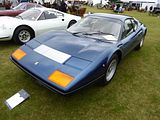
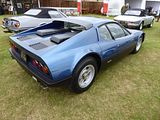
Created to honour Alfredo Ferrari, the late son of founder Enzo, the Dino was the first road going Ferrari to use a V6 engine. There were two models on show here, the initial Dino 206 GT and the later Dino 246 GT. Both were splendid, of course. the 206 GT, in red, was once the property of a certain Bernie Ecclestone, and this car has undergone a nut and bolt restoration before reaching the condition you see it in now. The white car is the later 246 GT, a car which made its debut at the Turin Show in 1969. A successor to the Dino 206 GT, it was powered by an enlarged 2.4 litre V6 engine, and featured a longer wheelbase. The elegant bodywork of the 246, often regarded as the prettiest ever to grace a road-going Ferrari, was designed by Pininfarina and built by Scaglietti. No wonder that prices for these cars have sky-rocketed in the last few years.
This 312 PB racer dates from 1972. Chassis # 0890, it is the 9th of 14 manufactured by Ferrari between 1971 and 1973, and it has been raced extensively, competing in 11 major endurance races winning the 1972 Spa 1000 Km, Imola 500 and Kyalami Nine Hours events. It was campaigned until the last World Sportscar Championship race entered by Ferrari’s works team, the 1973 Watkins Glen Six Hours.
FRAZER NASH
Winning the “Most Original Pre War” title was this 1935 Frazer-Nash “Shelsley” TT Replica owned by Gordon McCulloch. Chassis # 2152, it was specially built by the Factory for their works driver AFP Fane and during 1935/36, the combination of car and driver was almost unbeatable in is class of sprints, hillclimbs and races. This model features in the authoritative book on the marque, penned by the late Dennis Jenkinson, “AFN: from Chain Drive to Turbocharger”, where he refers to it as “The Nash to end all Nashes”.
GOLDMANINI
This 1955 car was the winner for the Most Sensitive Restoration award. I confess I had no idea what the car was, and when I saw the name, was little the wiser! Penned by Michelotti, it was originally designed for SCCA racing. The body was mounted onto the chassis at Carrozzeria Motta in Turin before being sent to the USA for final assembly by racer Max Goldmann, where it received a highly tuned Fiat 1100 engine from Fiat and Ghia importer Paul Farrago. After Goldman displayed the car at he Henry Ford museum in 1956, it was dismantled and laid up in Californian until 2011. The current owner bought it and took it to Thornley Kelham for a restoration which only started earlier this year. The end result is very impressive. This was the car’s first appearance since completion of the work.
JAGUAR
It was a Jaguar which won the “Best of Show” award in 2014, and the marque was successful again in 2015. Winner this year was the 1952 XK120 Jabbeke, owned by Mr. Kurt A. Engelhorn. This car, which started life as a regular XK120 works competition car was modified to improve its aerodynamics, which then enabled it to be clocked at 172.4 mph on the Jabbeke highway in Belgium, a road that was used for record breaking attempts in the 50s. The driver on that occasion was Norman Dewis, Jaguar’s Chief Development Engineer, who is still with us, aged 95 but sounding and acting like he is only half that age. The car was later sold by the factory, and after a club-racing life, was forgotten about, until being found recently, and restored by JD Classics.
No Concours is really completed without an example of the E Type, a car that Enzo Ferrari described as perfect in all but one regard – that it lacked a Ferrari badge on the front wing! This 3.8 litre Coupe model is a very early car indeed, the fifth right hand drive model to be made, and built in August 1961. In 1992 the car took part in an invitation only event at the Ford Edsell Estate in Detroit where it was awarded the Blue Ribbon. The car returned to the UK in 2012 at which point it was purchased by its current owner.
LAMBORGHINI
Thought by many to be the first true “supercar”, the Miura P400, first seen at the 1966 Turin Show, is still a real show stopper, with amazing looks complemented by a thunderous transversely mounted 3.9 litre V12, as had been used in the 400GT, which produced 350 hp. The early Miuras were known as the P400, and 275 of them were made between 1966 and 1969. This particular Miura was the 193rd to be built in Sant’Agata and it was originally finished in white with a black vinyl interior. The car’s current owner had a renowned Lamborghini expert travel with him in order to thoroughly inspect the car before purchase. Once the authenticity, originality and completeness of the car was confirmed, it entered into a full restoration with an emphasis on retaining and using as many original components as possible. That the car is still a head-turner was recognised by this 1968 model belonging to Adrian Marshall collecting the “Most Exciting Design” award at the Concours.
LANCIA
Considered by many to be one of the most beautiful cars ever produced by Pininfarina is the Aurelia B24 Spider. The car made its debut at the 1955 Brussels Motor Show, and was then built in very limited numbers for just one year. Just 240 were made. This car is the 9th example built and one of only two black right hand drive cars. A Cabrio version of the model, without the wrap around windscreen was made for a couple of years after this one, but it is the Spiders which really attract the big money on the rare occasions when they come up for sale.
This is another of those one-off cars that had been forgotten about for a long time, stashed in the workshop of Italian rally champion Claudio Maglioli. It is a 1964 Lancia Sport Prototype Zagato, a unique creation with a lightweight body and numerous weight-saving measures. After a brief racing history, the car was sold in 1967 to Claudio Maglioli and it has been subject to a meticulous restoration. It is an important and unique piece of Lancia racing history.
MASERATI
Introduced in 1959, the 3500 GT Spyder was the creation of Giovanni Michelotti, the star designer at Vignale at the time, and what a fabulously elegant looking car he produced. This particular examples is fresh from restoration and was making its global Concours debut here.
OLDSMOBILE
Oldest car in the Concours was this 1902 Curved Dash Two Seater Runabout. manufactured in Lansing, Michigan, the Curved Dash was the first car mass produced from an automotive assembly line. This car, chassis # 6579, has participated in many events including the 2012 Jubilee Run and the 2014 LBVCR. Well known racer and car enthusiast, Joy Rainey, drove her own car, very similar to this one, from coast to coast across America in 30 days, and her car also performed faultlessly on the gruelling drive, proving that these early cars are pretty tough.
PORSCHE
1964 Porsche 904 GTS This spectacular Porsche 904, number 055, has a rich competition history. The car was delivered new to Ben Pon in May 1964 and it was one of a pair of 904s that were run by Racing Team Holland (RTH) in the 1964 and 1965 European GT Championship. The car’s first race was the 1964 Nurburgring 1000km where Ben Pon partnered Gerhard Koch and they finished a remarkable 3rd overall, this feat was particularly impressive as the 904 had to compete against a field of cars which sported bigger and more powerful engines The car also took part in Le Mans and is in outstanding condition overall.
1973 Porsche 911 Carrera 2.7 RS. Revealed at the 1972 Paris Auto Salon, the Porsche 2.7 RS is one of the most collectible Porsches ever produced. The 2.7 RS was considered to be an upgrade of the earlier Porsche 911, the RS however, had more of a racing focus as Porsche’s engineers reduced weight and added power. Capable of reaching a top speed in excess of 150mph, the Porsche’s powerful 2.7 litre engine and low curb weight of just 2,370 pounds ensured that it attained status as the fastest German road-going car of its day. Equipped with wider rear wheels and arches, larger brakes, upgraded suspension and the defining ‘duck-tail’ spoiler, the Porsche 2.7 RS is a driver’s dream.
Dating from 1973, this 911 2.8 RSR is 1 of just 49 Carrera RSRs built in the same year. This car finished 4th in the Sebring 12 hours, and also competed successfully in the USA IMSA GT Series for many years under Jim Cook racing. It was presented at this event in its original pale yellow colour and in amazing condition.
ROLLS ROYCE
The Silver Cloud, Rolls Royce’s stately saloon sold between 1955 and 1965 is familiar to most people, but this is one with a difference. HJ Mulliner, in conjunction with Harold Radford offered a conversion of the regular saloon model into this “Countryman” for those who wanted something a little more practical, for transporting bulky loads and when going shooting or hunting. This particular car was ordered by the Rolls Royce dealer of New York, JS Inskip, to be displayed at the 1959 New York Auto Show.
TALBOT LAGO
One of just 36 T26 Grand Sport Talbot Lago models produced between 1947 and 1953, this incredible right hand drive example was bodied by one of France’s most flamboyant coachbuilders, Jacques Saoutchik of Neuilly-sur-Seine in Paris. Saoutchik’s distinctive style is recognisable in the bright applique that adorned so many of his bodies, highlighting the dominant lines of the coachwork.
HYPERCARS
Yet another of the attractions of the event was the promise that visitors would see several of the very latest hypercars up close. True enough, right in the centre of the VIP area, there were several cars the like of which you hardly ever expect to see once their initial tour of motor show duty is over. It was whist drooling over these, for the umpteenth time, that I spotted someone who has already driven some of them having a good look as well. He turned his face just as I pressed the camera shutter, but in case you do not recognise him, this is Tim Burton, better known in online circles as Shmee150.
Aston Martin Vulcan: Born out of Aston Martin’s rich racing heritage, the Vulcan is their most extreme creation to date and is utterly breathtaking. The car was first seen at the 2015 Geneva Show, taking everyone by surprise, as its existence had been successfully kept under wraps. Designed for the track, in the same way as the Ferrari FXX and the McLaren P1 GTR are purposed designed for racing, and it is fully FIA compliant, but it is not (despite some commentators asserting otherwise) road legal. Unlike those other cars, though, customers will be able to keep the Vulcan where they want. One of the principles for this car which is designed 100% for the lucky owner who can afford it and who wants to have fun with it, is to make it as easy as possible, so Aston will look after and transport if required, but they will not insist. It has also been designed to make it easy to drive, with the ability to increase the power available, as your confidence grows. Be in no doubt that this is a technical tour de force, the most impressive thing, from a long list of things which make you go “wow” is the downforce that it generates at 200 mph – nearly 1300 kg, or the weight of the car! Built around a carbon fibre tub and featuring bespoke suspension, a full carbon fibre body and a progressive power programme for the engine to allow the driver to build up to the full 800 bhp generated by the most powerful version of the naturally aspirated 7.0 litre V12 engine, as they build up to finding out what 1300 kgs of down force feels like at 200mph, it sports an Xtrac gearbox with straight cut gears and a sequential change. Work only started on the car last summer, and a surprisingly small number of people have been involved in creating it, but it is not finished yet. For instance, currently there is no interior, but we were told that there will be a fully customisable package for the specification and colours. It will be limited to just 24 examples worldwide, with the first deliveries expected before the end of 2015. Utterly Astonishing! With an all-carbon fibre body the Vulcan promises incredible performance, with a sub 3.0 second 0-60mph time and is an engineering masterpiece.
Ferrari FXX K: The track-only version of the Ferrari La Ferrari, the FXX K, is an astonishing technical achievement and it is Maranello’s most powerful creation to date, being the first Ferrari to produce more than 1000bhp. Power is delivered via a V12 engine producing 860bhp and an electric motor which produces 190bhp. This combination provides torque in excess of 900nm. The car also adopts a kinetic energy recovery system (KERS), the same technology used in today’s F1 cars. The select few who are lucky enough to own an FXX K will undertake an exclusive dynamic test programme with Ferrari. This is truly one of the most exciting cars the world has ever seen. On the day I visited, it was displayed with the other Supercars in the Courtyard.
Koenigsegg: Final car supplied by Chubb Insurance was an example of the Swedish supercar brand, Koengisegg. there have been quite a lot of different models since the marque made its first appearance in 2001. This one is an Agera S, one of just 5 that were built between 2012 and 2014. The Agera S was created specifically for markets where E85 fuel was unavailable and thereby rendered the power enhancing flexfuel function of Agera R meaningless. In all other respects, the Agera S had all the features and functions of the Agera R. The Agera R was launched a year previously, in 2011 and 18 examples were made before “production” ceased in 2014. The Agera R built upon the features and functionality of the base Agera with new, unique solutions to enhance both performance and visual appearance even further, which included: visible carbon on the front bonnet and bumper, new front side winglets, an all-new Aero exhaust, increased engine power with a raised RPM limit. Koenigsegg had been the first Hypercar manufacturer to take steps toward green technology with the release of the biofuel CCXR in 2007 and the Agera R, based on the critically acclaimed Agera, followed in the footsteps of the CCXR as it also ran on biofuel. The Agera R had an upgraded fuel and engine management system that allowed it to run between 95 Octane and E100 biofuel, or any mix in between. The engine management system senses the fuel mixture and can adjust the engine’s operation ‘on the fly’. The Agera R’s fuel system has enough flow capacity to generate 1140hp and 1200Nm of torque on E85 and E100 biofuel. As there is less energy content per given volume in these biofuels compared to normal petrol, the fuel system has to manage a flow that is similar to a 2000hp petrol engine, which means that the Agera R’s return-less fuel system had the highest capacity of any car in production at the time. As 95 octane fuel has less octane than ethanol E85, the power is reduced to 960hp with 1100Nm of torque due to the boost pressure and ignition timing being altered to match the fuel characteristics. In order to give the Agera R maximum flexibility when it comes to power delivery, Koenigsegg has implemented the latest technology when it comes to turbo materials and design. This reduces the inertia of the turbine wheel and axle and therefore gives improved response. The Agera R also saw the debut of Koenigsegg’s own ceramic piston brake system. In 2011, the Agera R set a new world record for driving 0-300-0 kph. The time of 21.19 seconds was only eclipsed in 2015 by the Koenigsegg One:1. When it came to the Agera As, despite not running on high-octane biofuel, Koenigsegg still managed to extract an amazing 1100Nm of torque and a full 1030hp from the 5-litre Bi-turbo V8 when run on 98 octane RON or 93 octane DIN. The Agera S was also the first Koenigsegg to feature the truly revolutionary Koenigsegg developed and produced Hollow Space Carbon Fibre Aircore wheels. The Agera S had an incredible top speed of over 400 km/h. It ran on regular Petrol and came with an optimised for petrol only 1040 hp twin turbo engine.

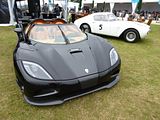
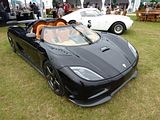
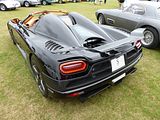
Also seen here is one of the 7 examples of the One:1. This version was introduced in 2014, and production was capped at seven examples, plus one prototype, making it one of the most exclusive production car programs ever seen in the car industry. The hp-to-kg curb weight ratio is an astonishing 1:1, which is the origin of the name of the car. This is the “dream” equation, previously thought impossible when it comes to fully road legal and usable sports cars. The One:1 is the first homologated production car in the world with one Megawatt of power, thereby making it the world´s first series produced Megacar. The One:1 truly raised the performance bar. The One:1 featured new, unique solutions to enhance track performance without compromising top speed or everyday usability, with a stunning visual appearance to go with it, and these included: unique track-optimised aero winglets, extended venturi tunnels and side splitters, Le-Mans inspired active wing configuration and optimised active under trim air management. Large air vents for improved cooling, roof air scoop to support the 1 Megawatt of power, 8250 RPM rev limit, complemented with custom-made Michelin Cup Tires, upgraded rear Triplex suspension with carbon bevel springs and active shock absorbers and ride height, combined with upgraded revolutionary Koenigsegg Aircore carbon fibre wheels. Koenigsegg was the first extreme car manufacturer to take steps toward green technology with the release of the biofuel CCXR in 2007. The One:1, a sibling of the highly competitive Agera R, follows in the footsteps of the CCXR as it also runs on E85 biofuel, race fuel or normal gasoline.
McLaren P1 GTR: The McLaren P1 GTR is the most powerful and most exclusive model built by McLaren to-date. Underlining its track-focus and performance capabilities, McLaren has resurrected the iconic ‘GTR’ name 20 years on from the famous victory of the McLaren F1 GTR at the 24 Hours of Le Mans. The track-only model is fitted with a 3.8-litre twin turbo V8 petrol engine, producing 800PS, coupled to an integrated lightweight electric which generates an additional 200PS, combining to deliver 1,000PS. This power is transferred to the track via race-proven Pirelli slick tyres, working with optimised aerodynamics, including Formula 1-derived DRS (Drag Reduction System), to offer the ultimate track experience. Drivers of the limited production model become members of the world’s most exclusive McLaren ownership programme. The McLaren P1 GTR Driver Programme offers a unique insight into the steps McLaren drivers take after signing for the team, as each driver has access to race-winning expertise and bespoke world-class training. This programme is designed to hone and optimise driving skills at some of the most iconic circuits across the world, as drivers learn how to get the best out of themselves and the car.
Pagani Huayra: Final car in the Hypercar Collection of the event was the Pagani that we all have trouble in pronouncing. Launched at the Geneva Show in 2011, the Huayra is an Italian mid-engined sports car that succeeded the company’s previous offering, the Zonda. Costing €1,198,000, it is named after Wayra Tata, which means “God of the winds” in Quechua, the official language of the Inca Empire. The Huayra was named “The Hypercar of the Year 2012” by Top Gear magazine and received a very positive review when tested by Richard Hammond on Top Gear. The Huayra is currently the fastest road car to go around the Top Gear Test Track, setting a time of 1:13.8, beating the previous record of 1:15.1 set by the Ariel Atom V8 in January 2011. It was used in the movie Transformers: Age of Extinction as the KSI prototype turned Decepticon Stinger. The Huayra uses a twin-turbo, V12 engine developed by Mercedes-AMG specially for the Huayra. The Huayra’s 6.0-litre engine, the M158, produces 720 bhp and 811 lb·ft of torque. Its top speed is about 238 mph and it has a rating 0–62 mph of 3.0 seconds. Using Pirelli tires, the Pagani Huayra is capable of withstanding 1.66 g of lateral acceleration at speeds of up to 230 mph. The Huayra uses a seven-speed sequential gearbox and a single disc clutch. The choice not to use a dual-clutch in an oil bath was due to the increase in weight of over 70 kg, thus negating any advantage of the faster gear changes in a double-clutch transmission. As a result, the entire transmission weighs 96 kg. The car is equipped with Brembo brake calipers, rotors and pads. The calipers have four pistons in front and four in the rear. The rotors are drilled carbon ceramic, 380 mm in diameter and 34 mm thick. Mercedes-Benz’s AMG division provides the engine of the Huayra which is hand-built. The 5,980 cc, twin-turbo, 60° AMG M158 V12, has been designed at the request of Pagani to reduce turbo lag and improve response, realised with smaller turbos, a different intercooler configuration and re-programmed ECU settings. Like many high-performance cars, the Huayra uses dry sump lubrication. This has several key benefits including guaranteeing oil flow even when the car is subjected to extreme lateral acceleration, preventing “oil surge” which allows the engine to operate more efficiently while the lack of an oil pan allows mounting the engine lower, lowering the car’s center of gravity and improving handling. The fuel consumption of the Huayra is 10 mpg in city and 14 mpg on the highway. A water / oil heat exchanger reduces engine warm-up times on cold days and helps maintain a stable temperature for refrigerants and lubricants. To minimise the use of pipes and fittings (and the overall weight of the vehicle), the expansion tank is mounted directly on the engine. Intercooler fins act as an expansion tank circuit at low temperatures. The titanium exhaust system was designed and built by MHG-Fahrzeugtechnik. Hydroformed joints were developed to reduce back pressure and ensure a free flow exhaust. Titanium reduces the weight of the exhaust system while the Inconel silencers improve reliability in the most exposed parts of the exhaust at high temperatures. The entire system weighs less than 10 kg. The Pagani Huayra is different from its predecessor in that it incorporates active aerodynamics. It is capable of changing the height of the front from the ground and independently operating four flaps placed at the rear and front of the car. The behaviour of the flaps is managed by a dedicated control unit that is fed information from systems such as the ABS and ECU, which pass on information about the car’s speed, yaw rate, lateral acceleration, steering angle and throttle position. This is intended to achieve minimal drag coefficient or maximum downforce depending on the situation. The Huayra’s designer Horacio Pagani states that it has a variable drag coefficient of between .31 to .37. The system also prevents excess body roll in the corners by raising the “inside” flaps (i.e. the left ones in a left-handed corner and vice versa), increasing the downforce on that side of the car. The rear flaps also act as an airbrake. Under hard braking, both the front suspension and the two rear flaps are raised to counteract weight transfer to the front wheels and keep the whole car stable, for instance when entering a corner. Air from the radiator is extracted through an arch in the bonnet at an angle that is designed not to affect the streamline around the body. The side air intakes behind the front wheels create a low pressure zone, resulting in downforce. On February 11, 2015, it was reported that the Pagani Huayra has been sold out, as the Huayra was limited to just 100 units as part of Pagani’s agreement with engine supplier Mercedes-AMG.
CONCEPT CARS
As in 2014, there were a number of Concept Cars on show, most of which had been seen at various other shows in recent months.
ARASH
The AF8 was making its debut. There is a whole load of marketing and PR guff about sports cars needing to have distinctive and individual character which goes with the announcement of the presentation of this car, which frankly, we can and indeed should all be spared Of more interest is that the car has been created by the same person who brought us the Farboud GT and GTS and the Arash AF10.
ASTON MARTIN
I had seen the DBX Concept before, as it made its debut at the Geneva Show in March. It’s undergone a repaint since then, and I think the pale blue suits it better than the grey did which was how I saw it on the Aston-Martin stand back in the Spring. An all-electric concept, all the indications are that Aston will be building something not unlike this in the coming years, although when it was first shown, Aston Martin were at pains to point out that it was just a Concept and not a thinly veiled production car. It was produced to show what could be done, and to test reactions. It is quite likely that some elements, which could be styling lines, or details, will appear on future products, but it is very unlikely that the car as it appears would enter production. The is not the first SUV concept that Aston have produced as there was another one, called Lagonda which was shown at the 2009 Geneva Show, which got an almost universal thumbs down as it was a bloated, and ungainly looking device with no visual appeal. It is clear that Aston listened to what people liked and what they did not, and that horror has not seen the light of day since. The DBX is a complete rethink of what an SUV Aston-Martin might be and plenty that is new in this for the marque, as the DBX is an all-electric, all wheel drive model, with big doors, a flat floor and no sills, and ground clearance the same as you get with a Range Rover Evoque. There are four inboard-mounted electric motors, each driving one wheel. Power flows from lithium sulphur battery packs mounted low along the north-south spine of the chassis. This gives all-wheel traction for low-grip situations and sophisticated torque-vectoring and traction control as the car corners and accelerates. Steering is drive by wire and the brakes are carbon ceramic discs with a built in KERS systems. The lights are LEDs, the windscreen is made from auto-dimming smart glass and there are separately configurable head-up displays for driver and passenger. Overall length is around 4.3m and the height of 1.7 m, similar to a conventional saloon.
FORD
Supposedly, the new GT Concept, that had been a complete surprise at the North American International Auto Show in Detroit back in January was here. Indeed, I found the tented area where it was supposed to be housed. The front was all closed off, but I did peak through, only to find an empty parking space. Clearly, it had gone by the Saturday. What a shame.
TOROIDION
Toroidion was established in 2011 to develop an entirely new electric powertrain that would be competitive at the Le Mans 24-hour race. The design team have now produced their first proof-of-concept electric supercar, the Toroidion 1MW Concept car, which is street-legal and it was making its debut at this event. It has been designed, developed and built entirely in-house in Finland, and the first exclusive (for which, read expensive) production cars are estimated to be delivered in 2017.
VOLVO
Volvo have shown us three concept cars in the last couple of years, and all three of them are particularly attractive. All three where on show here. First of three to appear as the Concept Coupe, which was produced to show the design possibilities of the new Scalable Product Architecture (SPA) that will underpin all the Swedish marque’s future models. The second model that Volvo produced as the Concept XC Coupe, which it is said was inspired by the design of modern sports equipment, and which was intended to demonstrate the safety capabilities of the new SPA Architecture in “a sophisticated car for people with an active lifestyle”. The third of the trio is my favourite, and when I saw it, I said “just build it”, fearing that Volvo probably won’t. The Concept Estate shows how the interior of future Volvo models could look and function. Never mind that, it is the external styling that does it for me. A real modern version of the 1800ES and even the 480ES of the 1980s.
DEALER AND DISPLAY CARS IN THE ENCLOSURE
The outer perimeter of the VIP area was taken up by all manner of dealer stands. These ranged from a number of the higher end car manufacturers, to many of the well known dealers in costly classics, as well as accessories and life-style purveyors, even wine merchants and art dealers.
ABARTH
I can actually claim that I have driven the very car which was on the Abarth stand. It is a 695 Biposto, and is the press fleet car which was on duty at the Canary Wharf Expo back in June, which is when I got the chance to get behind the wheel. Since that time, I’ve seen it featured in Auto Express, as well.
ALFA ROMEO
I came across this achingly pretty Giulietta Sprint 1300 parked up round the back of some of the trade stands.
ALPINA
The BMW Z8 is a rare car in its own right, but rarer still is the Alpina version, the Roadster V8, and it was one of these that I found at one of the dealers. “Regular” BMW Z8 production finished in November 2002, and for 2003 the model was replaced by the Alpina V8 Roadster. The Alpina was a departure from the hard-edged sporting focus of the original car, and elements of the new grand touring intent were evident throughout this final edition. Instead of the original six-speed manual and 4.9 litre (S62) engine featured in earlier Z8’s, the Alpina came only as an automatic, using a five-speed BMW Steptronic transmission allied to a downgraded 4.6 litre Alpina-tuned V8 motor from the Alpina E39 B10 V8 S (M62). In order to complete the car’s transition from sportscar to boulevardier, relaxed suspension tuning was used. The standard Z8’s run-flat tyres and 18″ wheels were discarded in favour of conventional tyres with softer sidewalls, and 20″ wheels. A new, softer grade of Nappa leather replaced the Z8’s less supple specification, and special Alpina gauges were featured on the dash cluster. An Alpina steering wheel with three solid spokes replaced the original, which could not be retrofitted with shift paddles for the automatic. Gear selection was displayed in an Alpina-specific display mounted in front of the wheel. Performance of the Alpina V8 differed from that of the standard car in that peak power was reduced to 375 hp while peak torque was raised to 383 lb·ft, this torque was available at significantly lower rpm than the original in order to enable more relaxed cruising. Curiously, the electronically limited top speed was officially raised to 161 mph. 555 of these Alpinas were built, 450 of which were exported to the U.S. market and only eight to the UK. In the United States, this special edition of the Z8 was sold directly through BMW dealerships, marking a first for Alpina, whose cars had never been sold through retail channels in the US.
ASTON MARTIN
Highlight here was one of the DB10 models that has been made specifically for the latest James Bond movie, Spectre. Following reports that Aston Martin was producing something special for the 24th Bond film, the DB10 was unveiled by Sam Mendes and Barbara Broccoli, the director and producer of Spectre, as part of the official press launch of the film on the 007 Stage at Pinewood Studios, on 4 December 2014. Mendes introduced the car as “the first cast member”. According to the film’s producers, Eon Productions, the film would feature the Aston Martin DB10 as its starring car, continuing the partnership with Aston Martin which started 50 years ago., with the DB5 being used in the 1964 film Goldfinger. Shortly after the unveiling ceremony in Pinewood Studios, Aston Martin also took part in the launch of the Bond in Motion exhibition at the London Film Museum in Covent Garden, London. The DB10 design was led by Aston Martin’s chief creative officer Marek Reichman, with the film’s director Mendes working closely with the team. The car was developed specifically for the film and just ten units will be hand-built in-house by the company’s design and engineering teams in Gaydon. The DB10 will not be sold to the public, though Aston Martin have stated that “the DB10 gives a glimpse to the future design direction for the next generation of Aston Martins.” Few technical details of the car have been released, but it has been announced that the DB10 features the company’s 6-speed manual transmission unit that is used on their V8-engined cars. The car’s chassis is based on a modified version of the VH Platform that underpins the V8 Vantage. However the DB10 has a longer wheelbase and is nearly as wide as the One-77. It is powered by the Vantage’s 4.7 litre V8 engine.
Whilst the DB10 was the star of the Aston display, it was by no means the only car to generate interest. There was a nice contrast between road and race cars with three cars parked up in a line: the road-going Vantage V12S, the latest version of Aston’s “entry level” car, along with the Vantage GT12 that was launched at the 2015 Geneva Show, and which sold out almost instantly, along with the car which competes in GT3 racing.
The DB9 GT was launched earlier in the year, as a final fling for the car which was first launched in 2004 and which will be replaced by the DB11 during 2016. Although the outline of the car has not changed in the last eleven years, a lot of the details have, so your late model DB9 is quite different from an early car.
Also on show was the Rapide S, the heavily revamped version of Aston’s four door model which was added to the range in 2012.
There were a number of older Astons to be found among the Classic Car Dealers, and all of them were lovely, even if none of them were cheap. A couple of DB4 models were really rather nice, but in my opinion, the DB6 Volante is even nicer. Open topped Astons of the DB4 – 6 generation are now seen as highly desirable and the prices have rocketed, so you would need very deep pockets to afford this one.
Rather less unaffordable were the more recent cars, a V8 Coupe and – for those who seek something rather different – one of the Series 4 Lagonda cars of the 1980s.
Featured inside the Chubb marquee was this car, 1VEV, perhaps the most of famous of the 19 DB4 GT Zagato models which were built in 1962.
BAC
The Briggs Automotive Company (BAC) is a British sports car manufacturing company based in Speke, Liverpool, founded in 2009 by brothers Neill and Ian Briggs to produce specialist sports cars targeted at enthusiasts. The company’s first vehicle is the Mono, which was conceived with the objective of creating a pure driving experience with a central-seat format. The Mono, a single seater road-legal sports car, was launched in 2011, the result of a team effort with engineers from Cosworth, Hewland, Sachs, AP and Kumho Tires all partnered with designers at BAC. The Mono uses carbon fibre composite construction over a steel chassis (with FIA compliant rollover structure) inspired by the construction principles employed in DTM race cars. The nose of the vehicle provides a storage compartment and doubles as impact protection. The Mono is powered by a 2.3-litre four-cylinder Cosworth engine producing 285 bhp and 206 lb·ft a heavily modified Ford Duratec The engine is mounted longitudinally to maintain the centralised balance of the car. The car runs a F3-specification six-speed sequential gearbox developed by Hewland. This gearbox operates a semi-automatic transmission tuned to complete gear shifts in 35 milliseconds. These specifications result in a 0–62 mph time of 2.8 seconds and a top speed of 170 mph. Weight-distribution in the Mono is focused on maintaining a low centre of gravity. The system includes a fully adjustable pushrod suspension system with damping elements made by SACHS Racing. AP Racing developed the retardation and stopping ability of the car. The Mono runs on specifically designed Kumho V70A road tyres. During production, each vehicle is custom-built around the purchaser’s body shape. The size of the seat, pedal reach and steering wheel position are modified in order to suit the individual’s ergonomic requirements. The Mono ran 1:14.3 at the Top Gear test track. This makes it the one of the fastest cars to go around the Top Gear track on road legal tyres. In late 2012, the BAC Mono was featured in Need for Speed: Most Wanted. The BAC Mono also appeared in GRID 2, Driveclub in 2014, and Project CARS and Forza Motorsport 6 in 2015.
BENTLEY
Bentley’s own stand had a trio of their latest models on show. Undepicted is the Mulsanne, and there were also a Continental GT Coupe and the open-topped GTC
From a much earlier era was this fabulous 3.5 litre Derby Bentley of the late 1930s.
DAVID BROWN
The David Brown Speedback, a modern take on the classic Aston Martin DB5 is a limited edition Grand Tourer which combines classic styling with contemporary performance and technology. It made its debut in Monaco in April 2014, and the initial feedback expressed by many, me included, was that the styling did not seem quite to work, and that if the car’s eponymous founder (no relation of the original David Brown who owned Aston Martin in the 1950s through to the 1970s) thought that even 100 people would want to part with £600,000 for this pastiche car, then he was far more optimistic than me. However, those early pictures probably did it no favours, as once I had had the chance to see the car in the open rather than the studio, which I have done a number of times now, and especially when you see the sumptuously produced interior, you will probably change your mind. I certainly did. Based on the underpinnings of a modern Jaguar XK, the styling does remind you of the iconic DB5, but it is sufficiently different to persuade you that it is a design all of its own, and it looks good from most angles. The interior really does look and feel special, befitting the price tag. Indeed, the whole vehicle is reminiscent of Britain’s coachbuilding heritage. Using an acclaimed and proven British rolling chassis and drivetrain, each bespoke lightweight aluminium panel of the body is hand-beaten over highly accurate machine-milled bucks and rolled over an English wheel, before being bonded and riveted to the hard parts of the rolling chassis. The interior of the car comprises the finest British materials including English wood veneers and Scottish leather. There is an unexpected party trick is at the back of the car where as well as a large conventional tailgate, there is a small drop down flap, which once lowered then allows you to flip up a small rear-facing seat, which would be just perfect for an a day at the races or some other outdoor occasion. £600,000 is an awful lot of money, but I am now far more convinced that selling the planned 100 units may not be that hard after all.
FERRARI
This LaFerrari, one of several that were present on the day, was parked up just to the right of the entrance to the VIP area.
There was another LaFerrari on Ferrari’s own stand. Slightly surprisingly, it was not the car that was attracting the most interest. That car was the new 488 GTB, and I would guess that quite a lot of the people who were giving it a very close inspection were serious buyer prospects. It was joined by the latest California T and a F12 Berlinetta in a rather bold colour scheme.
There were numerous classic Ferrari models for sale among the dealers such as Joe Macari, DK Engineering, Furlonger, Tom Hartley and others. These ranged from of the special hypercar models such as the F40, Enzo and 288 GTO to some of the iconic 12 cylinder cars such as the BB512 and its predecessor, the 365 GTB/4 Daytona and the more recent F430 Scuderia.
Older Ferrari models for sale included a 246 GT Dino and the 275GTB and the 275 GTS.
On a smaller scale, this miniature 250 GT California Spider, one of a whole series of faithful replicas of cars of the period, was creating lots of interest as it was driven around the site.
FORD
Two quite different Fords were up for sale: a GT from the last 10 years and a Mustang 350GT from the mid 1960s.
JAGUAR
Jaguar are providing support to the Bloodhound program, and a couple of their models have been painted in the distinctive colours of this great hope of a British car setting a new World Land Speed Record. This is the F Type version.
JENSEN
For the Interceptor that Jensen launched in 1966, to replace the gawky CV8, the West Bromwich concern went to the Italian firm Carrozzeria Touring for some styling assistance, and the result is generally agreed to be highly successful. This large car with a massive wrap around glass rear window was quite practical compared to many of its rivals and the thumping great Chrysler V8 under the bonnet gave it the go to match the looks. The car underwent a number of upgrades through the years, reaching the Series 3 by 1971, with the latest 7.2 litre engine, standard air conditioning, and a number of other detailed changes. Around 6500 Interceptors, including the potent SP and the all wheel drive FF models were made. A convertible with powered soft top was introduced in 1974. Mainly intended for the American market, it was also sold in Europe. 267 convertibles were made. Rarer still is the Coupé version introduced in 1975, just 60 of which were made before the company’s demise. The Coupé was derived from the convertible and therefore lacked the distinctive rear window of the regular car. Seen here is one of those Convertibles.
That 1976 bankruptcy was not the end of the Jensen story, though. A group of investors stepped in and re-launched production of the Interceptor, which was briefly re-introduced in the late 1980s as the Series 4 (S4). The car came back as a low-volume hand built and bespoke affair, marketed in a similar way to Bristol, with a price of £70,000 and more, to match. Though the body remained essentially the same as the last of the main production run of Series 3, the engine was a much smaller Chrysler supplied 5.9 litre which used more modern controls to reduce emissions comparatively and still produce about 250 hp. In addition, the interior was slightly re-designed with the addition of modern “sports” front seats as opposed to the armchair style of the earlier models, as well as a revised dashboard and electronics. The then owner sold up in 1990 to an engineering company believed to be in a stronger position to manufacture the car which lasted until 1993 with approximately 36 cars built, and while work commenced on development of a Series 5 (S5) Interceptor, once again receivers were called in and the company was liquidated. But the Interceptor is one of those cars with enduring appeal, and not only is there a thriving market for specialists such as Cropredy Garage to undertake comprehensive restorations of the cars, but the latest venture enables you to buy an Interceptor R, an example of which was on show here. These are created by a subsidiary of Cropredy Garage, Jensen International Automotive which as set up, with the financial backing and know-how of Carphone Warehouse founder and chairman Charles Dunstone who joined its board of directors. A small number of Jensen Interceptor Ss, which had started production under a previous company, are being completed by Jensen International Automotive (JIA), in parallel with JIA’s own production of the new Jensen Interceptor R; deliveries of the latter started at the beginning of 2011. These are rebuilds of original Interceptors using modern components, with a General Motors supplied supercharged 556 bhp 6.2 litre LS3 engine and 6 speed automatic transmission from a Chevrolet Corvette. All new front brakes, revised front geometry, a limited slip differential, adjustable dampers all around, bespoke 17″ alloys and Racelogic variable traction control complete the mechanical changes, and inside there is a bespoke new interior with revised heating and climate control, electric seats and mirrors, Bridge of Weir leather and Wilton carpets.
LAMBORGHINI
Lamborghini have two models in their range at present, the V10 engined Huracan and the V12 Aventador, and there were examples of both of these on the Lamborghini stand.
Among the used Lamborghini models was this 1983 Countach 5000S model, offered by Furlonger. Amazingly, the car has covered just 523 miles.
LANCIA
Displayed by renowned Lancia specialist Thornley Kelham was this Lancia Aurelia “Outlaw”. For those who are not familiar with the “Outlaw” term, it is applied to cars outside the mainstream series. Though this particular conversion had not been done before, the seeds were sown with the factory’s chop top racers of the 1950s, of which the ex-Mille Miglia ex-Le Mans, ex-Carrera Panamerica Bracco racer, a car recently restored, is the best known example. Thornley Kelham were responsible for that restoration, and it clearly got them thinking about creating some more. There are those who will decry the act of taking an Aurelia Coupe, a valuable classic not exactly in plentiful supply and altering it, but that argument could be applied to any one-off or custom creation, and some research suggested that there would be demand for the finished product where they to go ahead. And so, with a well-known California-based collector sharing the same vision for such a conversion, Thornley Kelham took one of the very scruffy Aurelia Coupe cars that they had “in stock” awaiting a potential restoration. It is a Series 6 car, one of the less highly prized (that’s a relative term!) among Aurelia cognoscenti. Just about every square foot of sheet metal has been changed, representing 1400 hours of work. All four wings have a gentle swell, made from scratch, by hand while the rear quarters are new. The door frames are bespoke and there are no rain gutters and a minimum of brightwork, along with no front indicators, or bumpers. It rides on custom-centred Jaguar D-Type style Dunlop alloys shod with Avon ZZs, beloved of racers. The front screen is custom-made, whilst the rear one is the original. Details go as far as cutting down the length of the doorhandles, following Nardi practice on competition Aurelias back in the day. Inside it is a bit more “hot rod”, with quilted leather, Porsche Speedster seats and Tilton pedals with brake-bias adjust. The wheel is Nardi, obviously and the Jaeger dials are standard but with the inner bezels painted black. There is a roll cage, but it is painted black and blends well with the body and dash colours. The engine is a 2.5 litre Flaminia V6, which has larger bores and a shorter stroke than the Aurelia unit, but bored out to 2.8 litres with three twin-choke Webers. With skimmed and ported heads it makes around 170 bhp. there are disc brakes all around, operated by Tilton hardware, one of a few modern touches that are well concealed and make the car that bit more practical in the modern age. Even before it was finished, a second car was planned, for a friend of the owner of this one. His car will be slightly different. Thornley Kelham could yet be persuaded to build a few more, but have said that 6 is the absolute limit.
LAND ROVER
The Land Rover display featured a couple of cars, a regular (if there is such a thing when the car is as special as this is!) Range Rover and a Range Rover Sport SVR.
LOTUS
The Lotus stand featured the latest Evora 400 and Exige models.
I saw another Evora 400 when cars were leaving the site at the end of the day.
MASERATI
When the time came to replace the 3500GT, the first “volume” road car Maserati, it was decided to produce two different cars. The first was a beautiful two door Coupe, the Frua styled Mistral. It first appeared at the Turin Show in 1963 and was offered with 3500cc and 3700cc engines. An open topped car was launched at the the Geneva Show the following year. In 1966 the engine was enlarged to 4 litres. Just 120 were made.
MERCEDES-BENZ
There were two splendid open-topped Mercedes offered for sale. Most familiar, perhaps, was the “Pagoda” 280 SL, and also here was a W111 280 SE 3.5 Convertible which had received a very thorough restoration.
PORSCHE
There were two examples of the Carrera GT on show here. The development of this car can be traced back to the 911 GT1 and LMP1-98 racing cars of the late 1990s, the career of both which had ended in 1998 not least due to FIA and ACO rule changes in 1998. Porsche had been planning a new Le Mans prototype for 1999, with the car initially intended to use a turbocharged flat-6, but later redesigned to use a new V10 engine, pushing the project back to planned completion in 2000. The V10 was a unit secretly built by Porsche for the Footwork Formula One team in 1992, but later shelved. The engine was resurrected for the Le Mans prototype and increased in size to 5.7 litres. The project was cancelled after two days of testing of the first car, in mid-1999, mostly due to Porsche’s wish to build the Cayenne SUV with involvement from Volkswagen and Audi, thus requiring engineering expertise to be pulled from the motorsports division. It was also speculated that VW-Audi chairman Ferdinand Piëch wanted Audi’s new Le Mans Prototype, the Audi R8 not to face competition from Porsche in 2004. However, Porsche did keep part of the project alive by using the 5.5 litre V10 from the prototype in a concept car shown at the 2000 Paris Motor Show, mainly in an attempt to draw attention to their display. Surprising interest in the vehicle and an influx of revenue provided from the Cayenne helped Porsche decide to produce the car, and development started on a road-legal version that would be produced in small numbers at Porsche’s new manufacturing facility in Leipzig. Porsche started a production run of Carrera GTs in 2004. Originally a production run of 1,500 cars was planned. However, Porsche announced in August 2005 that it would not continue production of the Carrera GT through to 2006, citing discontinuation was due to changing airbag regulations in the United States. By the end of production on May 6, 2006, more than 1,270 GTs had been sold, with at least 604 of those being in North America.
Also available for sale were a trio of pristine 356 models. I seem only to have taken pictures of one of them, a particularly lovely SC Cabrio.
ROLLS ROYCE
Rolls Royce Motors featured two cars on their stand, a Phantom Drophead and a Wraith
TRAMONTANA
The Tramontana is a Spanish single or twin seat sports car with styling inspired by open wheel racing cars. It is built by Advanced Design Tramontana in Palau de Santa Eulalia, Girona in Catalonia, and costs €500,000 or more. It was launched as a concept at the 2005 Geneva Motor Show, and subsequently modified for production. It features a mid-mounted twin turbocharged Mercedes-Benz 5.5 litre, double overhead cam V12 engine producing 720 PS. This is mated to a 6-speed sequential gearbox and rear wheel drive giving a top speed of 202 mph and a 0–100 km/h time of 3.6 seconds. The body and interior are a mix of aluminium and carbon fibre, while the 20″ wheels are a mix of carbon fibre and magnesium. The car weighs 1,268 kg (2,795 lb) and the suspension is an adjustable double wishbone suspension. If the two seat option is chosen, the passenger sits directly behind and slightly higher than the driver. The bonnet badge is made of solid white gold. Only 12 a year are manufactured. In 2009, Tramontana introduced a closed top model named Tramontana R, and this model was making its UK debut here. Sporting either a V12 Twin Turbo or V10 with varying outputs, each Tramontana is individually commissioned, and is a combination of the highest levels of technology available at the pinnacle of motorsport, resulting in a vehicle that is as striking as she is exciting. The car is fully road legal in Europe.
ZENVO
There was one of the Zenvo STI cars parked up just outside the VIP area, and another one on display inside. Everyone who came up to the first of these that I saw, whilst I photographing it was puzzled as to what it was, and the sight of the badge did not seem to enlighten many people. A custom-built sports car, with a myriad of options which allows the prospective owner to personalise their car, the Zenvo ST1 sports a ferocious 6.8 litre V8 engine which produces 1104bhp, enabling the car to accelerate from 0-100km/h in just 3.0 seconds. The ST1 is equipped with one of the most technologically advanced gearboxes in the world, with gear changes performed in an unbelievable sub 35 milliseconds. This is a world-record for a production car with non-double clutch transmission.
Over the 3 days, guests attending the VIP enclosure on the South Lawn were invited to select their favourite cars in 4 categories. Four winners were announced. Best Interior went to the Pagani Huayra. A car you might have thought would have won that accolade, the Rolls-Royce Phantom Drophead instead picked up the “Grace and Space” award. Most Sensational Supercar was declared to be the Lamborghini Aventador Roadster and the Most Spectacular Hypercar was the McLaren P1 GTR
THE SALON PRIVE SALE
Tucked away in one corned of the VIP area was a large marquee for Silverstone Auctions. Auction Houses usually restrict access to those who purchase an (expensive) catalogue from them, but on this occasion, there were no such limits, and there was free access to those in the VIP area, to see the cars not just in the marquee, but the large number that were parked on the other side of it. Even among this section of the event, there was plenty of interest and lots of very nice cars. Many of them sold, of course, and the winning bid prices were displayed on the cars. There appeared to be few, if any, bargains.
ALVIS
The TD21 was conceived in 1956 and was quite a departure from the lovely, but rather “post-war” TC21. However, on its arrival in dealer’s showrooms, it quickly set about changing established views of the Alvis. Following the loss of coachbuilders Mulliner and Tickford (who were now tied to other companies), Alvis turned to the Swiss coachbuilder, Graber whose tradition of producing sleek, modern and very elegant saloons and dropheads proved a good fit in terms of the way Alvis saw their future. Graber first presented this new style to the Alvis board in late 1957 who were very impressed with the Swiss company’s flowing design and commissioned the body to be built on the new TD chassis. To ease logistical problems, Park Ward of London, built the Graber designed bodies in the UK. The Alvis Three Litre TD21 Series I was produced between the end of 1958 and April 1962, and was powered by the TC’s 2993 cc engine, uprated by 15bhp to 115 as a result of an improved cylinder head design and an increased compression ratio. A new four-speed gearbox from the Austin-Healey 100 was incorporated, while the suspension remained similar to the cars predecessor, independent at the front using coil springs and leaf springs at the rear, but the track was increased slightly and a front anti-roll bar added. From 1959 the all drum brake set up was changed to discs at the front retaining drums at the rear. In April 1962, the car was upgraded with four wheel Dunlop disc brakes in place of the disc/drum combination, aluminium doors, a five-speed ZF gearbox and pretty recessed spotlights either side of the grille, these improvements coming together to create the TD21 Series II. This impressive new Alvis boasted a most agreeable top speed of 105 mph. This low ownership example of the TD21 passed into experienced hands when it was purchased by Viv Richards in 1996 from a fellow Alvis club member. As such, the car was maintained by knowledgeable enthusiasts, ensuring its upkeep has been attentive and detailed. The recorded mileage at that time was a relatively low 30,000 miles and the car retains to this day its original number plate of 3969VT. This Alvis was used sparingly and, we understand was well cared for, remaining in the family when it was passed to the owner’s son in 2001 who looked after the vehicle for a further 6 years before passing it on to his brother. During the family’s ownership, 3969 VT has been lovingly and sympathetically restored, paying particular attention to replacing any rusting panels. The Alvis has an excellent chassis and the mechanical condition is first class as would be expected from such a cherished piece of family history. 3969 VT has continued it’s life as a well kept and lightly used classic with a current recorded mileage of just 34,000 miles.
ASTON MARTIN
In common with most other manufacturers of high powered Sports and GT cars, Aston Martin have, from time to time, dipped their toes in the world of International Motor Racing, believing that the pressure of competitive motor sport certainly brings benefits in terms of innovative engineering solutions and coincidentally, may bring a significant increase in dealership traffic. The regulations for GT3 (Cup Grand Touring Cars) were introduced by the FIA as the third rung in the ladder of GT motor sport in 2006, and were aimed at providing a formula that would, hopefully, combine cars from a number of existing national and international series, providing economies of scale for all concerned. Closely reflecting their road-going equivalents to keep maintenance costs to a minimum, GT3 specification racecars were allowed limited alterations to suspension, engine and bodywork and needed to look very similar to showroom models. By the end of 2013, 34 different models have been homologated to GT3 regs and over 20 championship series have been run to broadly equivalent rules all over the World, often eclipsing the popularity of Group A or Supertouring and confirming the initial concept as a great success. From November 2011, the Aston Martin V12 Vantage GT3 has been offered to customers as the latest in race car design, using technology gathered from the years of experience Aston Martin and Prodrive have gained since their partnership began in 2004 in the form of Aston Martin Racing (AMR). In 2013, Aston Martin set its sights on winning the most prestigious, and one of the most hotly contested races in the GT3 racing scene – the Nurburgring 24-hour race. AMR entered the first ‘works’ run and maintained Vantage GT3 in the gruelling race in partnership with Bilstein (Shock Absorbers)- promptly qualifying 2nd overall out of an entry of over 200 cars. Works drivers, Pedro Lamy, Darren Turner, Stefan Mucke and the late Alan Simonsen piloted the car to the overall lead during the first half of the race, setting consistent fastest times while doing so. Unfortunately, the weather played a key role in the race resulting in the car finishing just outside of the top ten, but a marker was put down to the rest of the GT3 world at the ‘Green Hell’. The car’s predictable handling and the sense of security that engendered, combined with its distinctive colour scheme were responsible for it becoming affectionately known as ” Bilstein Billie” and this nickname has stuck. Following on from that race, the car was run and maintained (to the highest possible standards) for the following two seasons by Prodrive, as the ‘in house’ works run GT3 car under private ownership. Winning overall, and achieving podiums in Blancpain Endurance, Britcar, the 2015 Le Mans Support race, VLN’s, Dubai 24 hour, and finishing in the top 10 at the Nurburgring 24 hour race in ’14 has helped to make sure ‘Billie’ became one of the most iconic and recognisable cars of the current GT3 period. ‘Billie’ has been raced by some of the best GT drivers in the world, giving it a truly unique and special provenance and we are proud to offer ‘Billie’ as a significant piece of Grand Touring history, and therefore should be considered very seriously as a collector’s item. However, the car is also an attractive competitive asset (a full Technical Specification Sheet is available) and is for sale fully set up as it finished its last race at the Le Mans support event in June 2015, where naturally, Billie won overall.
Built and sold between October 1958 and June 1963, the DB4 developed through no fewer than five Series. The first had already undergone a number of improvements, including the fitting of heavy-duty bumpers after the first 50 cars and before the second series arrived in January 1960. A front-hinged bonnet, an enlarged sump and bigger brake calipers were the major changes made on the Series II, while the third series featured separate rear lights, two bonnet stays and a host of improvements to the interior fittings. The fourth series was readily distinguishable by its new grille, with seven vertical bars, a shallower bonnet intake and recessed rear lights and finally the fifth series was manufactured between September 1962 and June 1963 and was built on a 3.5″ longer wheelbase allowing for increased leg room and a larger boot. The fifth series also gained 15″ wheels, an electric radiator fan and a DB4GT shaped instrument panel. This matching numbers original right-hand drive Aston Martin DB4 Vantage, chassis number ‘1197′, was bought new in August 1963 and has a unique and interesting history, as it’s one of just three Series 5 Vantages originally built with an automatic ‘Borg Warner’ transmission. Delivered with some other non-standard equipment including a heated rear screen, Motorola radio, a Sundym glass windscreen and a standard engine to suit the unique transmission. This car has retained all these features apart from the transmission and carburettor set up, where triple SU components have recently replaced the original twin carburettors. Mr. H Seligman purchased the car new and it was maintained and serviced with Aston Martin works for the first 9,000 miles of its life. The original build sheet details specific works completed during this time and confirm original factory specifications. Since purchasing the car in 2004, the current owner, who is an enthusiastic and competitive driver, using his specialist Aston Martin race preparers, has completed a comprehensive mechanical rebuild of the car with the emphasis on maximising and enhancing the driving experience. A period, 4-speed David Brown gearbox with overdrive has been fitted along with a full handling kit (springs and roll bars), front Koni dampers and billeted aluminium lever arm dampers at the rear. The brakes have been updated with effective stainless steel brake pistons in aluminium piston housings (as per the original Dunlop units) and additionally, adjustable motorised power steering has been installed to further complement the driving experience. The front end is particularly attractive with DB4GT cowled headlights and no overriders, features which were not common to all Series Vs. The DB4 Series V Vantage is one of the rarest and most desirable models of the DB range with only 50 built. Indeed, the original James Bond ‘Goldfinger’ car used in filming was, in fact a DB4 Series V, as they look virtually identical and the DB5 had not quite been finished.
The DB6 was launched in 1965 as a replacement for the DB5. The wheelbase was now 4″ longer than before, resulting in an extensive restyle with a more raked windscreen, raised roofline and reshaped rear quarter windows. Opening front quarter lights made a reappearance, but the major change was at the rear where a Kamm tail with spoiler improved the aerodynamics, greatly enhancing stability at high speeds. “The tail lip halves the aerodynamic lift around maximum speed and brings in its train greater headroom and more luggage space”, declared Motor magazine, concluding that the DB6 was one of the finest sports cars it had tested. Famed employee, Tadek Marek, designed the six cylinder engine, which had been enlarged to 3,995cc for the preceding DB5 and remained unchanged. Power output on triple SU carburettors was 282bhp, rising to 325bhp in Vantage specification. Premiered at the 1965 London Motor Show, the DB6 Volante marked the first occasion the evocative ‘Volante’ name had been applied to a soft-top Aston Martin. After 37 Volante convertibles had been completed on the DB5 short wheelbase chassis, the model adopted the longer DB6 chassis in October 1966. A mere 140 DB6 based Volantes were manufactured, and of these only 29 were specified with the more powerful Vantage engine. This is one of those, an original, UK-supplied DB6 Vantage Volante. First delivered on 27th July 1968 to Sundridge Park Motors Ltd. in Bromley, the original purchaser was a Mr G.L. Hicks of Mayfield, Sussex. According to a copy of the original build sheet, it left the factory as a Volante Convertible and featured a 5-speed manual ZF transmission, Vantage engine, power assisted steering, chrome road wheels, 3 ear knock-off wheel spinners, an electric aerial, two seat belts and 7 pints of antifreeze. It was issued with the registration number XHV118G and subsequently sold to its second owner, a Mr P. Bloomfield of Ealing, London in July 1969 who owned the car for a number of years until it was exported to Japan, where it resided in a large private collection. The car was then acquired by an American collector in 2011 and was repatriated by the current registered keeper in 2013, when it was reunited with its original registration number. Finished today in California Sage Green with a natural tan hide interior, this delightful DB6 has been superbly prepared for sale. It fetched £900,000, which shows just how desirable these cars are.
BENTLEY
This 1934 Thrupp and Maberly bodied 3 ½ litre Derby Bentley featured in an extensive article in “Classic and Sports Car” magazine, in advance of the sale. Dry stored for fifty years, its last MoT was in April 1965 and since then it has lived in the corner of the workshops of a Renault dealership in North London. The Bentley Drivers Club has confirmed from factory records, that AYK789 was sold new to Esmond Harmsworth (1898-1978) who was the 3rd son of Viscount Rothermere, founder of the Daily Mail, and Esmond took delivery of the Bentley in April 1934 and assumed his Father’s title in 1940. It is the 93rd ‘Derby’ built and the third with a Thrupp and Maberley body, in this case a three-position – fully folded or ‘De Ville’ – 4/5 seater drop head coupe in black with black leather. As well as the usual Lucas P100 headlamps, one-shot lubrication and thermostatic radiator vanes, the additional equipment included ‘heavy duty’ bumpers (with harmonic stabilisers) and factory wheel discs. This handsome, restrained body would have cost Rothermere an additional £500 on top of the £1100 for the bare chassis as delivered from Derby to Thrupp and Maberly’s works at Cricklewood. Its history between 1934 and 1952 is sadly unknown (the DVLA don’t have the pre-war logbook history on the car), but as a press baron, Viscount Rothermere would probably have had access to enough rationed fuel to keep using the Bentley, if necessary, throughout the hostilities. What we do know however, is that at some point it found its way to Mascot Motors, the well-Known Rolls Royce and Bentley specialists in Kensal Road, W10 and in November 1952 was sold to Alfred Guy Lever Mason of South Gate for £800. Mr Mason was the works director of the Standard Telephone Company, and was a very particular man who generated a large amount of correspondence about the car, although he apparently did most of the routine maintenance himself. The impressive history file starts with a long letter from Mason to Commander Kellner (retd.) of Mascot Motors stipulating that before delivery to his house in Southgate he wanted all the rattles sorted, a new windscreen, the electrics repaired, and a three month warranty on the engine. The mileage was 37,000 at that stage and Mason put another 30,000 miles on the Bentley as a weekend car between 1952 and his death in 1965. During that time, AYK789 was looked after by L.G Motors of 177 Archway Road, Highgate who, on average, saw the car three times a year for routine repairs and adjustments. L. G Motors was a family run business headed by Arthur Gold, who later became Sir Arthur Gold having been knighted in 1984 for his services to national and international sports administration. As well as leading British teams to the Mexican, Munich and Montreal Olympics, Gold became known as sport’s most vehement anti-drugs campaigner. Arthur Gold bought the Bentley from Mr. Mason’s widow in 1965 for £180, and an engineer’s report he wrote on AYK789 at the time, shows that it was still in very sound condition in the mid-sixties and fully usable. His son Jonathan Gold recalls that the family used the car for the Summer of that year before embarking on a ‘light restoration’ which actually only got as far as removing half the paint and sending the bumpers and all the other bright work off to the chromers. The re-plated parts were returned and are still wrapped in 1967 newspaper in the boot. Meanwhile L.G Motors had changed its name to A A Gold, and became an early British Renault franchise. When the business moved to premises in Belsize Park in the seventies, the Bentley went with it, always with the intention that that it would be put back together someday. However, Arthur Gold was becoming increasingly distracted with his work with athletics administration (many of his notes in the Bentley file are written on the back of British Amateur Athletic Board headed paper), and his successful Renault sales and servicing business and inevitably the Bentley was not a priority, although the file shows he made various attempts to find parts in the seventies and get the project under way again as Derby values began to increase. As presented today, it is still largely in the sort of condition one might expect of a car left untouched since the fifties. Admittedly the fabric of the three position hood has disintegrated and the alloy body has acquired lots of small dents and decades of workshop dust, yet the doors – ash framed with twin catches – have not dropped, the windows still wind smoothly up and down and most of the original tools are still fitted neatly into the underside of the boot lid. It has its original leather and carpets, although the cushion of the driver’s seat has gone missing along with the door cards. The woodwork is very presentable and the dash is complete with the, presumably, post-war addition of an ex RAF Kollsmann altimeter, often fitted to vehicles that were to be driven across the Alps to the Italian Lakes. There is a fifties type Smiths heater under the dashboard and the instrumentation and switchgear is complete with the usual advance/retard and choke controls on the steering wheel boss and a mechanical linkage to dip the headlamps. When you open the bonnet, the engine bay is a true time warp in black enamelled elegance with the original jack still attached to the bulkhead and a warning plate on the engine block advising owners not to tamper with the tappet adjustment. Ownership of the Bentley passed to Jonathan Gold in the late seventies (about the time they moved to the garage in Belsize Park) but it remained unmolested. The car sold for £93,000, considerably more than the initial estimates suggested, reflecting the current enthusiasm for “barn find” type cars.
This 1954 Bentley Continental Type R has spent all its life in the UK. Despite its name, the two door Continental was indeed produced principally for the domestic home market with just 208 built, only 75 of these being the very desirable D-Series models. Like many handcrafted coachbuilt cars of the period, the chassis were produced at the Rolls-Royce Crewe factory and the car shared many components with the standard R-Type. Coachwork for the majority of cars was completed by H. J. Mulliner & Co., with most orders being for the Fastback Coupé. A distinctive style of coachwork, the lightweight, aluminium wind-tunnel developed fastback from Mulliner, focussed strongly on keeping weight to a minimum in order to maximise power and performance. The R-Type Continental was the first four seat sports coupé capable of speeds of up to 120mph. The early R-Type Continental had essentially the same engine as the standard R-Type but with modified carburation, induction and exhaust manifolds along with higher gear ratios. The A, B and C Series cars were fitted with 4.5 litre engines that displaced 4,566cc and produced 158bhp. In July of 1954, production of the D-Series cars began with the bore increased to 3¾ inches, raising the displacement to 4,877cc., and when mated to a manual gearbox, the result was a potent continental cruiser or surprisingly docile and manageable city charger. This late D-Series Fastback, chassis number BC58D, was ordered new by a Mr R. Montague Burton of tailoring fame on 16th November 1954. It was delivered with HJ Mulliner 2-door Fastback coachwork in Circassian Blue with beige hide and the highly sought after 4.9 Litre D-Series engine, that remains in the car today. Special features included a synchromesh gearbox, arm rests on the doors, a divided bench seat in the front with centre arm rests, 2 standard and 2 high frequency horns, a recess in the left-hand door providing space for picnic equipment, Le Mans type headlights, fog lamps, radio and a special average speed meter that is still fitted to the car. Bespoke luggage for the boot was also ordered and these desirable items remain with the car today along with a jack, beautifully fitted tool kit and handbook. Delivered to Montague Burton on 12th March 1955, he owned the car until January 1961, when it was purchased by W. S. Teal. Mr Teal sold the car in January 1962 to a Mr L. J. MacDonald who owned it for 5 years, then passed to a Mr J. Wardell in 1967. In August 1970, Trago Mills Limited took possession of the vehicle and it was subsequently sold to a Mr A. I. Sutherland in October 1972. Mr Sutherland owned BC58D until 1992 when it was acquired by J. R. Henley. It was purchased by the current owner from Mr Henley in 2013 and he is now the 8th owner of the vehicle from new. It has had a large number of registration numbers during that time: initially 2048UG, it was subsequently registered as RMB1, SUM1, 41CWF, JRH 5 and is currently 622YUS. In the last 2 years the current owner, a long-term RREC and BDC enthusiast, has spent in excess of £50,000 with Rolls-Royce and Bentley specialists A&S Engineering. They have helped with servicing and improving the car to bring it up to the wonderful condition in which you see it today. The original interior hide is in outstanding condition and has been delicately re-Connollised, and new carpets have been fitted in the boot and interior. The car has a unique and well-documented history and is supplied with two files of documentation, including build sheets, handbooks, maintenance instructions for the coachwork, historical photographs, Autocar road tests, owners’ correspondence, past tax discs and servicing invoices. Furthermore, this Continental Fastback is offered with the very special Bentley Motor’s Commemorative Folio Edition produced in 2008 for each of the 208 R type Continentals produced, with BC58D well represented in the book. It is unique, in that the page dedicated to BC58D is signed by the very first owner, Mr R Montague Burton as well as the owner from 1992 – 2013, Mr Henley, and the current owner. The car was valued at around £1 million, but failed to find a new buyer at the auction.
DAIMLER
This 1988 Double Six Series 3 has covered just 3,300 miles. A sister car to the XJ12 Jaguar, this one took its name from a declaration by the then Chairman of Jaguar, “Lofty” England, who was very keen that the new V12 luxury saloon was to be baptised the Daimler Double Six, resurrecting a name that Daimler had used in the 1930s. The Series III, the final derivative of the Daimler Double Six, arrived in 1979 and like its predecessors benefited from the clean-cut, new body designed by famed Italian design house, Pininfarina. The new design featured more glass, slightly squarer lines around the roof area, and up to date front and rear styling. The Series III soldiered on until the late 1980s, outliving the XJ6, the departure of which was delayed by problems installing the engine in the new XJ40 series. This was the flagship car in the Jaguar/Daimler line and was produced until the very end of 1992. The term “XJ12” is also inaccurate as this referred only to the base-trim model and the vast majority sold were the upscale V12 Sovereign or Double Six models. It would be hard to imagine news footage of the 1980s and early 1990s without a member of the cabinet or the House of Windsor ascending elegantly out of a Double Six. No other car of that period epitomised brisk luxury travel like a Daimler, and in such a truly understated British fashion. This car was not concerned with the pomp and showmanship of a Rolls Royce, it was a Daimler and it meant business. The export market adored it. This exceptional Daimler Double Six Series 3, was built on 15th February 1988 and initially finished in a very diplomatic Dorchester Grey with a Saville Grey leather interior. It was later delivered to its one and only owner through German Jaguar Dealers, K.Luthge Motors at a cost of 82,000 DM on 14/4/1989. The car was presented for its first service with K.Luthge Motors on 16/06/88 showing just 2,390kms as noted in the cars service book. There are further maintenance references in the history file however these are not recorded in the service book.
Ever the individual, the owner fitted a Nardi Steering wheel to the car in 1989 and, presumably bored with the original paintwork, commissioned a full respray in Metallic Blue at a cost, in 1996 of 16,283 DM. Three years later the car was fitted with the chrome wire wheels it sits on to this day.
DE TOMASO
There can’t be many Italian supercars that have been owned by two Police Officers in Hawaii, but this one certainly has. Originally purchased by Hawaiian policeman George Frain in 1971, he kept the car for thirty five years before selling it to his friend and fellow policeman, Dennis Yogi, in 2006. This is an early car, dating from 1971, one of very few remaining “first execution” Panteras, known as “Pulsante” or push-button cars, in reference to the push button door handles carried over from the De Tomaso Mangusta, the embryo of the Pantera. These early Panteras were the only fully hand-built examples, assembled by Vignale Carrozzeria in Modena, with 75 being delivered into the United States to “test the water”, prior to being put into series production. What makes this car particularly interesting, though, is that it is one of the two Panteras used in one of the most watched television series in the World at the time ‘Hawaii 5-0′, where the car appeared in the episode – ‘Death Wish on Tantalus Mountain’ (season 5, episode 2). The first car was yellow and is now in Sweden where it has been heavily modified, therefore this car, chassis number #1365, is the only Pantera from the series that retains its original configuration. The car comes equipped with many rare features including single slot magnesium Campagnolo wheels with the De Tomaso “T” logo on each wheel nut, a flat rear engine cover (all the later cars incorporated a raised rib in the centre) and De Tomaso, not Ford emblems. There are also a number of small details and touches that make this car truly special such as the hand made bumpers with square ends, the relief pattern ashtray cover and one piece side window chrome (carried over from the Mangusta). It has only had two owners from new until 2014. The car did not sell.
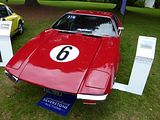

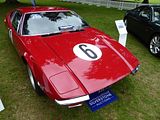
FERRARI
The Ferrari Dino was created to honour Alfredo ‘Dino’ Ferrari, Enzo Ferrari’s only legitimate son, who sadly died of muscular dystrophy in 1956. Unlike any previous road-going Ferrari, the Dino utilised a V6 engine, the Tipo 156, which Alfredo himself had helped develop and strongly advocated during his working life. Following continued motor racing success and in order to homologate Ferrari’s 1966 Formula Two campaign, a new line of mid-engined production V6 coupés with Fiat running gear went on sale in 1967 in two litre form. However, in 1969 a larger 2.4 litre Dino was introduced, named the 246 GT or GTS in the case of the Spider. Only 3,913 definitive Dinos were built before the introduction of the completely restyled V8 engined 308 in 1973. The voluptuous bodywork of the 246, which many regard as the prettiest ever to grace a road-going Ferrari, was designed by Pininfarina and built by Scaglietti. It clothed a tubular chassis which carried wishbone independent suspension at each corner. The compact four-cam, 190bhp. engine was mounted transversely above the five-speed gearbox and just ahead of the rear axle, allowing for both a comfortable cockpit and some usable boot space. This original right-hand drive matching numbers Dino, was delivered new on January the 24th, 1973 to Maranello Concessionaires Ltd. in England. It was sold by Dick Lovett for a total of £5,430.63 to the first and only registered keeper, notable classic car collector Angus Spencer-Nairn. Mr Spencer-Nairn ordered the car in the very rare colour of ‘Blu Metallic Dino’ (106.A.72) with additional options including electric windows and a beige leather interior. Following a new career opportunity, Mr Spencer-Nairn moved to Jersey and his beloved Dino came along with him on 3rd March 1975. In 1977, a D-Type Jaguar was acquired and became stable mates with the Dino, along with a number of Italian rarities. Having resided in Jersey since 1975, this Dino has not been driven many miles, in common with many cars from this small island. Consequently, the recorded mileage is only 23,301 miles from new. A decision was made approximately 20 years ago to paint chassis number 05470 and the colour was changed to Rosso Corsa. However, crucially the extremely rare leather interior was untouched during these works and, as a result, it’s highly original from the carpets to the seats and the door cards. Complete with its leather wallet as supplied, containing the warranty card, dealer booklet, manuals and even the original Ferrari duster, this Dino also boasts its period buff log books from both the UK and Jersey and these confirm the ownership record of just one from new. Further features include the original tool kit, jack and copies of the order forms from 1973. In addition, a full condition report will be made available to prospective buyers from respected marque experts Foskers, and all UK taxes have recently been paid. A 246 Dino that has covered only 23,000 miles is something very special indeed, but one that has been looked after by a single registered keeper from new is almost unheard of.
Needing little introduction here, not least as this is one several examples of the model on display at the event was this Ferrari 365 GTB/4 Daytona. Two years after Lamborghini debuted the mid-engined Miura in 1966, Ferrari launched its defiantly traditional and determinedly contrasting alternative, the 365 GTB/4. Almost immediately the 365 GTB/4 gained its ‘Daytona’ moniker from Ferrari’s 1-2-3 result in the 1967 24-hour race of the same name. The Daytona’s engine and handling certainly didn’t undermine its racing nomenclature. The 4.4-litre, 4-cam V12 produced an astonishing 352bhp and, despite its 1,633kg bulk, the Daytona was billed as the fastest road car in the world. Not only was 174mph more than brisk, but crucially, it was faster than the Miura. The 5-speed gearbox was mounted at the rear for a more optimal weight distribution, and helped give the Daytona its predictable handling and solid road-holding. Like so many Ferraris of the period, the Daytona’s beautiful bodywork was designed by Pininfarina with the car built by Scaglietti. The delicate front was cleanly cut with both pop-up and Plexiglas headlight varieties. The rear slope was suggestively rakish and a Kamm tail provided further clues as to the performance of the car. The wheel arch flares, although elegant in proportion, are the only real overt notion that this car has significant pace, until you drive one! Chassis #16447 is a left hand drive variant of the iconic Daytona and looks resplendent in its factory correct paint colour of Argento Metallizzato 106-E-1 with contrasting Black leather interior as it was in March 1973 when manufactured and subsequently sold to Mr. R. Minnick of New York. As with many Ferraris, the car has been repainted, and for a while it was red, but a bill on file in 2011 shows that this was professionally returned to its original factory colour. A lot of money has been spent in recent years, so the car apparently drives well. That was not enough to result in a sale, though.
Replacing the Daytona was the Berlinetta Boxer. The 512 BB was the second generation of the model, with a more potent 12 cylinder boxer engine used to power it. Enzo Ferrari, contrary to his engineer’s wishes, had delayed the introduction of a mid-engine car, doubting the ability of his customer base to handle this configuration. With the BB512, the capacity was increased to nearly five litres and a dry sump fitted, then with suspension changes and various modifications Ferrari was back at number one in the supercar pecking order. The competence of the 512 BB was re-iterated by the world’s motoring press as many of them proclaimed this Ferrari as the best all round Sports GT of the day in 1976. This original UK right-hand drive 1979 Ferrari 512 BB, was delivered new to Maltin Car Concessionaires Limited of Henley-on-Thames, Oxfordshire on 4th July 1979. The earliest documents in the history file show the Ferrari Modena Warranty Card, signed by Innes Ireland, and the very first service stamp shows that work was carried out on 19th September 1979. The first owner was a Mr George Williams of Norfolk, who registered the car in his company name. Despite a number of keeper changes from the company to Mr Williams, the car remained in his possession until 1995, when it was purchased by Serruys Property Company and shortly after moved to a dealer called David Wainwright of Leicestershire. He sold the car to Peter Harris Limited in 1997 and a large amount of work was carried out on the Boxer at this time. This 512 BB then found its was to a Mr Jeremy Holmes of Dinas Powys, Wales via Talacrest in January 2001. He had some work carried out by Bob Houghton in 2004, which included a full engine inspection, carburettor rebuild, cambelts, clutch, replacement of gaskets and a suspension rebuild. Between 2005 and 2014 the car was taken off the road with the intention of undertaking a full restoration, however, the project was never completed. In January 2015, chassis number 27863 was delivered to marque experts, Foskers Engineering in Kent for restorative works. Most amazingly, at this time the odometer reading was only 15,660 miles and based on a large number of previous MoT certificates and service stamps, we believe this mileage to be genuine. Recent work has included a full strip to bare metal and repaint in the original colour of Blu Dino Metallizzato. The blue over cream interior is original and has been Connolised, and the car will be fully serviced with a cambelt change prior to coming to the auction. A mere 929 512 BB models were manufactured between 1976 and 1981, of which only 101 were in right-hand drive form.
Serving as the successor to the 360 Challenge Stradale, the 430 Scuderia was unveiled by Michael Schumacher at the 2007 Frankfurt Auto Show. Designed to compete with cars like the Porsche RS and the Lamborghini Gallardo Superleggera (super light weight), it is lighter by 100 kg and more powerful, 503bhp at 8500 rpm, than the standard F430. The increased power output stems from a revised intake, re designed exhaust and an ion sensing knock detection system that allows for a higher compression ratio resulting in the weight-to-power ratio being reduced from 2.96 kg/hp to 2.5 kg/hp. In addition to the weight saving measures, the Scuderia semi automatic transmission gained an improved “Superfast” software system known as “Superfast 2”, creating faster 60 millisecond gearshift times and a new traction control system combined the F1-Trac traction and stability control with the E-Diff electronic differential. The Ferrari 430 Scuderia accelerates from 0-100 kilometres per hour in 3.6 seconds, with a top speed of 202 miles per hour (325 km/h). Ferrari claims that around their test track, Fiorano Circuit, it matches the Ferrari Enzo, and the Ferrari F430’s successor, the Ferrari 458. This left-hand drive one owner 430 Scuderia was supplied new to Dubai in 2009. The car is finished in the stunning and very rare colour, Light Azzurro, with iconic silver stripes. The car has been serviced at a Ferrari Main Dealer throughout its life and has been stored in a climate controlled garage which fully confirms the care and attention the car has enjoyed from our vendor.
This car has every option you could possibly want to enjoy the car to its fullest, although the vendor is keen to stress the launch control button has never been used! The F430 Scuderia model is rumoured to have matched an Enzo around the Mugello circuit and with the odometer now showing only 20,000 miles, this is a rare and unique opportunity to purchase a high performance Ferrari which is very competitively guided. Presented in its original colour of Grigio Medio 791 (this paint colour was offered by Ferrari in the 1950s and 60s) with an unusual interior in full Alcantara red leather, this Scuderia is, to date, the only one made by Ferrari in that exterior / interior combination. Not only that, but it has covered a mere 85km from new.
The Ferrari 250 GTE 2+2 was unveiled to the press and public at the 1960 Le Mans Vingt-Quatre Heures, and served as the Course Car during the race. It was appropriate, however, as even though this model was never designed as a competition car, the engine and chassis are based on the iconic 250 SWB, one of the most famous racing cars of all time. Although several special order 2+2s had been produced in the 1950s, this was Ferrari’s first true production 2+2 and enabled them to widen their potential market and compete directly with Aston Martin, Maserati and Facel Vega. The new 2+2 would bring for the first time, wide-scale production, with 953 examples in total, across three model variants, being produced between 1960 and 1963. It is widely recognized that fewer than half of the original GTE models have survived, as so many were adapted to recreate the California Spider and 250 SWB. The 250 GTE was built on the same chassis used for the other 250 series Coupés, with the short wheelbase of 102.3 inches being retained and the engine moved forward by 8 inches to provide room for the rear seats. Additional interior space was provided by widening the front and rear wheel track and the net result was a spacious cabin, capable of carrying two adults and two children in comfort for extended periods of time. The model was powered by the mighty 3-litre V12 engine designed by Gioacchino Colombo, a power unit that proved to be resilient and flexible whilst providing an incredible soundtrack, magnifying the whole driving experience. Styled by Pininfarina, the 250 GTE succeeded in enhancing Ferrari’s reputation as film stars, business tycoons and celebrities, such as Frank Sinatra were proud to take ownership and naturally never missed a photo opportunity with the latest example of Italian exotica. Chassis number 03823 GT was completed by the Ferrari factory in 1962, and delivered to the French market dealer Franco Brittanic Automobiles, to be presented at the 1962 Paris Motor Show. The car is featured in the 1962 Ferrari Year Book with pictures in the history file of it gleaming on the show stand. The original build sheet showed this car was finished in Celeste with a Beige hide interior, and it retains this same colour combination today with faithfully matched specifications. At the end of 1962, this 250 GTE was sold to its first owner, Monsieur M. Delle Siede, and registered 930 HB 51 as an early Christmas present on 19th of December. It passed through a further three keepers until surfacing in the 1990s in Lille, registered to a Monsieur M.Cleton. At the end of 1992, it was acquired by a Ferrari dealer in Lille and he refurbished the car and kept it for 15 years as part of his private collection. In 2006, it was sold to the previous owner, who commissioned a large amount of work between 2007 and 2013, including a full rebuild of the engine and transmission by respected Ferrari specialists Garage V12 Automobiles, and there are bills in the history file totalling €22,800. Additional work included a rear axle rebuild, refurbishment of the Borrani wheels and a new Orbisoud stainless steel exhaust system, making this V12 thoroughbred sound absolutely sensational. Purchased by the current vendor in France in 2013, he brought the car back to the UK and immediately set about cosmetically restoring this wonderful Ferrari. The bodywork was completely taken back to bare metal, which proved to be exceptionally sound and there are pictures in the history file documenting this entire process including pictures of the car stripped of its paint, then beautifully finished by respected specialists and returned to its original colour of Celeste 19321, as detailed in the Maranello Archive. The hide interior was painstakingly sourced from UK Hide, who faithfully produced the same Connolly leather, hand finished to match period quality. Most of the chrome work was re plated and polished to a very high standard. When the car was stripped down, it was also discovered that the body number (242) is stamped on all splash guards, A-post trims, rear quarter trims, rear seats and the glove box light cover, which have all been photographically recorded.
The Ferrari 330 GT 2+2 Series I made its debut at the Brussels Salon in January 1964, proceeding its earlier ‘250 2+2 GTE’ and ‘330 America’ cousins. The ‘Series I’ was much more than a re-engined 250, it was a bolder, more distinctive incarnation in both looks and performance. Pininfarina was once again entrusted with the styling, their vision of Ferrari’s evolution drew muse from the cars’ predecessors, yet included some more daring design elements. A sharper nose and tail, a wide grille, and the espousal of a characteristic quad headlight arrangement, all of which reflected the tastes of Ferrari’s most important export market, the USA. Although some criticised its styling, the ‘Series I’ four-headlight 330GT has become truly evocative of 1960’s fashion, lauded both for its individuality and Pininfarina’s purity of design. The fantastic Gioacchino Colombo designed high output V-12 engine was fitted to all 300GT series and produced an impressive 300bhp, adorned with triple Weber carburettors, this combination taking the vehicle from 0-100km in an astounding 6.3 seconds, making it the fastest road going Ferrari of the time. The example here today was manufactured we believe in 1964, and was sold to its second owner who lived in California in 1989. In 1994 the car returned to Europe and has lived in Denmark with six owners up until now. There is a photographic record with the car of a total frame-off restoration in, undertaken in 1992-93.
Firmly placed in Ferrari’s history as one of their finest big GTs, the 550 Maranello’s combination of stylish Pininfarina lines and front mounted 12-cylinder engine meant this car had the potential to become an instant classic, following in the footsteps of its forebear, the 365 GTB/4 ‘Daytona’. With modern styling cues, a 5.5 litre V12 engine producing around 485bhp and a reported top speed of 199mph, the 550 Maranello was a serious motor car. A less frenetic power delivery, the six speed manual box and excellent weight distribution were all factors in the 550 becoming the perfect European Grand Tourer. Offered here was a UK supplied RHD Ferrari 550 Maranello finished in Argento Nurburgring with Bordeaux Red leather, red carpets and black dashboard. It’s mileage of approximately 43,500 miles is substantiated by a very comprehensive service and maintenance record compiled by its six previous owners. It sold for £110,000, a lot more money than the estimate of £60,000 suggesting the days of bargain priced 550s are over.
The 308 GTB was launched at the Paris Motor Show in 1975 as a direct replacement for the Dino 246. Designed by Pininfarina with sweeping curves and aggressive lines, the 308 has gone on to become one of the most recognised Ferraris of all time. Fitted with a 2.9 litre DOHC V8 engine fed by four Webber 40DCNF Carburettors, the power output of 255bhp was sufficient to propel the 308 from 0 to 60mph in 6.5 seconds and on to a top speed of 159 mph. In 1980, the decision was taken to replace the carburettors with fuel injection, unfortunately reducing the engine output from 255 to 214 bhp, however two years later, an extra couple of valves per cylinder were added, giving “Quattrovalvole” models around 240bhp. The 308 was manufactured in both GTB and GTS (Spyder) forms from 1977 to 1985, before being replaced by the 328. In hindsight, amongst enthusiasts of the 308, the version to have is an early steel bodied car with a dry sump and carburettors, which is exactly what was on offer here. Manufactured in 1979, this original UK, right hand drive car has covered a genuine 28,870 miles. It was first registered to Cooper Car Sales Ltd in Leicester on the 5th.of April 1979, and has subsequently had five keepers, two of which were dealers. Sold to Mr George Knight on the 22nd April 1981, he went on to keep the car for 13 years until it was purchased by H J Marshall, a precision engineer from Manchester. Over the next 20 years, ‘HWW 54T’ became a labour of love as a complete re-build was undertaken with the owner even building a new garage in which to carry out the work! In 2013 the love affair was over. The car at this stage was 95% complete including a new interior, bare metal respray, new suspension and brakes. The respected Ferrari specialists ‘QV London’ were commissioned to complete the final stages in May 2014, including a 6000 mile service, the obligatory belts and tensioners, all fluids and a steering and suspension nut and bolt check.
ISO
Surprisingly, perhaps, this Grifo 7 litre did not sell. The prototype ‘Grifo A3/L’ was revealed at the Turin show in 1963 to overwhelming approval. First production Iso Grifo’s followed and all used reassembled and blueprinted Chevrolet Corvette 5.4 litre engines until a 7.0 litre option was introduced in 1968. The larger engined cars were distinguished by some detail modifications, such as a “subtle” bonnet scoop, necessary to accommodate the taller engine and a black band across the rear roof pillar. 322 Series I Grifos were produced before the design received a facelift in 1972 after which time a further 78 (Series II) Grifo’s were built. In total 90 Grifos were specified in seven-litre form, with only four being built in right-hand drive. The 7 litre cars had a 454 cubic inch Chevrolet V8 engine, and following a rebuild, this car recorded dynamometer results of 490bhp at 5,500rpm. The engine is mated to a modern Tremec TKO600 five-speed gearbox capable of handling this mighty power house. This particular Iso Grifo featured on the stand at the 1968 Earls Court Show, and is one of the four right-hand drive, super-rare, seven litre Grifos built. Owned for 28 years by the same fastidious owner who is also regarded as a UK authority on Iso and Bizzarrini cars, this particular car is naturally well published and its history very well documented. The black leather interior is mostly original and beautifully patinated and the wheels are Campagnolo Elektron with the correct magnesium alloy centre spinners. High profile awards for the car, include a First in Class trophy for ‘Best of Both Worlds’ in the Cartier Style et Luxe at the Goodwood Festival of Speed in 2004. The car has covered 72,000 miles from new.
JAGUAR
The XKSS was produced following the decision made by Jaguar to pull out of all motorsport at the end of 1955. Sir William Lyons converted their 16 remaining ‘D-Types’ to road going specification for the American market, by adding a passenger door, a full-width windscreen and wipers, an exhaust heat shield, side-screens, a folding roof, bumpers all round, a luggage rack and rear light clusters. It was to become a complete icon of the era, an outstanding and good looking car driven by the privileged few, including movie stars of the day such as Steve McQueen. Values of the original cars range from £8-£10 million today, if you can find one. This is not one of them. Rather, it is a Lynx version. Highly respected Lynx Motor Cars was founded in 1968, and quickly made its name restoring and maintaining original C-Types, D-Types and E-Types of the period. Their decision to recreate D-Types and XKSS versions based on Series II E-Type engines and running gear was a logical one, based entirely on their experience with the original cars. Since then over 430 cars have passed through their workshops, either as recreation projects or original cars being restored or maintained. They have built ten XKSS versions over the years, of which only three (including this one) have been left-hand drive. Their cars are bespoke and only made to order, making this a very special and rare opportunity. Based on a 1969 4.2 Series II E-Type suspension, brakes, engine and gearbox, the car was completed in 2015 having been converted to full XKSS specification. It is registered as a 1969 Jaguar XKE under German Historic TUV papers and converted to XKSS specification by Lynx Motors International Ltd. Finished in Jaguar Gloss Black with complementing Jaguar Red leather interior the car is built on an aluminium monocoque with hand rolled aluminium panels, a rebuilt XK 4.2 litre, six cylinder wet sump engine utilising double ‘fast road’ specification camshafts, a ported and flowed cylinder head and triple 45 DCOE Weber carburettors:- producing 270bhp at 4,500 RPM. A Getrag five-speed box delivers all the power smoothly and having just a few test miles under its belt, comes to the sale with a 12 month Lynx warranty, from which the privileged first owner will benefit. Equipped with a full-width screen, Dunlop 16″ wheels with spinners, authentic D-Type instruments and switch gear, Steve McQueen specification XKSS seat cushions and glove box hatch, a detachable steering wheel, Monza-style fuel cap, seat belts, stainless steel luggage carrier, removable side screens, black hood and authentic under bonnet detailing.
The XK120 was launched in 1948 and was an international sensation. The XK finally put Jaguar on the world stage and the racing derivatives would see the beginning of a hugely successful period for the company. The XK150 was the final incarnation of the XK and it appeared in May 1957. A more refined and capable machine than its predecessors, the 150 was easily identifiable by its higher scuttle and door line, wider grille and improved interior space. However, the XK150 retained much of the mechanical layout of the XK140 including the same 3.4 litre DOHC Jaguar straight-six, which developed 180bhp at 5,750rpm. As before with the XK range, standard (with steel wheels) and special equipment models were available, but a bewildering range of models was to evolve. Firstly, in 1958, the ‘S’ model was announced, equipped to ‘special equipment’ specification and with a more powerful engine, though still of 3.4 litre capacity. Late in 1959 further options became available with the introduction of the 3.8 litre engine and the XK150 was available not only as a 3.4 litre, but two versions (Normal and “S”) of the 3.8 variety. The car seen here is a left-hand drive XK150S and it is recorded as having been built at Browns Lane on the 8th October, 1958 and was shipped to its new owner, Mr R.A.Leftwich in the USA in November of that year. Its most recent owner was a lucky Dane by the name of Jorgen Anderson Stoffer who was its custodian from 2008 until 2015. Fitted with a manual gearbox with overdrive, this 1958 Open Two Seater, 3.4S is finished in gleaming Old English white with dark blue leather, matching carpets and a dark blue hood, and a rare set of matching blue leather Jaguar suitcases fit snugly in the boot.
Introduced in 3.8 litre form in May 1961, the Jaguar E-Type caused a major sensation when it first appeared, with classic smooth lines, great looks and an amazing, at the time,top speed of 150 mph. With 265 bhp and a huge weight saving of over 500lbs on its immediate predecessor (the XK 150), William Lyons had created one of the all-time most beautiful cars ever to be produced by Jaguar. The first evolution was the introduction of the 4.2 litre engine, fully synchronised gearbox and greater legroom to accommodate six foot plus drivers. This is often regarded as the ultimate driving E-type, and even now a well sorted example is a sensational driving experience with a sense of occasion that’s hard to replicate at any price in a classic car. Seen here is a 1965 manufactured Jaguar 4.2 FHC, that was despatched from the factory at Browns Lane to their nearest dealer, S.H. Newsome of Coventry. Originally finished in Primrose Yellow, the first owner was C.J. Bee & Co. and the history file shows that it has had only three owners prior to our vendor. It seems that the cylinder block was replaced early in its life but with the correct 7E engine number sequence. The car also sports a later Series II bonnet which is believed to have been a replacement, as the earlier production date precludes it being a Series 1.5.
LAMBORGHINI
In January 1990, Automobili Lamborghini S.p.A. introduced their latest mid-engined, high performance sports car, and carrying on their tradition of naming its cars after legendary fighting bulls, chose a ferocious example raised by the Duke of Veragua in the 19th century known as “Diablo”. Prior to its introduction, the sharp and dramatic lines of the Marcello Gandini design were somewhat softened by the pen of Tom Gale and his presentation of the car opened to rave reviews. The two door, rear wheel drive, mid-engined coupe was powered by a 5.7 ltr, V12 and about 490 horses found their way to the tarmac through a 5-speed manual transmission, resulting in a 0-60 time of 4.5 seconds and a top speed of 202 mph. The car seen here is a 1998 Diablo SV. This was the first time since the Miura Super Veloce that these initials had been used and this model differed from earlier Diablos having an increased power output of 510bhp, larger front brakes, an adjustable spoiler and three piece wheels. This car is an extremely high specification SV finished in Blue Scuro with Snowcorn hide, and is believed to be one of only three 1998 cars in this combination. It is fitted, from the factory with SE30/Monterey Edition side skirts and rear bumper, colour coded adjustable rear spoiler, carbon fibre rear light surrounds and dual fog lamps. Currently, the car has a sports exhaust fitted but the original catalytic converters are available. The interior of the car is equally impressive and is trimmed in factory correct half leather and half Alcantara. Most of the trim is now carbon fibre including the door sills, centre console, steering wheel cowl and dash surround and the vehicle is fitted with a Focal Audio sound system with a navigation package. First delivered to Lamborghini GB on the 3rd of January, 1998, it was main dealer maintained for the first two services and has since been looked after by Lamborghini specialists Carrera Sport, and there are service invoices with the car for every year from 2001 until March 2015.
LANCIA
Designed in 1949 by Vittorio Jano, and unveiled in 1950 to a nation slowly recovering from a World War, the Lancia Aurelia was very simply, revolutionary. The car combined luxury, performance, looks and charisma, and offered a dream to a nation just finding their way. The Aurelia bristled with firsts: the first V6 production engine, transaxle, inboard rear brakes, monocoque construction and a very efficient slippery shape. In a country in love with motor sport it’s no surprise that the Aurelia was immediately seized upon by wealthy Italian privateers, and achieved almost instant success in competition throughout Europe starting with a second place in the 1951 Mille Miglia in virtually standard form. The model went on to be developed over almost 8 years and six distinct Series and were bought by wealthy discreet Italians and those in the know throughout Europe. Seen here is a 4th Series car, available from 1954, which differed from earlier models mainly in the introduction of de Dion tube rear suspension, further improving an already great handling car. This is a right hand drive Series 4 GT2500 B20 with the later suspension and a 2.5 litre, V6 producing 118hp, and is one of 573 built during 1954. Its first registered owner was Douglas Abercrombie from Essex and he was followed by 3 more UK owners. The car was then imported to Holland in 1996 where it has spent the last 20 years.
MERCEDES
Another car which did not sell was this 1960 220 SE “Ponton” Convertible. The term “Ponton” (meaning Pontoon shaped) is actually a stylistic description of a modern vehicle body, and is commonly thought to be post-war, but was frequently used as a colloquial description of some early Bugatti models, particularly the Type 32. The term came into daily usage when it was applied to a number of Mercedes-Benz models produced from the mid-fifties until the early 60s. However it is the W180, and particularly the elegant W180 Cabriolet that people normally envisage when the word is mentioned. The 1960 220SE Cabriolet was the last in the line of the “Ponton” models and in SE form introduced an early form of Bosch mechanical fuel injection. Only 26 were made in right hand drive Cabriolet form, so consequently they are very rare. This car has been restored by Thornley Kelham from Cirencester, and a number of usability modifications were made, such as swapping the column change for a modern six speed BMW gearbox. It is the same one as they showed on their own stand at Wilton House back in June.
Introduced in 1959, the Mercedes-Benz W111 chassis remained in production until 1971 and was manufactured in parallel with a number of other designs including the W108. Cabriolets were available in three engine sizes from ’61 until ’71 with the 250SE Cabriolet being sold from late 1965 until the end of 1967. Powered by a 2.5-litre straight six, the 250SE was fitted with Bosch fuel injection and produced nearly 150bhp, whilst married to a 4-speed automatic transmission, giving it a top speed of around 118mph. Aimed squarely at those discerning customers who enjoyed the occasional wind in the hair driving experience, but needed 4 seats and a little luxury, the stylish 250SE Cabriolet was the car of choice. Seen here is an original 1966, right-hand drive, 250SE Cabriolet from new, supplied to Assa Yazbeck & Sons Ltd of Freetown, Sierra Leone. This well-travelled car also spent some time in South Africa before finding its way to Northern Ireland under the ownership of a Mr John Rogers of County Down and then into the hands of a Mr Rumbles in London prior to being purchased by our vendor in 2009. Upon purchase, he decided this beautiful cabriolet deserved a full restoration, and sent the car to well-known Mercedes-Benz specialists Colin Ferns Ltd. who spent the next two years carefully going through it. The car was resprayed in Mercedes-Benz Blau 940 and the interior trimmed in a light red leather by Matthew Turton at coach trimmers Strong & Turton Ltd. All brightwork was re-chromed, both inside and out, ensuring the car sparkles and the hood was replaced with a new Mercedes-Benz original part. Bills contained in the history file from Colin Ferns total more than £20,000.
Launched in 1963 to replace the underpowered 190SL and utilising some of the new manufacturing techniques being adopted in the emerging S Class, the Paul Bracq designed 230SL was proudly unveiled to an appreciative audience at the Geneva Motor Show. Remaining in production until 1971 with around 49,000 finding customers, the W113 Class, frequently referred to as the Pagoda, eventually spanned three engine sizes. Mercedes-Benz Chief Engineer Rudolf Uhlenhaut, who was as competent behind the wheel as most racing drivers, demonstrated the handling capabilities of the 230SL on a tight, short test track near Montreux in 1963, where he put up a best lap that out-performed the Ferrari 250GT. The car seen here is a UK supplied, right hand drive, restored Mercedes 230SL finished in Arctic White with red trim. The extensive restoration was conducted by Malin Motor Bodies of Sheffield and included a full re-trim of the interior. At some stage in its life, the 230 engine was replaced with the 6 cylinder 250 engine and this was a common upgrade in period giving the SL a much needed ‘shot in the arm’ in terms of performance. The car sold for £58,000.
PORSCHE
£58,000 was required to secure this 1960 Porsche 356 B T5. The 356 is acknowledged as Porsche’s first venture into production, and was a lightweight and nimble rear engined, rear-wheel-drive, 2-door sporting car available in hardtop coupe and open configurations. Engineering and design innovations continued during the years of manufacture, contributing to its motorsports success and its popularity as a road car. The model was created by Ferdinand “Ferry” Porsche (son of Dr. Ing. Ferdinand Porsche, founder of the company), based on an original design by Porsche employee Erwin Komenda, and initially its mechanicals (including engine, suspension and chassis) were derived from the basic Volkswagen Beetle, a product of his Father’s fertile imagination. Porsche continued to develop and refine the 356 with a focus on performance, and by the late 1950s fewer parts were shared with its pedestrian cousin, and increasing success in competition and its availability worldwide resulted in the distinctive little car, in all its iterations, finding over 76,000 homes between 1948 and 1966. This beautiful 1960, LHD matching numbers example was initially registered in California to a lady, who was the first of, it is believed, four owners. After six years, it passed to its second keeper who owned the car for over forty years with the last twenty being in storage. The Porsche continued to enjoy the sunshine, as its third owner lived in Texas which is where it was found by the current owner who moved it to Florida and used it frequently at his holiday home before deciding to bring the car back to the UK. On arrival, it was given a full restoration. The car has still only covered 58,000 miles from new.
There were several 911 based models offered, of which this was the most recent. The Porsche 911 GT3 RS 4.0 was launched in 2011, and was the final development of the track-inspired series of 997 GT3 RS models. Only 600 examples were made and it was the last hurrah for the motorsport-derived Mezger flat-six that was bored out from 3.8 to 4.0 litres, the largest displacement 911 engine ever. The normally aspirated power plant was crucially mated to a 6-speed manual transmission and achieved 494bhp at 8,250rpm. The 4.0 RS is considered by many to be one of the greatest drivers’ cars of all time and according to EVO Magazine when the car was released: “It is the ultimate 911, and you could easily argue it’s all the car you’ll ever need. It will become an icon.” This very special, left-hand drive, 4.0 Litre GT3 RS was supplied by the Porsche Centre Syd in Sweden to C09 specification and is number 387 of 600 cars built. It has covered only 3,900 miles from new and has had only 1 owner. The ECU data from the car has been checked, verified and is exemplary. There are no signs of over revs in any of the ranges and the operating hours and distances also match perfectly. The car has never been used on the track and it is presented in superb condition throughout. Finished in Carrera White with grey decals and black leather/alcantara interior, this beautiful example was ordered with the following factory specification: half factory cage (painted white), five-point harnesses, Porsche CDR30 Radio, one-piece carbon Carrera GT bucket seats, dynamic engine mounts, Sports Chrono package, 19” Centre locking wheels, cruise control, air conditioning, tyre pressure monitoring, Porsche Active Suspension Management, Porsche Stability Management, Alcantara roof lining, carbon dash trim, door entry guards in Carbon, Guards Red seatbelts, on-board computer, Electric and heated door mirrors, Xenon lighting system, CD compartment and a 90 litre fuel tank.
There was a 911 GT3 parked up as well, but this does not appear to have been part of the Auction.
£315,000 would have been required to secure this 911 GT2. The prospect of combining the most powerful turbo engine in their range at the time with a manual gearbox, and mounting them in a rear-wheel drive lightweight 911 was the inspiration for the rather special, GT2. Simultaneously Porsche would upgrade and modify the suspension and brakes, increase the engine output and extensively lighten the car, to create the ultimate driver’s version of the current model at that point. This recipe has been used, to great effect, with the 993, 996 and 997 versions of their iconic 911. This car is the 997 GT2 RS version which was introduced in May 2010, and is one of just 500 produced worldwide. The 3.6 litre engine uses twin variable-geometry water cooled turbochargers to produce a serious 620bhp and 516 lb/feet of torque through a six-speed manual transmission, leading to a maximum speed in excess of 205mph and a 0-60mph time of just 3.4 seconds! In simple terms, it is the most powerful, road legal 911 ever manufactured. Stopping power, with big Porsche Composite Ceramic Brakes, is equally impressive. Supplied new in 2010 by Porsche Centre Reading, this C16 GT2 RS is 1 of only 16 cars supplied to the UK and was specified with the ‘Black and Red Club Sport’ package. Additional factory options included: full Porsche satellite navigation, an iPod dock, tyre pressure monitor, grey tinted windows, a full Chrono plus package, five-point seat belts, electric windows and air conditioning. A little over 2,000 miles have been covered since new, and as one might expect, this Porsche is presented in superb condition. Externally, the 911 GT2 RS stands out clearly from the other 911 models through the lavish use of carbon-fibre reinforced components with a matt black surface finish. The interior of the 911 GT2 RS also exudes sporting intent in virtually every detail. Lightweight two-piece bucket seats made of carbon-fibre reinforced plastic, are standard, as are lightweight door panels with fabric straps instead of traditional door handles. The basic interior colour is black, which contrasts dramatically with red elements, such as the seat centre sections, the roof lining and segments of the steering wheel rim. The gear lever and handbrake are also finished in red Alcantara.
The Porsche 911 Carrera 2.7 MFI (mechanical fuel injection) model was built for all markets, except for the United States and used the 210hp engine from the 1973 Carrera RS, making them mechanically identical. Introduced in 1974 on the new G-Series chassis, the floor pans were strengthened, lighting was improved and larger bumpers were incorporated. With the proven 210bhp, 2,687cc air-cooled horizontally opposed six-cylinder engine on Bosch injection, 0-60mph was achieved in just over 5 seconds and the car was geared for 150mph through its 5-speed manual transmission. The suspension was fully independent with torsion bars, McPherson struts and anti-roll bars. The total weight was just over 1,075 kilograms, which made the Euro-spec 2.7 MFI a very fast car in its day. In fact, it was the fastest production 911 until the late 1980s. This is one of only six UK model Carrera MFI Targa’s, making it a very rare Porsche. The Certificate of Authenticity confirms that it was supplied to Porsche Cars Great Britain with amongst other options, front and rear spoilers. First registered on November 15th 1974, the registration document shows six owners although interestingly, two are from the same family and two are the same owner who registered the car both here in the UK and in Ireland, so effectively its only had four keepers. Chassis #0050 is an excellent survivor and is matching numbers, with a recorded genuine mileage of 80,084 miles. The Targa retains its original option 1975 ‘’whale tail’’ spoiler, original Fuchs 7& 8 X 15 inch alloys and thicker grip steering wheel. In 1995 at 61,558 miles, the engine was rebuilt and a full restoration began with further mechanical reconditioning. Photos of this work are included in the history file along with the relevant invoices. The restoration included refinishing the car in Guards Red, from its original Gemini Blue Metallic.
Oldest of the 911s offered was a 1972 911T. Coming of age at the beginning of the seventies, with wins at the Daytona 24hrs and the Targa Florio, the 911 has a motor sport pedigree that stretches over its 50 year life, and the cars have never stopped winning on track, while the distinctive shape soon became familiar on the road as well. For 1972 the 911( E series) had two major revisions, the most significant being an increase in capacity to 2341cc (known as the 2.4 litre) but remained on carburettors, and externally an aggressive new front spoiler was incorporated below the bumper. For just one year of production in 1972, the engine oil filler was mounted on the right hand side rear wing. The car seen here is a beautifully restored, matching numbers Porsche 911T finished in its original colour of Light Yellow (6262) that was originally supplied in 1972 by Porsche AG to Hamburg in Germany. Optional equipment specified at the time included, 6×15 Fuchs wheels, front and rear roll bars, Porsche black script on the sides, a leather steering wheel and tinted windows. It came to the UK in 1982 and has had six previous keepers. In 2012 it was fully restored, and the history file contains the most comprehensive sequence of photos that we have ever seen of any restoration process. Fully dismantled, the body shell was prepared to a very high level, and as the restoration took place, every component was either replaced or refurbished and photographed prior to fitting up. Proof that people can spend a lot of money on a car comes if you look at a detailed account of the expenditure on this one, with the total an eye watering £91,920.
ROLLS ROYCE
Introduced 2 years ago at the Geneva Motor Show and first available early in 2014, the Wraith is a four seater, two door Coupe, based on the chassis of the Rolls-Royce Ghost. It is fitted with the new ZF 8 speed gearbox, which broke new technological ground at the time as it had the ability to read the road ahead and select lower ratios for hills and steep bends. The 6.6 litre, twin turbo engine has an output of 623bhp, which is ‘more than adequate’ for 0-60mph in 4.4 seconds and a top speed of 186mph. It is, in fact, the most powerful Rolls-Royce of all time. Delivered new by Rybrook Rolls-Royce, this UK car was first registered on 30-5-2014 and has completed just under 3,500 miles from new. The car was ordered in a very smart combination of Lazuli Blue with a special two-tone tan leather upholstery. It features a number of factory fitted options, and invoice on file confirms that the total cost on delivery was £253,217.
Dating from 1964 was this Series 3 Silver Cloud Convertible. The Silver Cloud was introduced in 1955 and was, with its later iterations the Cloud II and III, to prove the core of Rolls-Royce production until the arrival of the monocoque Silver Shadow in 1966. Construction of all Cloud models was body-on-frame, which allowed a number of creative coach-builders to work their magic, but over the course of its eleven years of production the vast majority were built with the standard Pressed Steel shell. The Silver Cloud III was the final version and deliveries to customers commenced in mid 1963. External dimensions were slightly altered with a one and a half inch reduction in grille height and by necessity, a slightly more sloping bonnet, but the most distinctive difference was the grouping of the headlights in a four headlamp unit which was sufficiently attractive to be carried over to the new Shadow. The car’s weight was reduced by over 100kg, and performance was improved by fitting 2″ SU carburettors and increasing the compression ratio to 9:1. One of the respected coach-builders who created something different on the Cloud III chassis was H.J.Mulliner (later Mulliner Park Ward), who offered a supremely elegant two door Drophead Coupe. These cars are now very sought after and few and far between. This car is finished in a deep Mason Black and is trimmed in superb red hide with red carpets, and an expanse of Burr Walnut covers the dashboard, door cappings and occasional tables. The hood is electrically operated and formed from lined mohair, and when it’s fully open, the outline of the car is maintained by a cover that fits neatly over the top and is held in place by a number of fasteners. The engine bay and under bonnet panels are painted a gloss deep cream, and the view is of a gleaming amalgam of gloss black, chrome and polished steel.
IN THE CAR PARK
An event like this is bound to attract all manner of interesting cars in the car park. Sadly, I have very little to report on what was parked up, as I arrived, early just as the gates were about to open, and I left after the event closed, by which time the public car park was largely empty. So I took pictures of precisely one car: a Lancia Thema.
The organisers declared the 2015 event, in its new location, to be the most successful ever in the 10 year history of the Salon Privé . Visitor numbers exceeded 11,000 visitors over the 3 days, though it never felt crowded. I certainly enjoyed my day at Salon Privé. It is an expensive day out. The costliest event of the year, and if the budget is tight, you would have to concede that there are other events with far more cars to see for far less money. But to look at it in those terms would be rather to miss the point. Salon Privé was always supposed to be an exclusive event, and “exclusive” is a synonym for “expensive” these days. For your money, you do get to see some fabulous cars, and you get some excellent food and drink (shame I had to drive there!) included, and the event never got that crowded, so the ticket price does deter the hordes. The organisers have already announced that the 11th Salon Privé will take place at Blenheim Palace again. Save your pennies now, and put the date in the diary!

